Pena Palace is one of those destinations which seems too magical to believe it’s real. Atop the Sintra hills, the golden walls, blue tile and red-painted exterior of the palace begin to emerge from the abundant greenery below. Seeing this palace in real life is nothing like seeing the pictures. I really don’t think they can do it justice. There is something about walking up those cobblestone steps which makes you feel like you’re walking into a fairytale. Yet, you can smell the flowers and touch those ethereal details.
If you’re anywhere close to Sintra in your travels through Portugal, don’t miss out on visiting this fantastic place. This guide can be used both in conjunction with my ‘Day Trip to Sintra Guide,’ or if you’re just interested in visiting this one castle, it’s a great in-depth walkthrough of all the different historical details and artistic aspects of the Palace and Gardens.
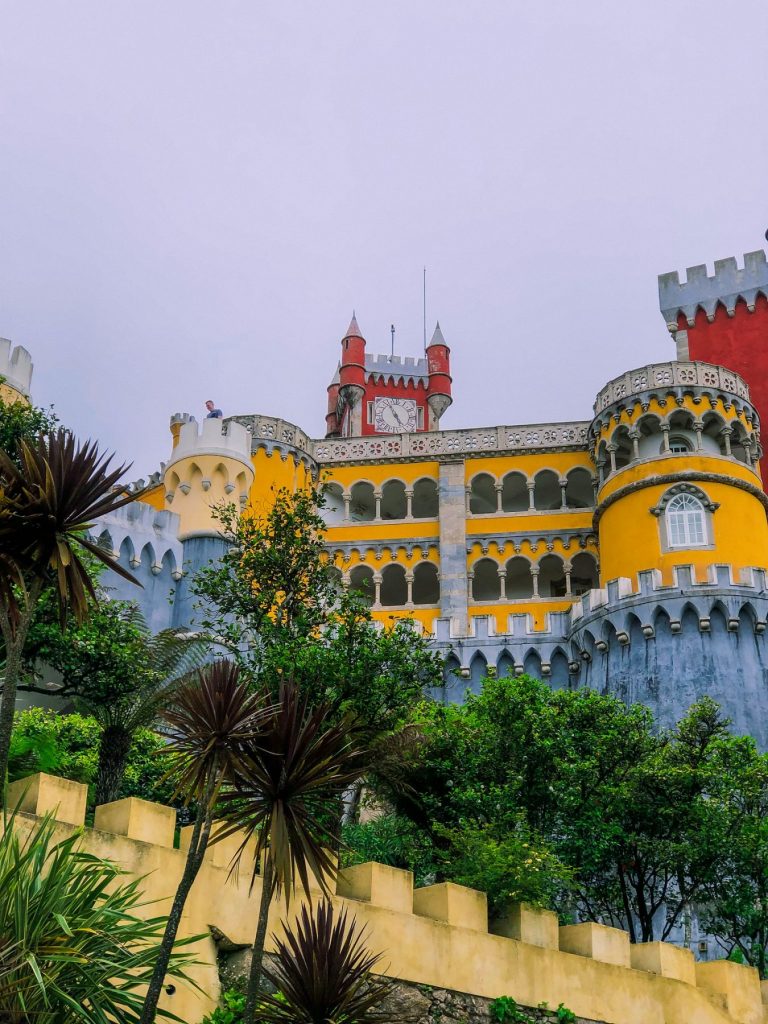
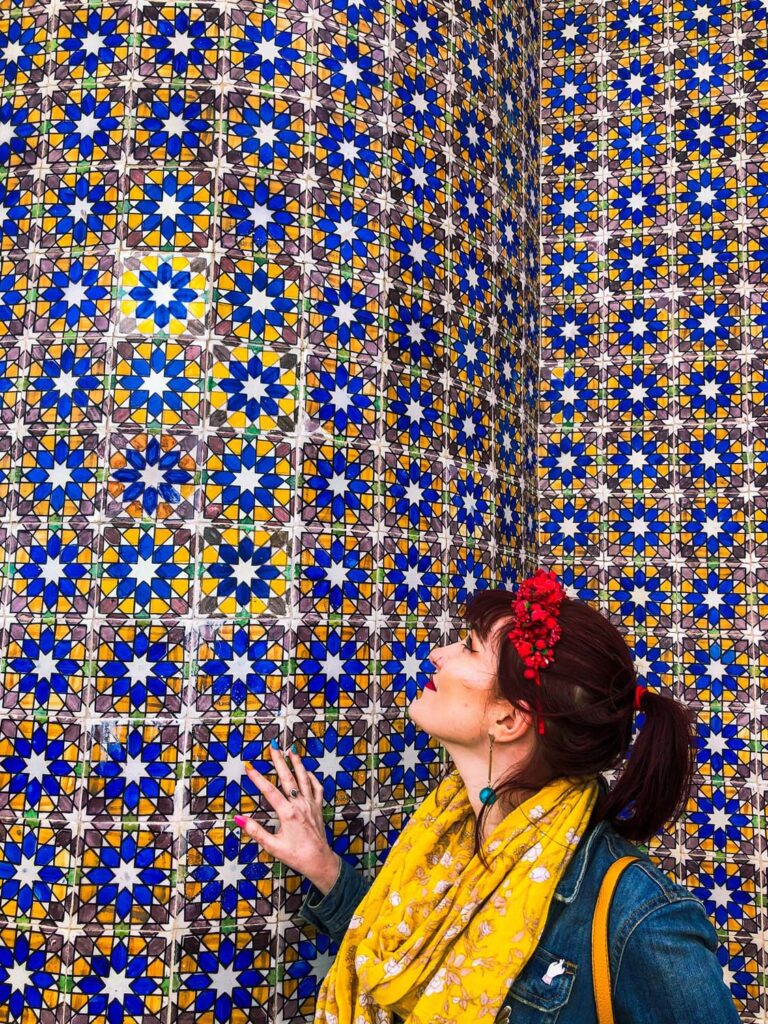
How to Get to Sintra
Sintra is easily accessible from Lisbon by trains leaving from Rossio station. The trip requires no transfers and takes around 40 minutes. The round-trip journey costs just 4.50€, making it one of the most cost-efficient day trips. While trains are out to Sintra almost every 40 minutes, I highly recommend getting the train before 8 am. The train schedule changes slightly throughout the year, so I didn’t want to give you an exact time but leaving before 8 am means you’ll arrive before 9 am giving yourself plenty of time to get to your first destination with some time to spare before it opens.
Sintra seems to explode with tourist buses as the morning wears on, so early really pays off. Any chance of being tired is worth it for the experience of arriving at Pena Palace without having to wait in huge lines and fight the enormous crowds to see what’s around you. Also, have a metro card loaded with funds to tap on and off the train or buy your train tickets in advance. Even super early in the morning, there was a lineup at the ticket counter. We were happy to have our pre-loaded metro cards, which meant we could just tap right on them, ensuring we made it onto the train in time. It was surprising how critical those few minutes were in the outcome of our day.
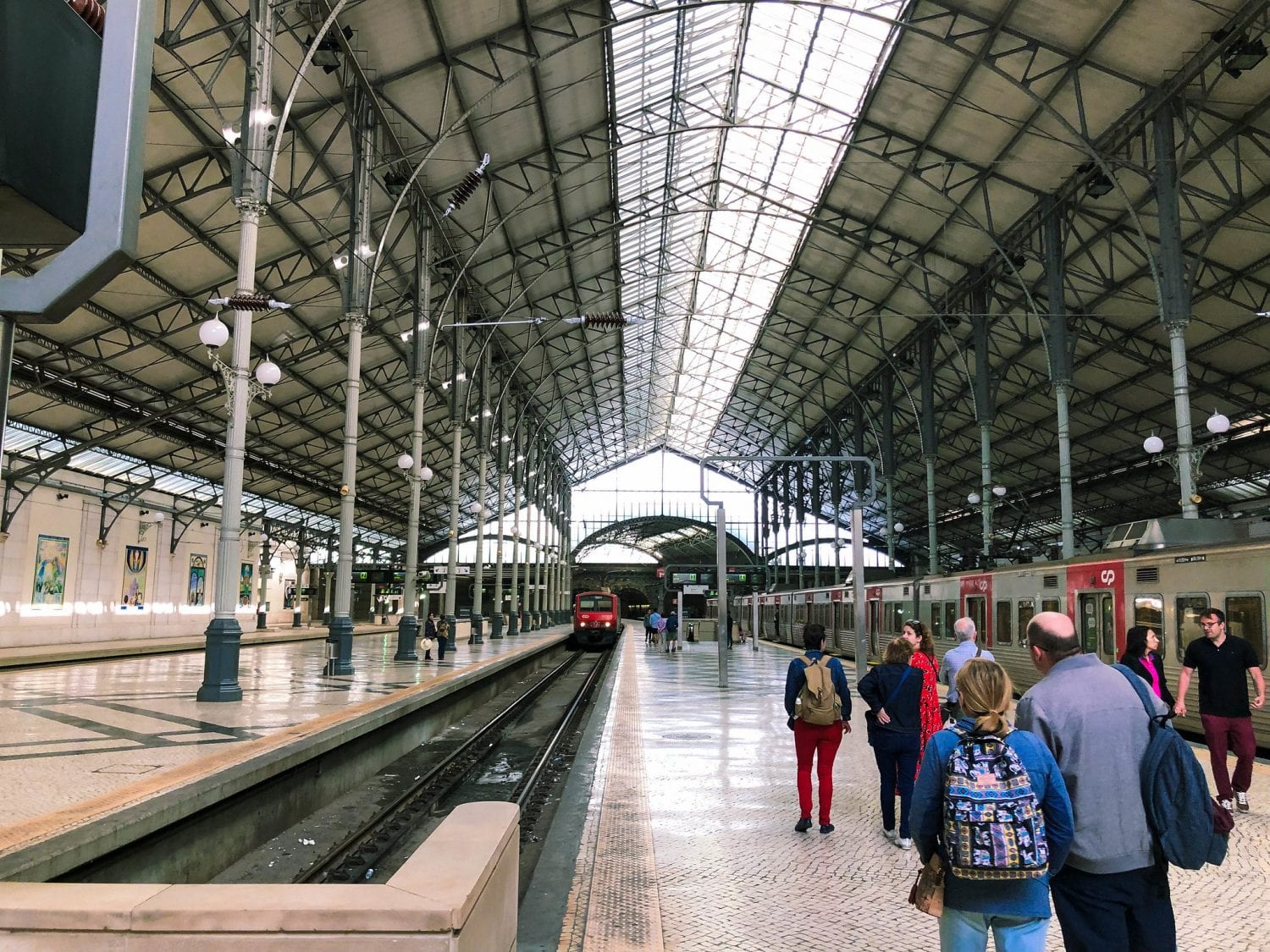
When to Visit Pena Palace
Pena Palace is always busy. Yes, the winter will most likely be the least busy, but it’s also chilly and can be a bit grey. Since most of the things to see are outside, it’s not always the most comfortable time to explore. The height of the summer holidays is equally as miserable but instead because of the intense heat and crowds. Springtime is the happy medium of pleasant weather and medium crowds. Monday-Thursday is reliably the best chance you’ll have to see a small reduction in groups. Avoid holidays when possible as these bring in the Portuguese tourists. As mentioned before the earlier in the morning you arrive, the better chance you’ll have at beating the bus tours, which are the most significant crowd control issue.
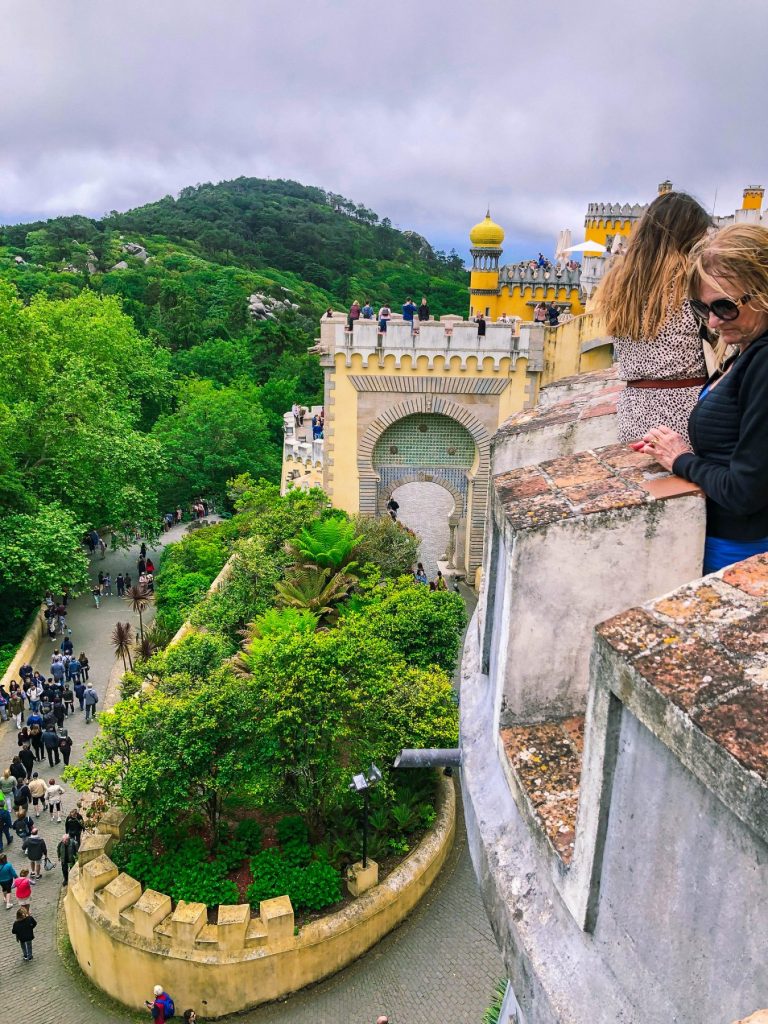
Access, Hours & Admission
There are two (well three) options for getting to the palace. The first is to take the public buses which are located right outside Sintra Station. The bus to take is #434, which services Pena Palace. This bus tends to have pretty big lines up at the train station stop since everyone getting on needs to purchase their day ticket, and that slows things down and bit. But once you have your pass, it’s super easy to jump on and off throughout the day. Tickets for this bus cost 5€ for a 24-hour pass.
Taking an Uber
The second option is jumping in an Uber. Ubers are a great way to get around Sintra but be warned that because some of the streets are one way, up a long and winding hill, some drivers might take a while to get to you or might cancel frequently. The Uber ride from the train station to Pena Palace is around 6€ depending on the time of day and the weather. If you’re travelling with 3 or 4 people, Uber can really save you some money, and if there is a big line up for the bus, it can save you some time as well. If you haven’t used Uber before, download the app and use my referral code rds9f to get $5 off your first ride!
Walking to the Castle
The third option is to walk. Walking from the train station to Pena Palace is a pretty long journey, but if you’re keen to do some hiking, this is a great opportunity. Just leave yourself some extra time to hike up to the castle and still arrive at the gates for 9:30 am.
While the entry gates are located just off the roadside, the palace itself is a fair bit uphill from the main entrance. There is a mini-bus which runs up to the top, but it costs 3€ and more than the money, the line you need to wait in to get onto the bus is a huge inconvenience. Although a little long, the walk up is actually quite enjoyable. If you have mobility issues, just take it slow and spend the extra time resting in between spurts admiring all the beautiful flora and fauna in the garden.
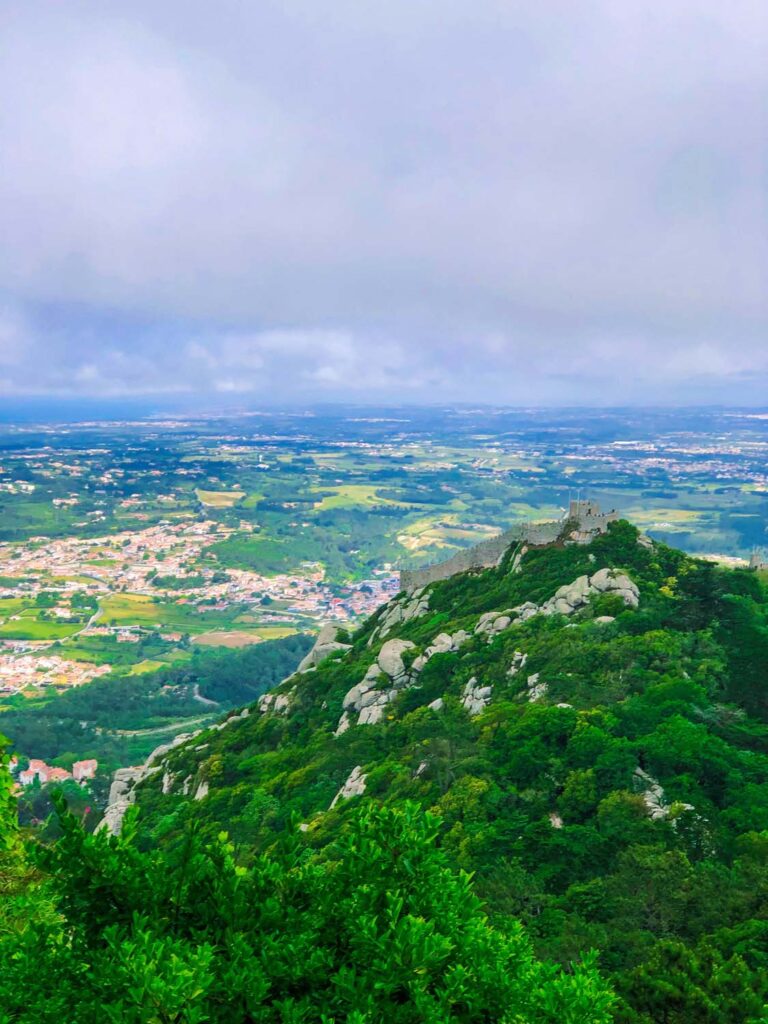
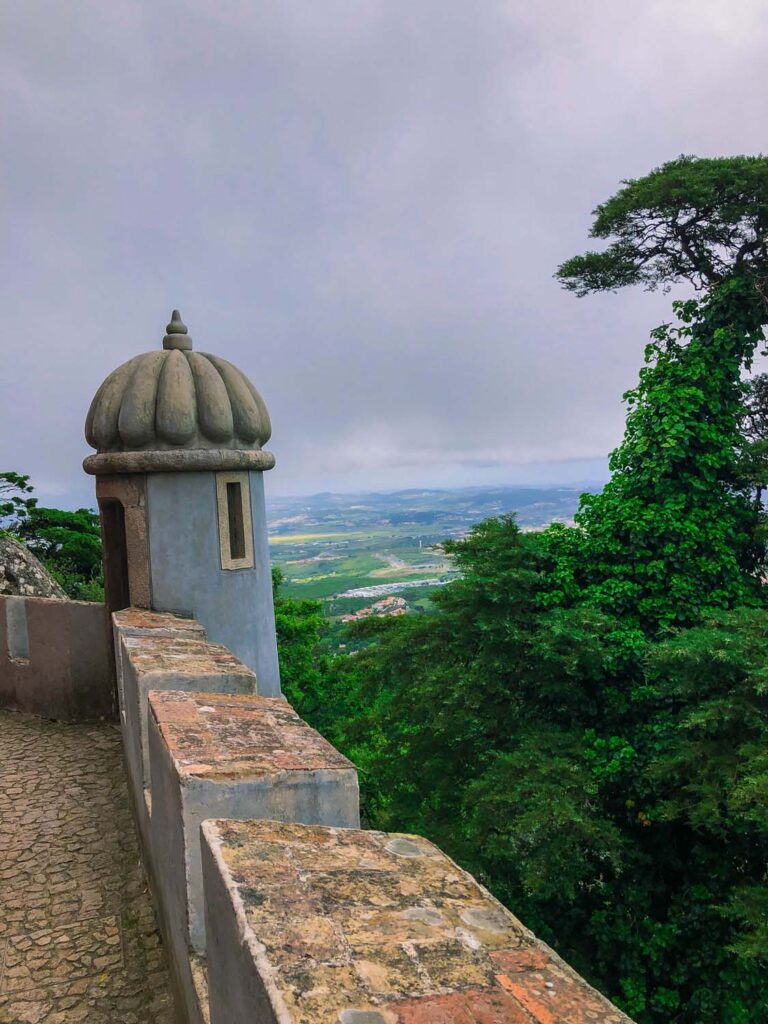
Admission Options
There are two options for Pena Palace admission. One is to tour the palace’s exterior and royal gardens. The other option will get you entry into the interior of the castle. If you are confident you’ll arrive early and are keen on seeing the rooms inside, go ahead and buy that ticket. But the lineup to get inside can get insanely long. They need to control the number of people who enter the buildings (something which isn’t monitored outside), so this often results in lengthy queues.
We were there as close to the opening as possible, and even we had to wait about 20 minutes to get inside. When we left, the line looked to be almost 2 hours long. While I thoroughly enjoyed touring the interior, there is no way it’s worth 2+ hours of waiting in line. If you think you can miss the interior, the gardens, and the exterior ticket is an excellent option since I think the best parts of the castle are the exterior anyway. It will save you a few euros and potentially a lot of time. If you did purchase a ticket for the interior tour but the lineup to get inside is gigantic, I would advise coming back right before closing when the crowds have cleared out.
Hours
Pena Palace is open all year round except December 25th and January 1st. During the Summer (March to October), the palace is open from 9:45 am until 7:00 pm (last entry 6:15), and the park is open from 9:30 am until 8:00 pm (last entry 7:00 pm). In the Winter (October to March), the palace & park are open from 10:00 am until 6:00 pm.

When to Visit Sintra
Sintra is always busy. Yes, the winter will most likely be the least busy, but it’s also chilly and can be a bit grey. Since most of the things to see are outside, it’s not always the most comfortable time to explore. The height of the summer holidays is equally as miserable but instead because of the intense heat and crowds. Springtime is the happy medium of pleasant weather and medium crowds. Monday-Thursday is the best chance you’ll see a small group reduction.
Avoid holidays when possible, as these bring in Portuguese tourists. As mentioned before, the earlier in the morning you arrive, the better chance you’ll have at beating the bus tours, which are the most significant crowd control issue. Always the most comfortable time to explore.
How Much Time to Spend?
Pena Palace, although the most popular spot to visit in Sintra, doesn’t take too much time to tour. We spent about 2 hours inside the Palace proper and another hour touring the gardens. If you wanted to tour the entirety of the acres and acres the gardens are spread out across you could be here all day, but to visit the entirety of the Palace and a general tour of the gardens would take around 3 hours. This doesn’t include waiting in line, so if you come on a busy day when the line up to get inside the interior is hours long this will obviously add to your time spent there.
If you find the line for the interior is too long and you want to see a lot of the gardens, consider doing the gardens first and then returning to the interior later on in the day. Sometimes if a huge tour bus drops off a few busloads just waiting for those groups to disappear is a great plan to avoid having to wait in line with them.
Is it Really Worth Visiting?
Pena Palace, although the most popular spot to visit in Sintra, doesn’t take too much time to tour. We spent about 2 hours inside the Palace proper and another hour touring the gardens. If you wanted to tour the entire garden, which is spread out across acres and acres, you could be here all day, but to visit the whole of the palace and a comprehensive tour of the gardens would take around 3 hours. This doesn’t include waiting in line, so if you come on a busy day when the line up to get inside the interior is hours long, this will obviously add to your time spent here. If you find the line for the interior is too long and you want to see a lot of the gardens, consider doing the gardens first and then returning to the interior later on.
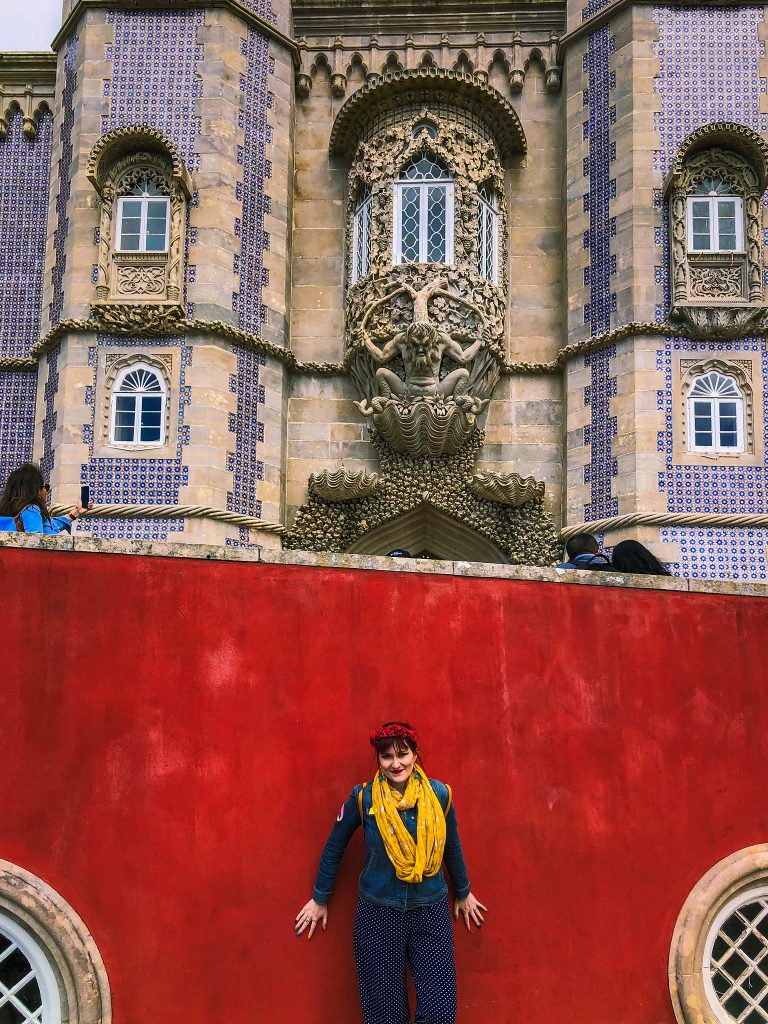
History of Pena Palace
The Hieronymite monastery was built in 1503 in honour of the Virgin Mary, who is said to have appeared at the top of the mountain in a vision. After falling to ruins over the years due to religious upheavals, King Ferdinand II, who had been in love with this spot since he was a child, decided to buy the buildings and the surrounding lands. Construction of the new royal estate began in 1838.
Ferdinand was obsessed with romanticism in art and architecture. He wanted his contemporary summer house to feel like something out of a storybook. Oddly enough, the palace’s construction was taken on by a mining engineer, Wilhelm Ludwig von Eschwege. Perhaps this was because the Prince and his wife wanted their full say in the castle’s design. Yet they needed Eschwege’s planning prowess to help them achieve the look of a castle sprung forth from the rocks. There really is no one style to be found here. Instead, it’s a patchwork quilt of influences and themes. Ferdinand wanted to include Medieval and Islamic elements and Neo-Renaissance, Neo-Gothic, and Neo-Manueline. The Manueline architecture was the most iconic style in Portugal at the time. It was the millennial pink of its time.
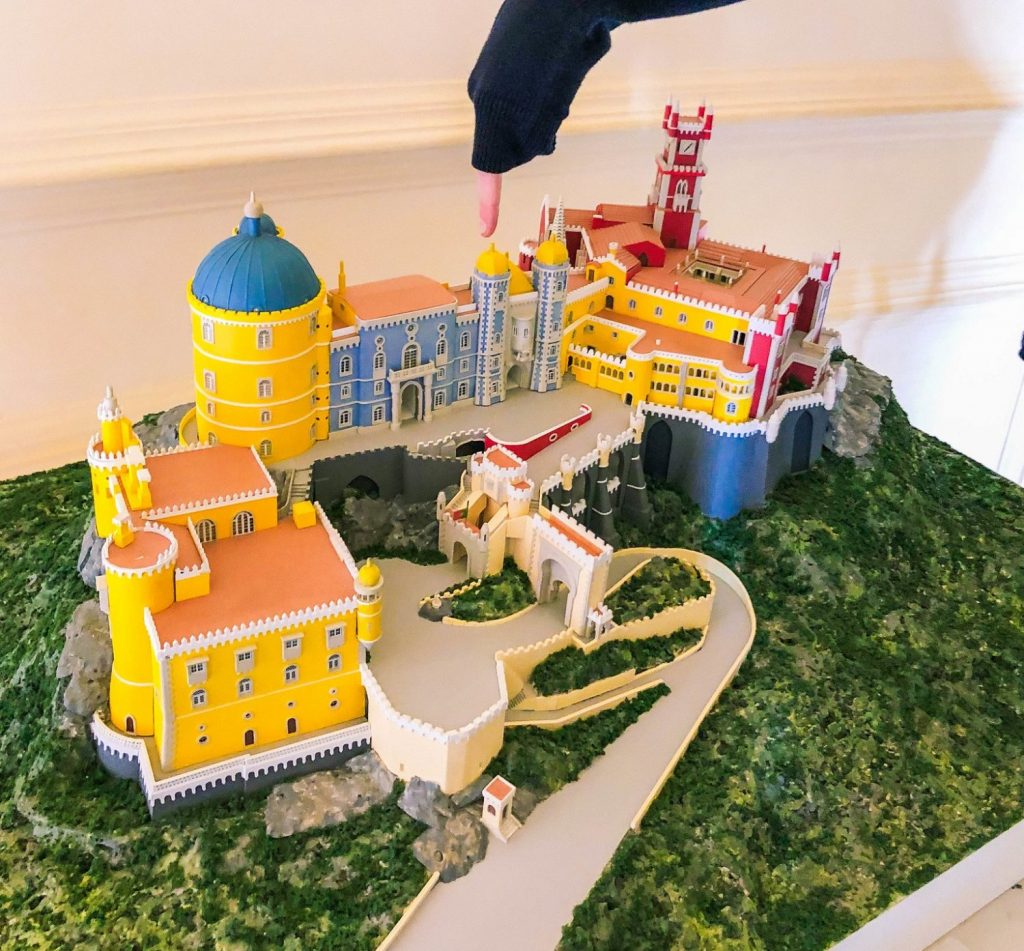
Architecture
There really is no one style to be found here. Instead, it’s a patchwork quilt of influences and themes. Ferdinand wanted to include Medieval and Islamic elements and Neo-Renaissance, Neo-Gothic, and Neo-Manueline. The Manueline architecture was the most iconic style in Portugal at the time. It was the millennial pink of its time.
After the death of Ferdinand, the castle was inherited by his second wife, Elise Hensler, who became Countess of Edla. The Countess, under pressure from the crown, sold the estate back to the royal family with the one condition that she could continue to live there until her death. King Carlos, next in line to the throne, was the last member of the royal family to live in the palace. After his assassination, his son, Manuel II, became the last King of Portugal and his wife, Queen Amélia, was the last person who stayed in the palace until the republican regime brought an end to the Portuguese crown.
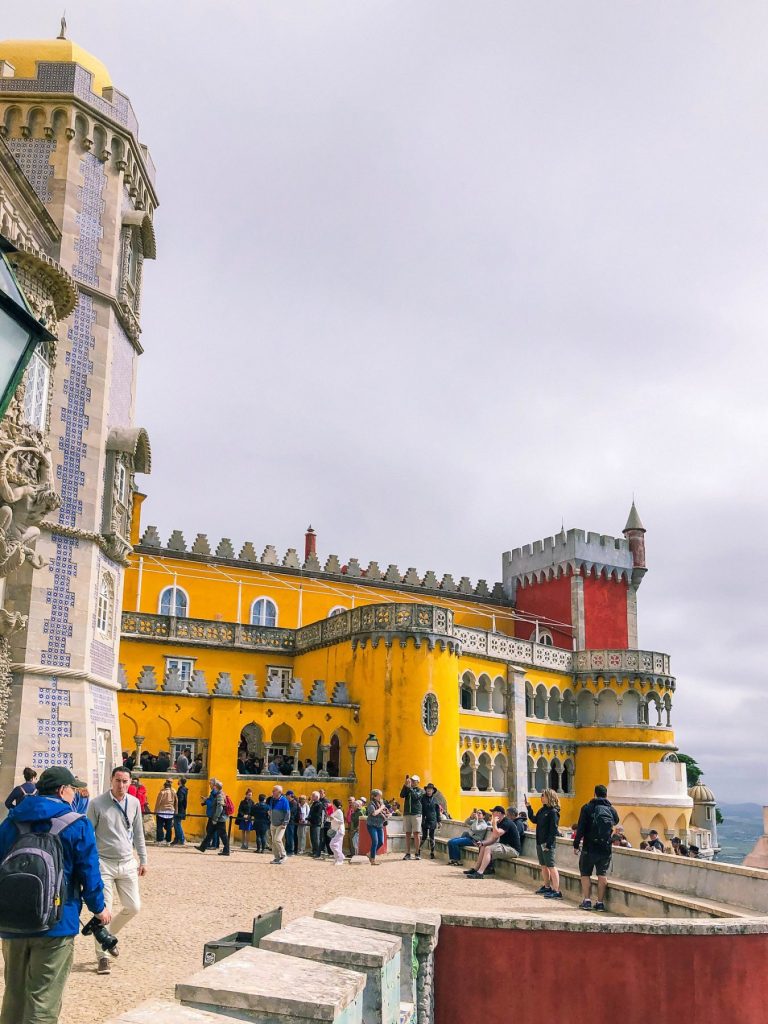
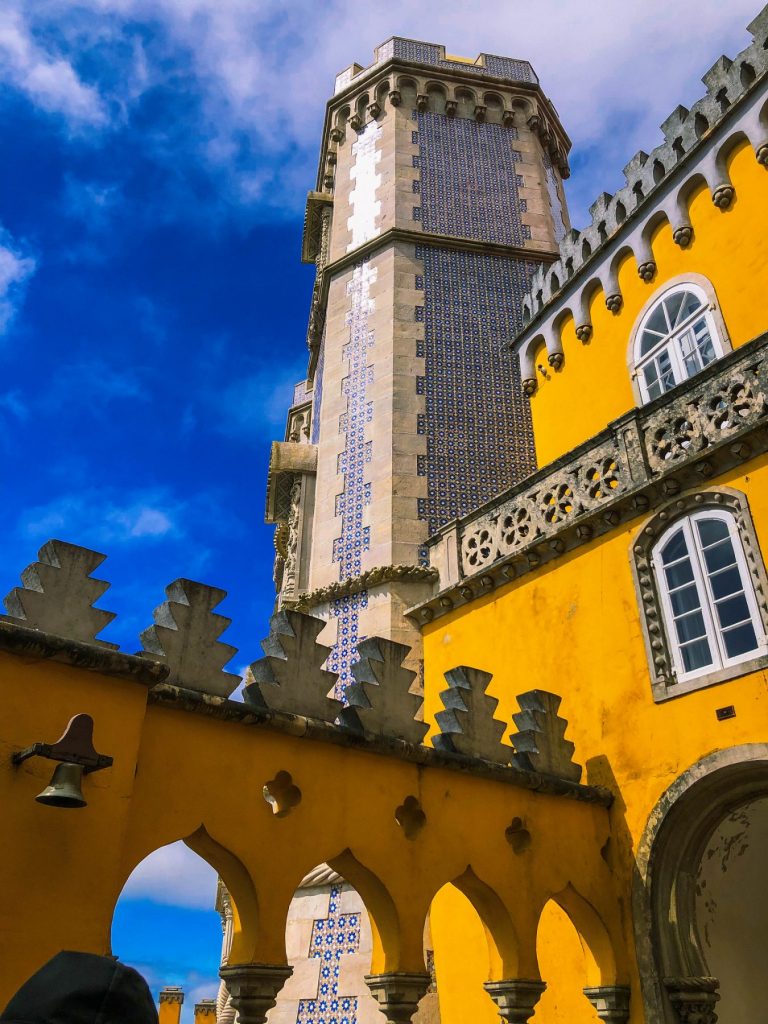
Entrance to the Palace
While the entry gates are just off the roadside, the palace is a fair bit uphill from the main entrance. There is a mini-bus which runs up to the top, but it costs 3€ and more than the money, the line you need to wait in to get onto the bus is a huge inconvenience. Although a little long, the walk-up is actually quite enjoyable. If you have mobility issues, just take it slow and spend the extra time resting between spurts admiring all the beautiful flora and fauna in the garden.
At the top of the hill, the golden yellow walls, blue tile and red-painted exterior of the palace begin to emerge from the trees. Seeing this palace in real life is nothing like seeing the pictures. I really don’t think they can do it justice. Walking up those cobblestone steps makes you feel like you’re walking into a fantasy.
Door of Alhambra
The entryway into the castle is called the Door of Alhambra. It was inspired by the Alhambra Door of Justice in Granada, Spain. The doorway is covered in brightly painted tiles and decorated with various elegant leaves. Ferdinand wanted this gateway to be where his visitors left the real world behind and stepped into his dream world.
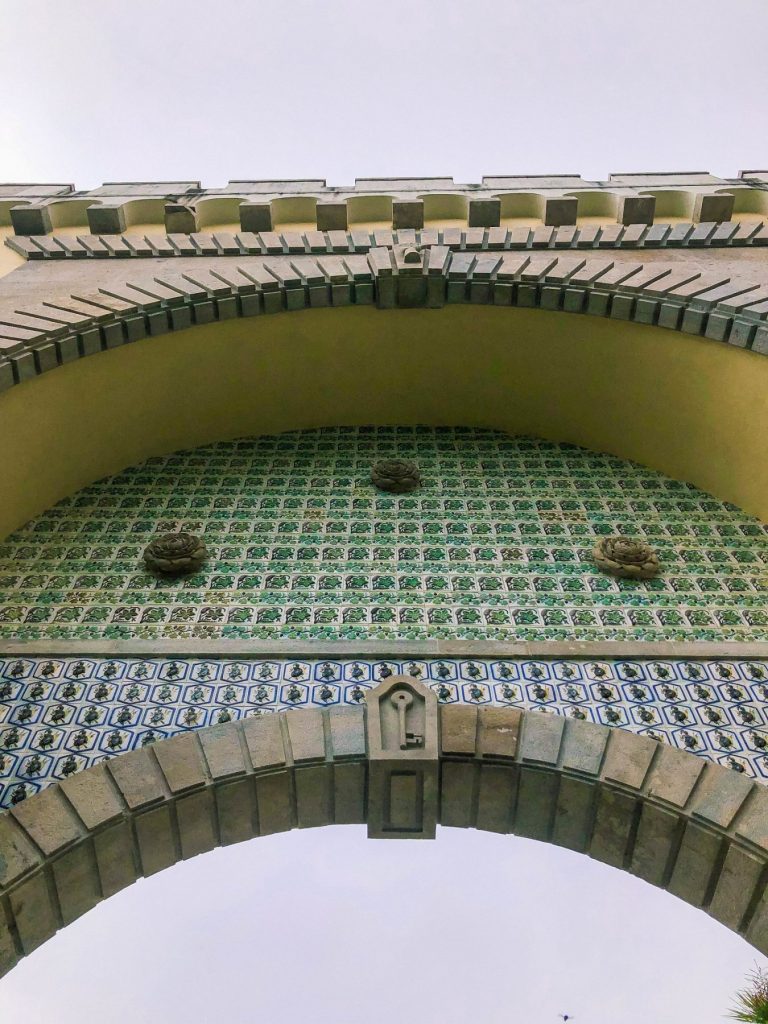
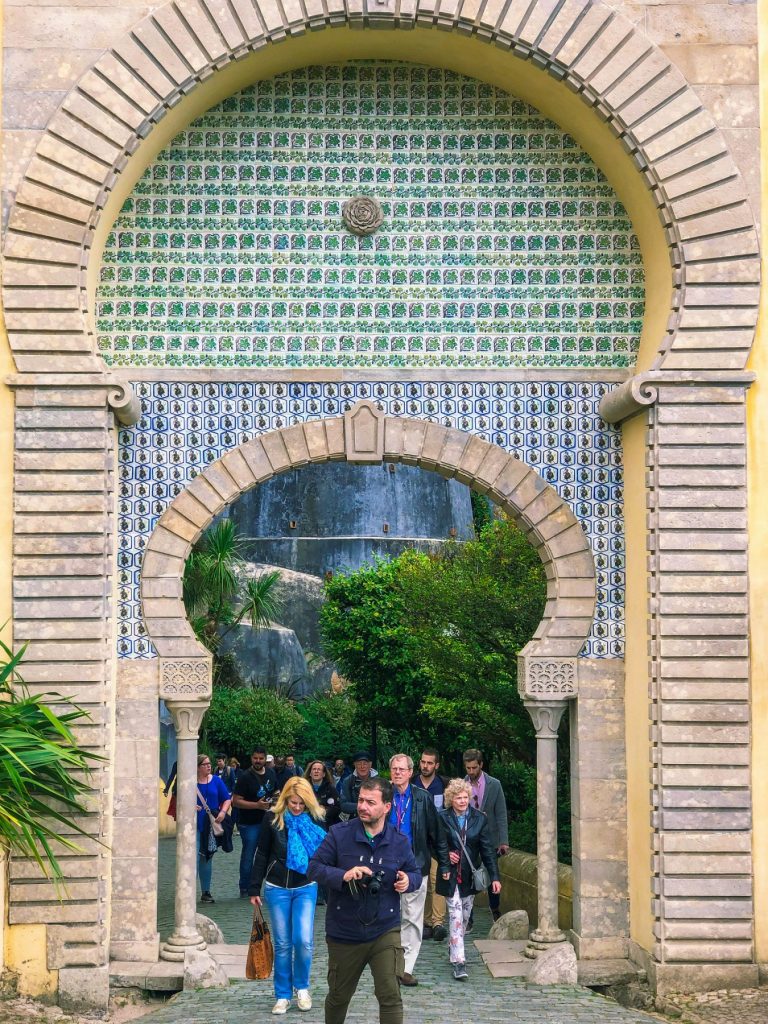
The Coach Yard
Open passing through the archway, we step into the ‘Coach Yard.’ This was as far as horses and carriages could come, and guests would make their way to the palace on foot. Standing here, we can look up at the ‘Monumental Gateway.’ The gateway’s design is a blend of architectural elements found all over Lisbon and which the Prince wanted to see incorporated into his palace.
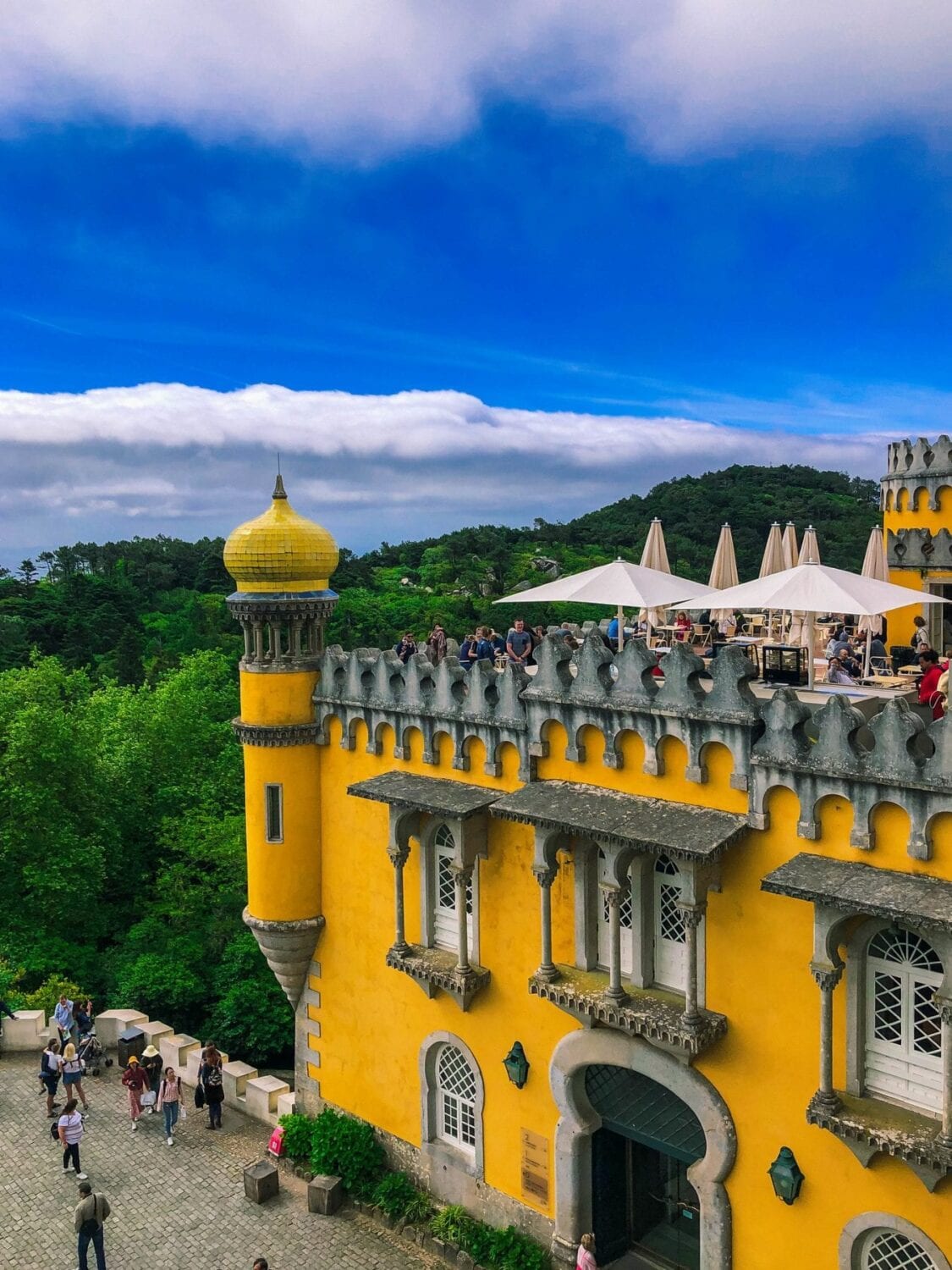
The facade is covered in diamond-shaped stones, referencing the Casa dos Bicos in Alfama. On either side of the top of the gateway, we have arched domes, completed with rope-like decoration; the same was on the famed Tower of Belem. The exterior is finished in a series of round balls reminiscent of the Cunhal das Bolas in Barrio Alto. In the centre of the arch, on the very top, is a pair of crossed swords atop a knight’s helmet, with a plume of lush feathers springing out of the top.
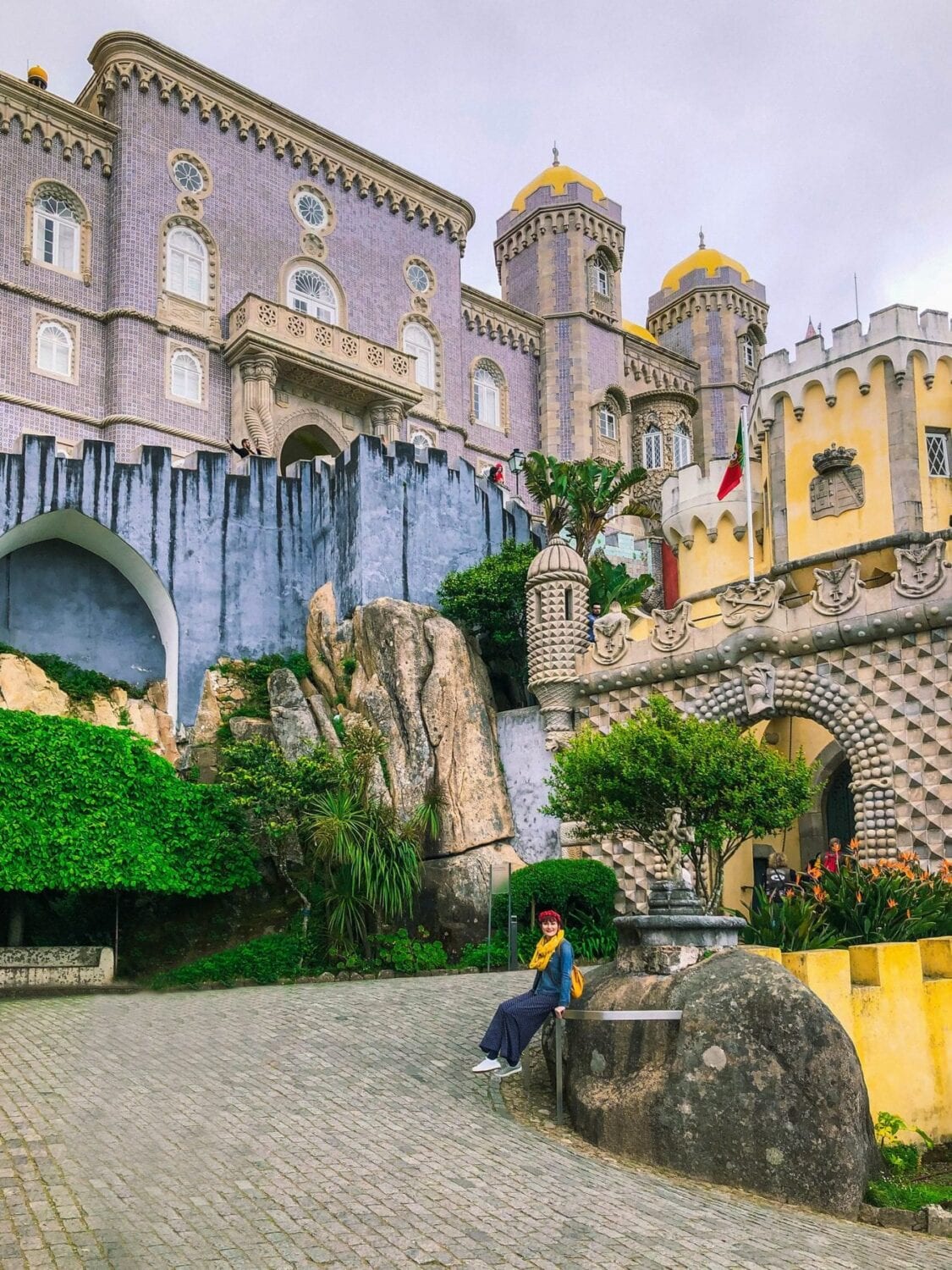
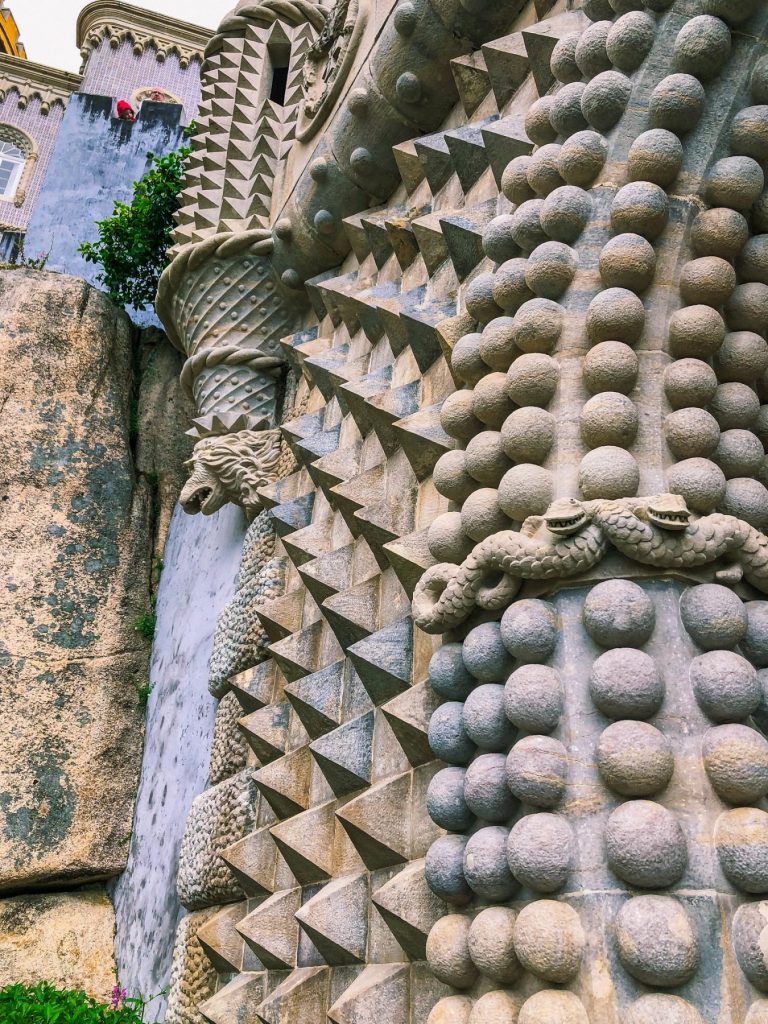
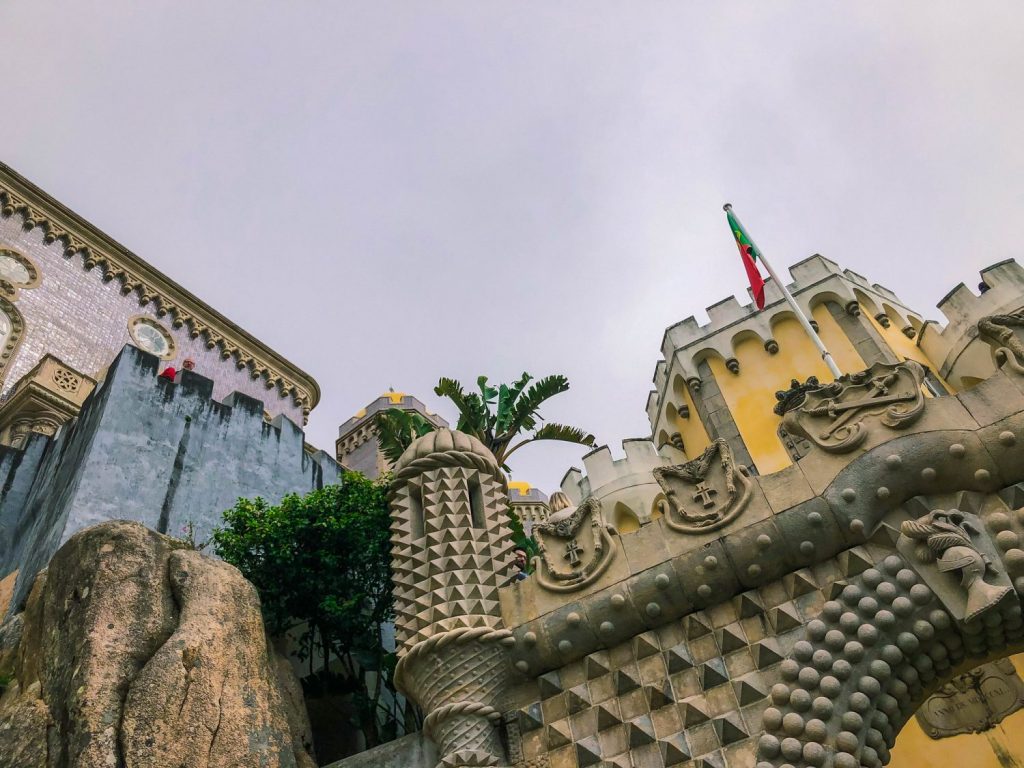
Upper Courtyard
Step through the archway and make your way around the swirling passageway to the upper courtyard. It’s here you’ll finally have the chance to study the tiles which make up the exterior hue of this building. Tiles, or Azulejos as they are called in Portuguese, have a strong history in Portugal, dating back to the 13th century. The Moors brought them here, who invaded much of Spain and Portugal in the 1200s. The word azulejo in Arabic means “small polished stone.” In Islam, they believed in aniconism, the avoidance of images of sentient beings in art. As such, geometric shapes became the most popular form of decor. As such, most of the tiles brought with them from Islam continue this tradition. The geometric and natural forms are striking, and their colours haven’t faded significantly over the years.
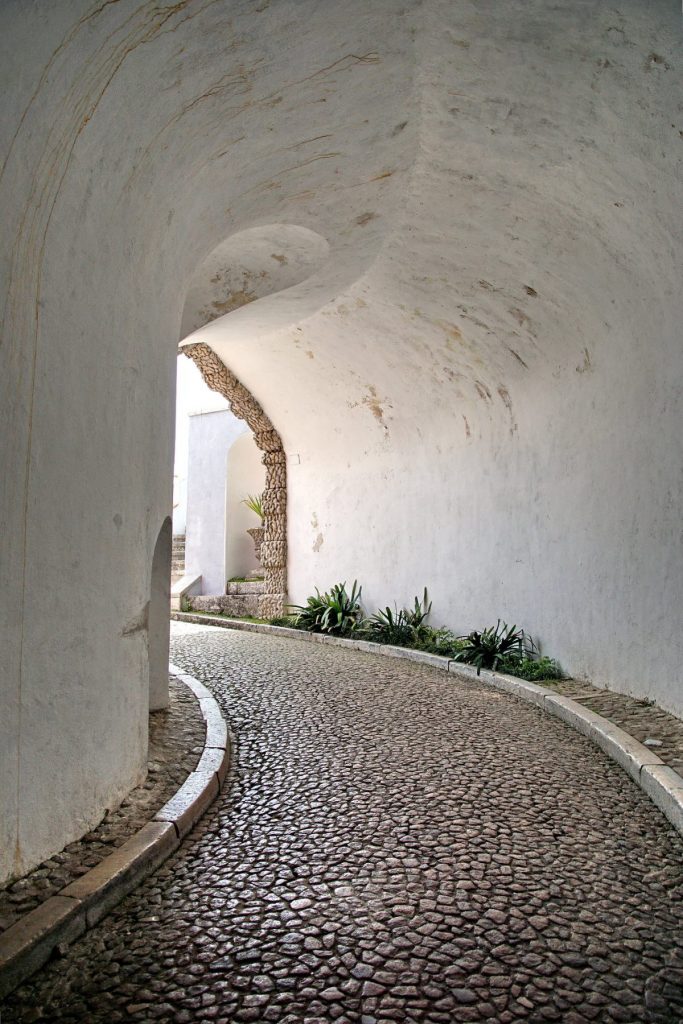
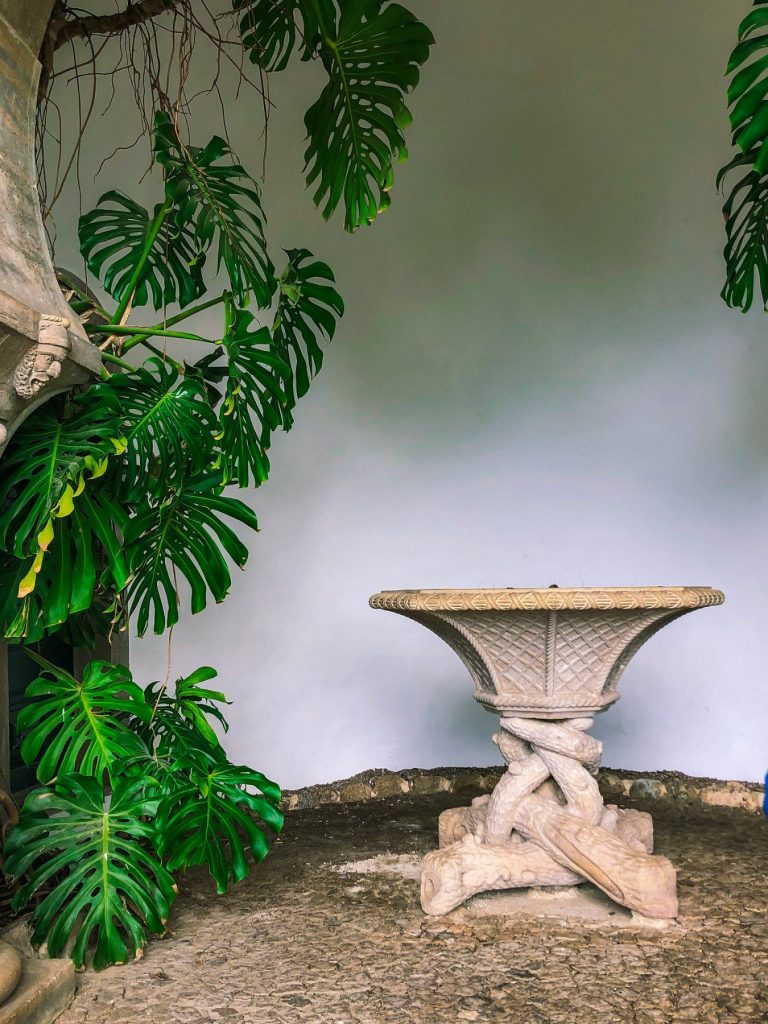
The Triton Portico
The Triton Portico is one of the most impressive elements of Pena Palace. Triton is meant to serve as an allegorical of the world’s creation. The facade is divided into two factions, the aquatic world below and the terrestrial world above. They are separated by Triton, a monster half man and half fish but a part of both worlds. Bits of corals surround Triton’s feet; above him, you can see the carved grape vines and leaves blossoming wildly. The Portuguese were a seafaring nation, and aquatic symbolism was always an important aspect of their artistic culture.

Azulejos
Tiles, or Azulejos as they are called in Portuguese, date back to the 13th century. They were brought here by the Moors who invaded much of Spain and Portugal in the 1200s. The word azulejo in Arabic means “small polished stone”.
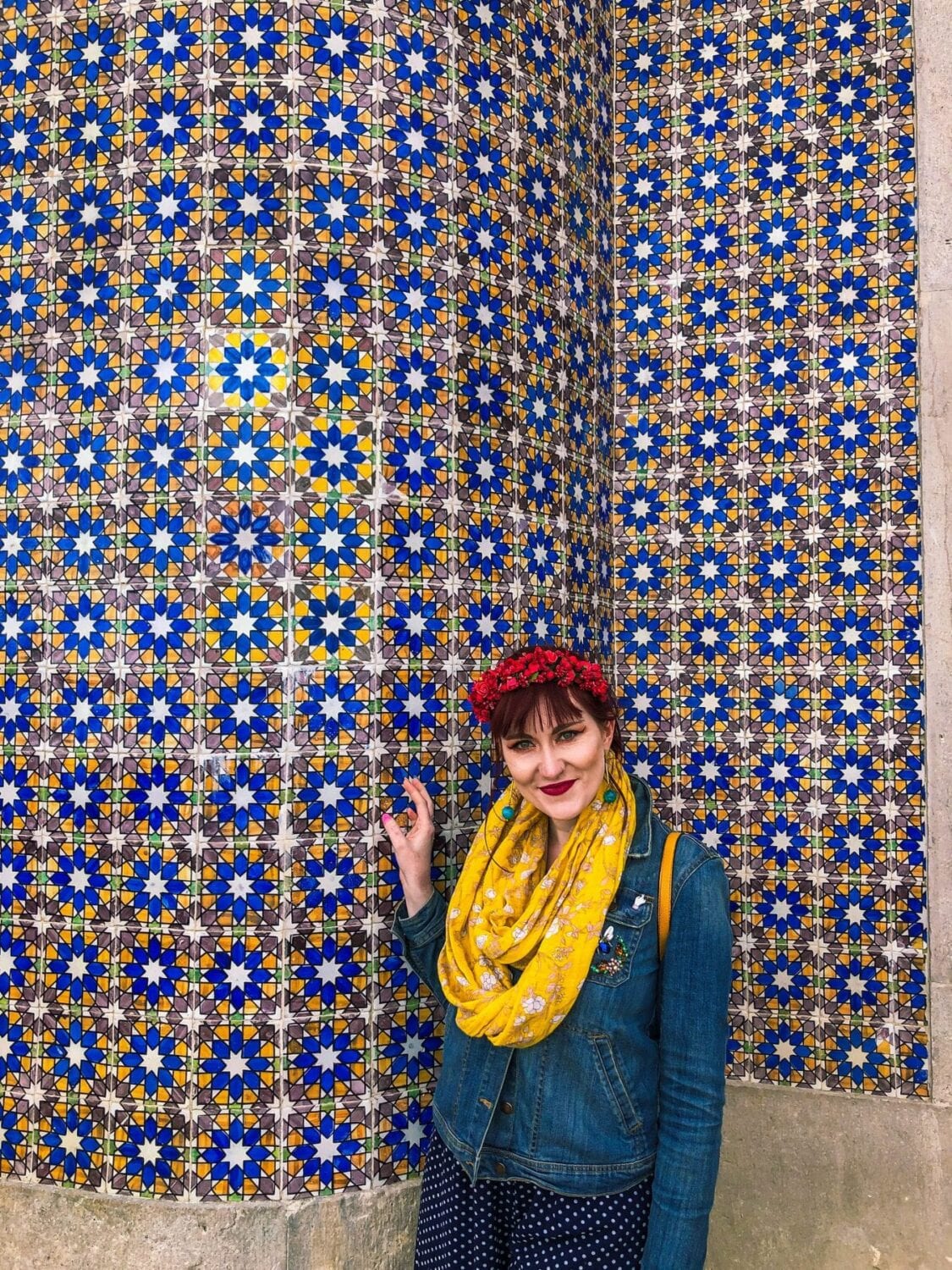
In Islam, they believed in aniconism, which is the avoidance of images of sentient beings in art. As such, geometric shapes became the most popular form of decor and as such, most of the tiles brought with them from Islam continue this tradition.
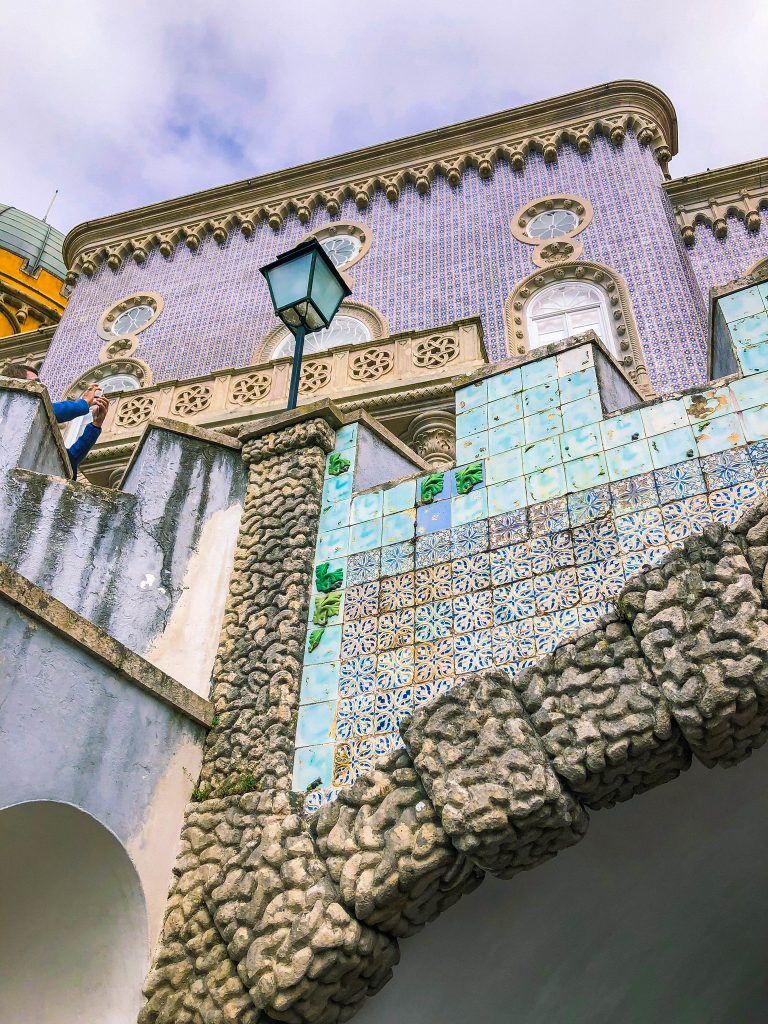
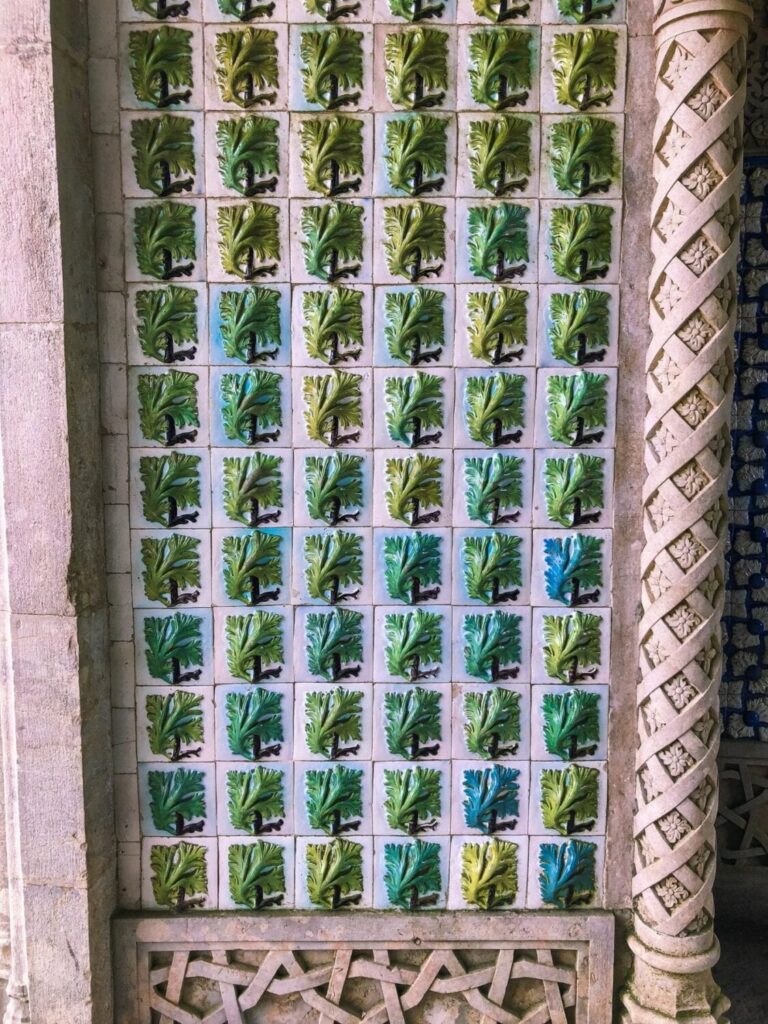
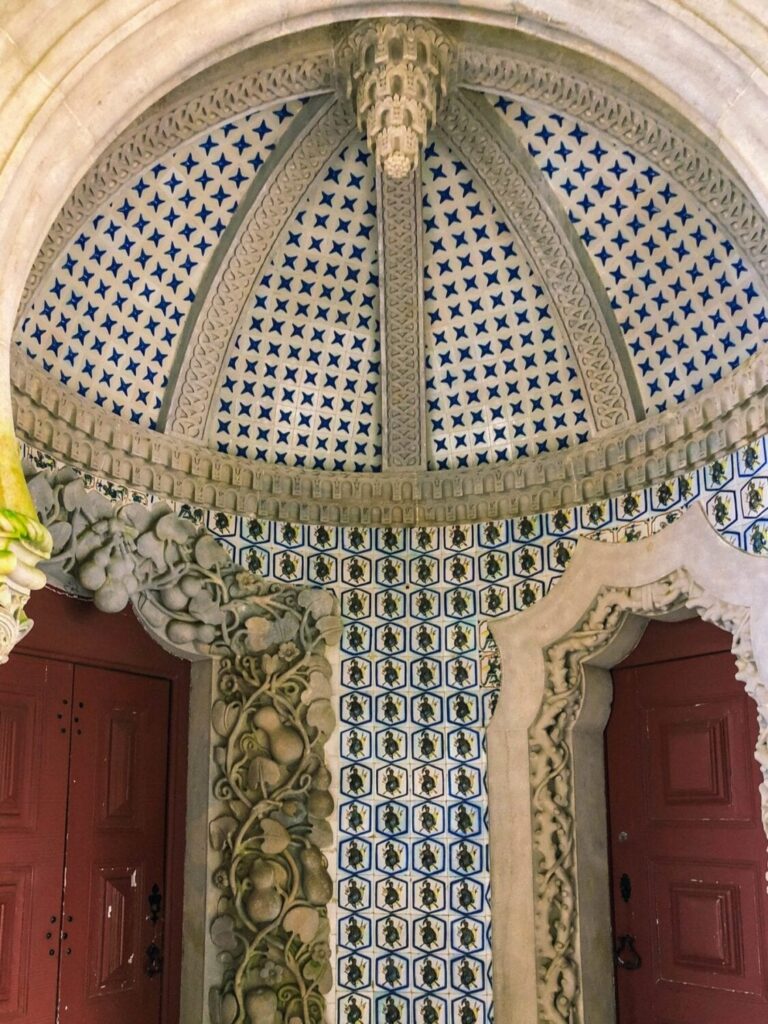
Arches Yard
Walk underneath Triton’s arch out to the Arches Yard. The small passageway is where you’ll find the restrooms which are also covered in traditional tile work. The Arches Yard is framed by a wall of graceful, golden arches done up in Moorish style. The arches create a window onto the village of Sintra and across the countryside below.
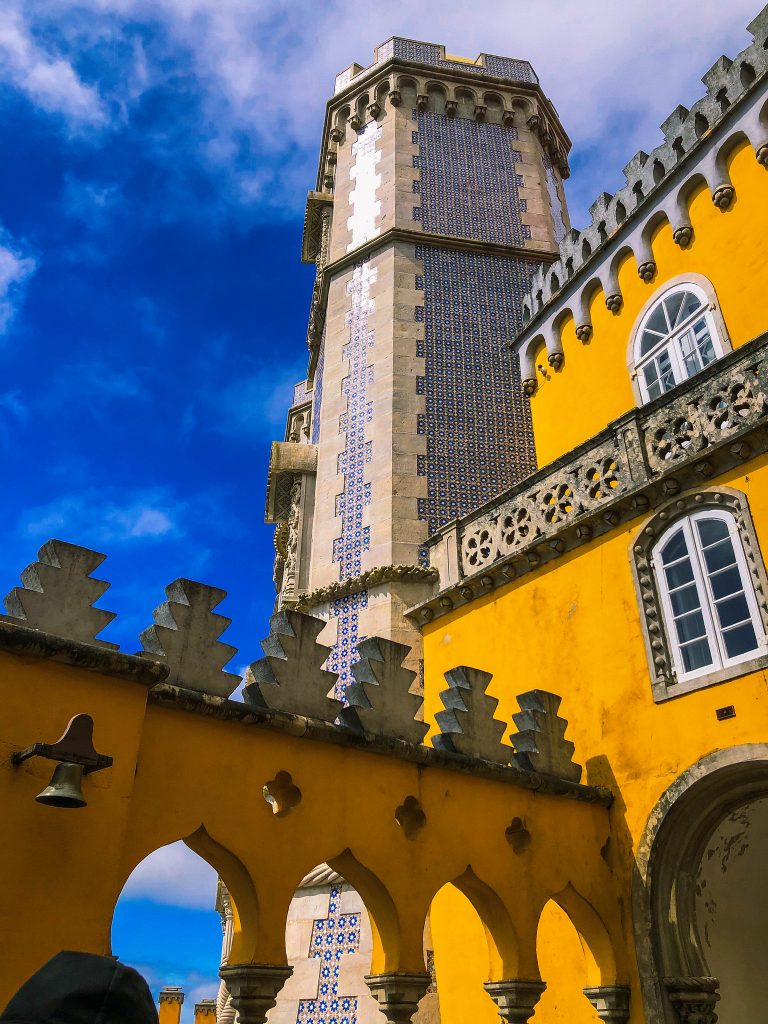
There is nothing to compare this view to, it seems to go on and on forever on a clear day. From atop this peak, you can spy on all the wealthy estates below, one of which is actually owned by Madonna, the Queen of pop herself! Sintra truly is still to this day where the rich and famous come to escape the city and to live in some of the most lavish properties found anywhere in the world.
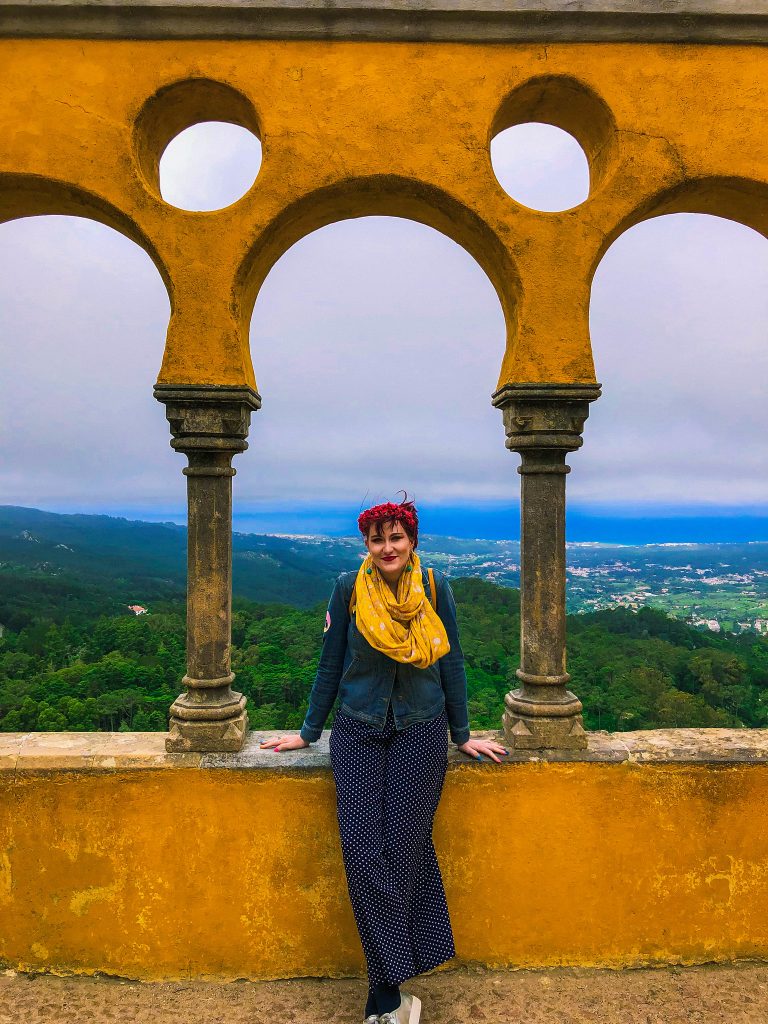
Convent of the Order of Christ
Take the chance to turn your eyes away from the incredible view, and look across towards one of the incredibly ornate windows on the main facade. This piece was directly inspired by the chapter house window in the Convent of the Order of Christ in Tomar. The window is surrounded in alchemical symbols, some of which seem to have a mystical aura. Much of Sintra’s more obscure lore lies in its prominence as a Masonic hub. The Convent of the Order of Christ was a 12th-century stronghold for the Knights Templar. Once its order was disbanded, it is said that the Masonic Temple was formed to continue its mission. It is rumoured that King Ferdinand was himself a grand master of the Masonic Order and as such, influenced much of Sintra’s history as a Masonic centre of power.
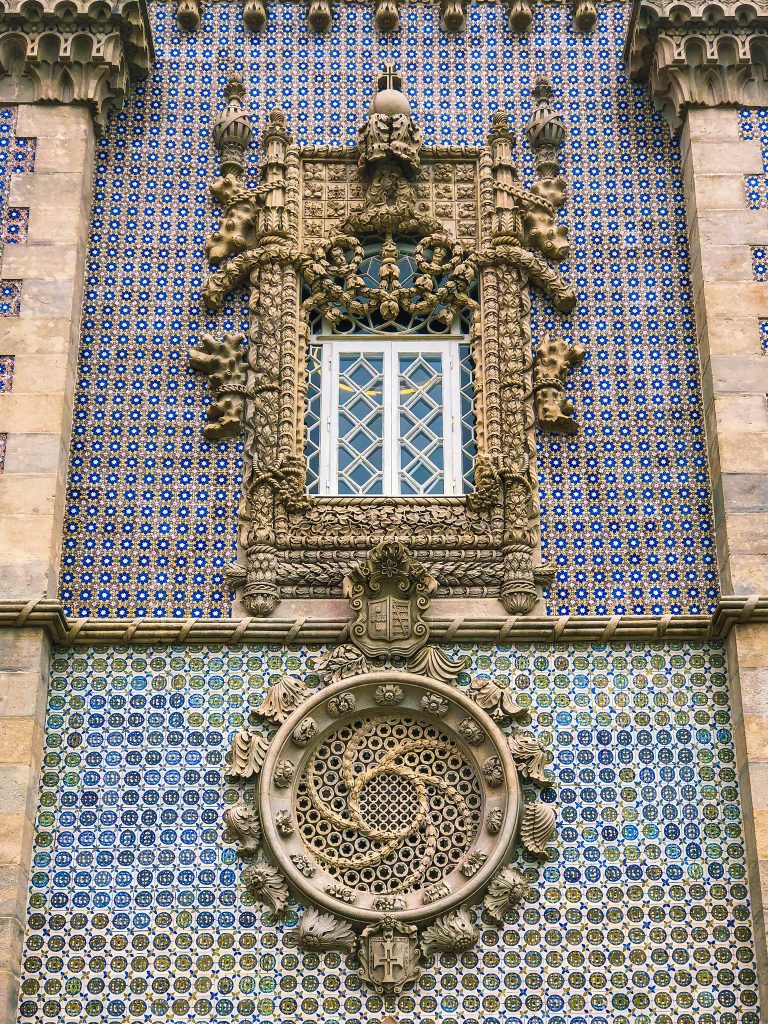
Chapel
Standing guard over the Arches Yard is the sizeable red clock tower atop the old monastery chapel. The steeple of the chapel is embellished with white and emerald green tiles which beautifully contrast the red and yellow walls and the blue (or grey in our case) sky.
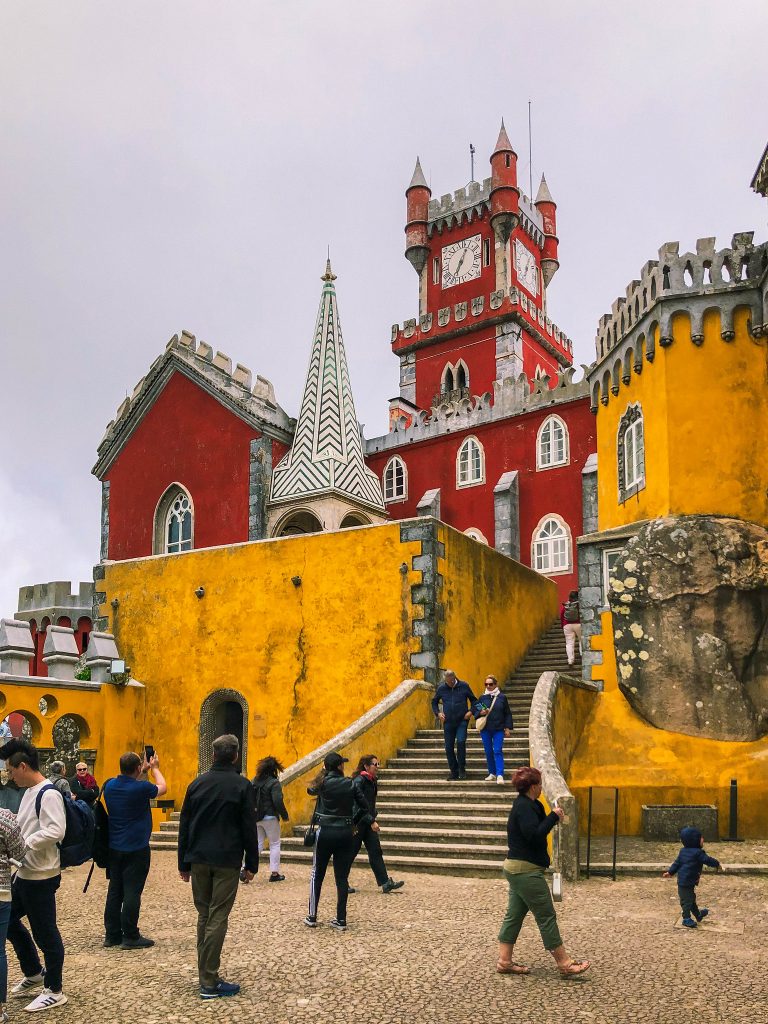
The chapel remains unchanged from its 16th-century design. 22 monks would come to pray here during their time at the monastery. The walls are entirely covered in green and white polychrome tiles which still shine inside the darkened chapel. In a small alcove is the ornate alabaster and black marble altar made by Nicolau de Chanterene in 1532. The expressions which he managed to carve out of the solid marble defy earthly conventions making it feel all the more holy.
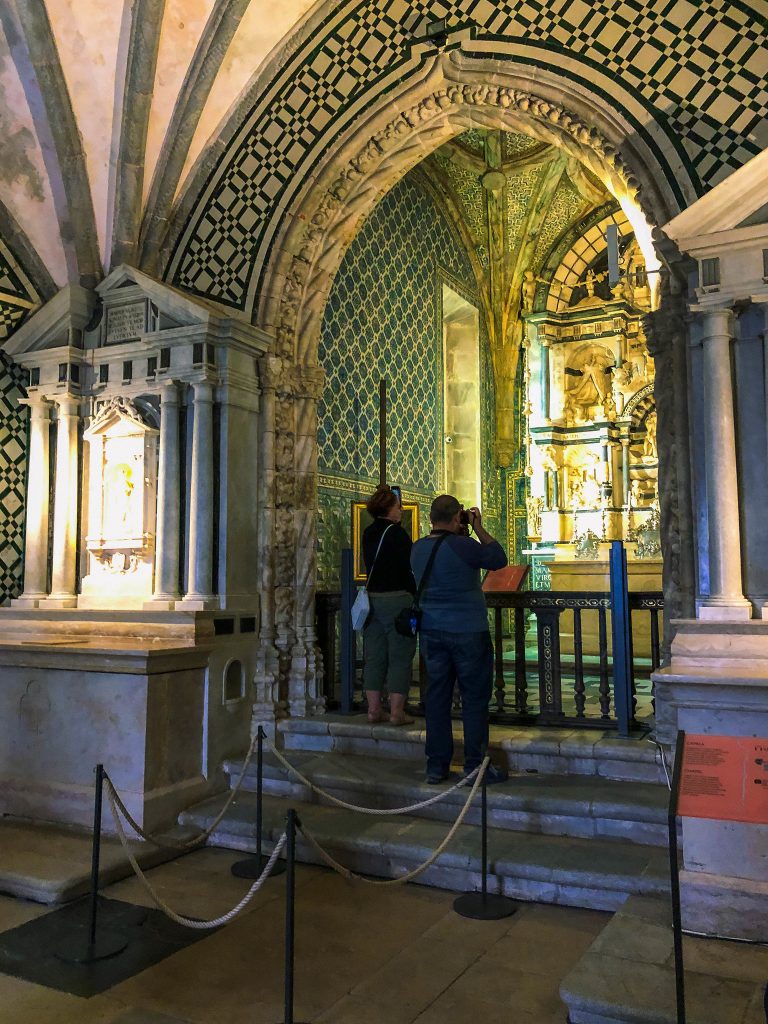
Remnants of the Monastery
Opposite the altar is one of the few remaining original stained glass windows from the monastery. The coloured used within this design are so striking, and it’s hard to believe this piece is a few hundred years old. I loved how quiet it was inside the church, it seemed most people skipped it as they were in a rush in those group tours, but I was glad to have stopped inside as it was a wonderful moment to pause and reflect on the beauty all around me.
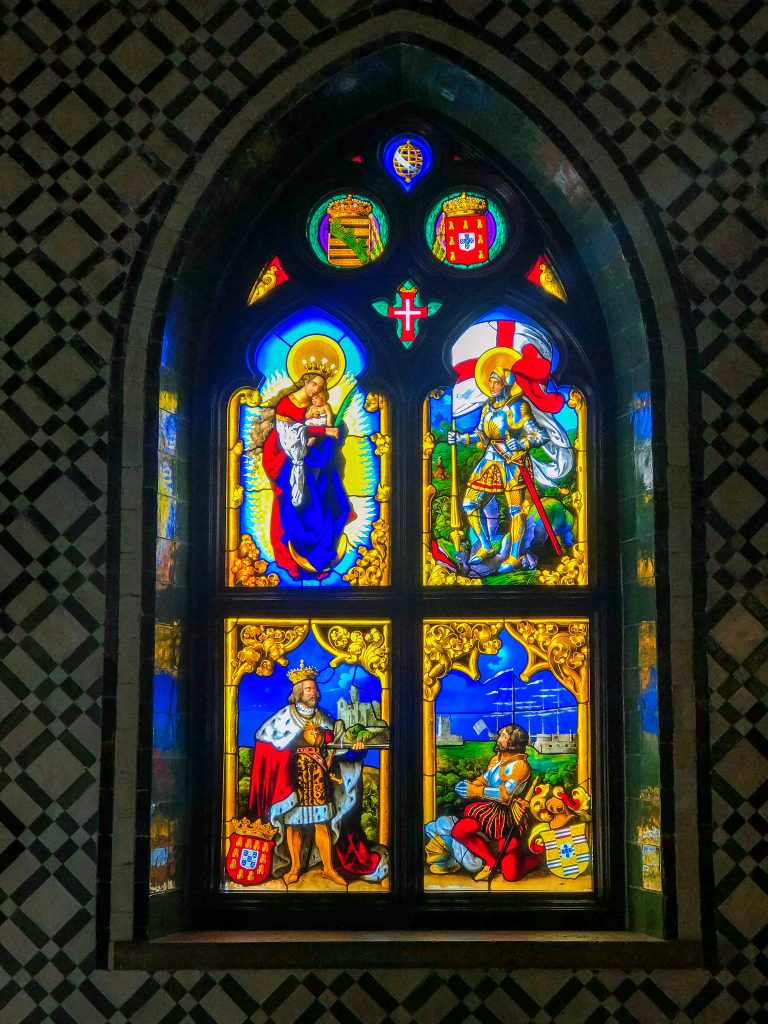
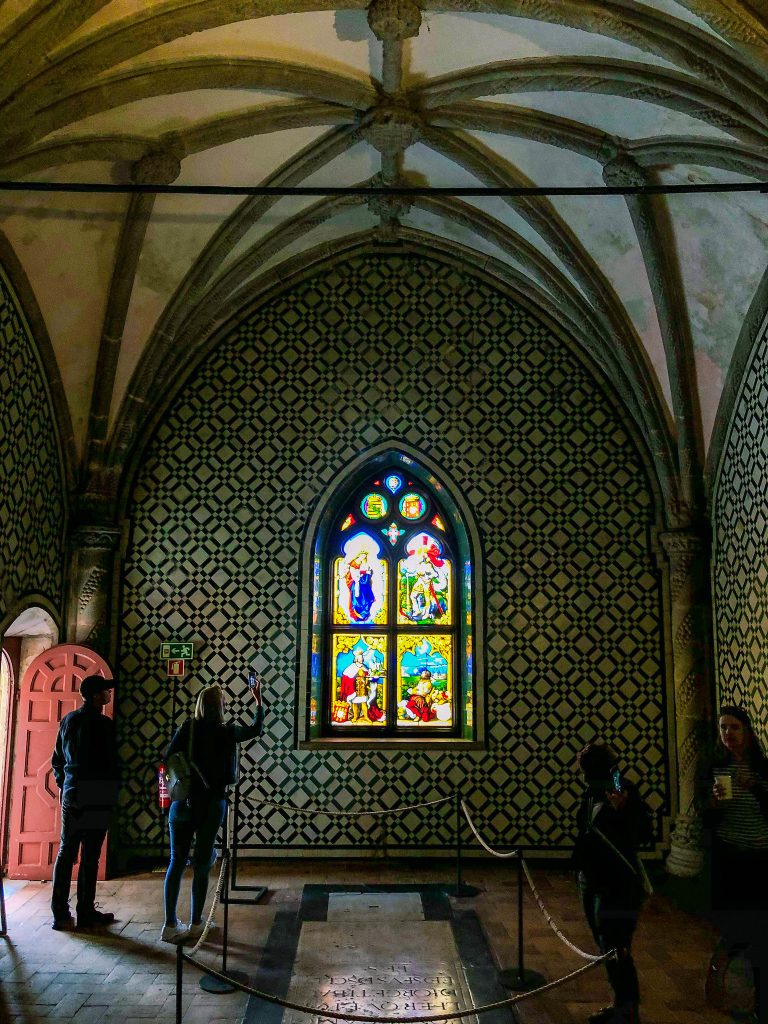
Wall Walk
Just down the stairs from the chapel is the Wall Walk, a small passage which leads you around the back of the palace. While the narrow walkway looks over a steep hillside, the brave will be rewarded with one of the most unbelievable views across Sintra.
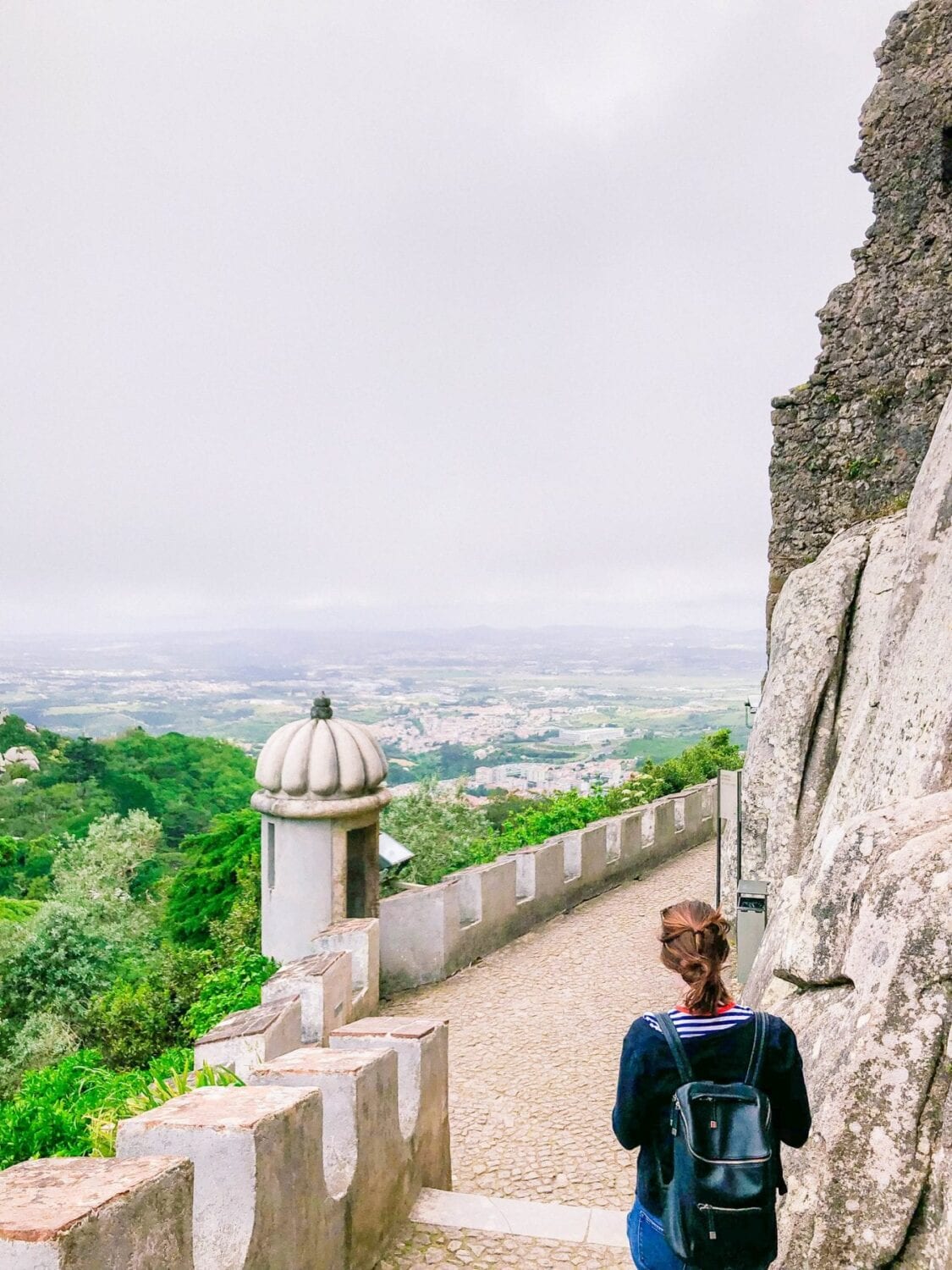
Standing on this side of the palace, you can see the Moorish Castle on the other side of the forest. It seems so far away, and yet the entrance to the Moorish Castle is just on the other side of Pena Park.
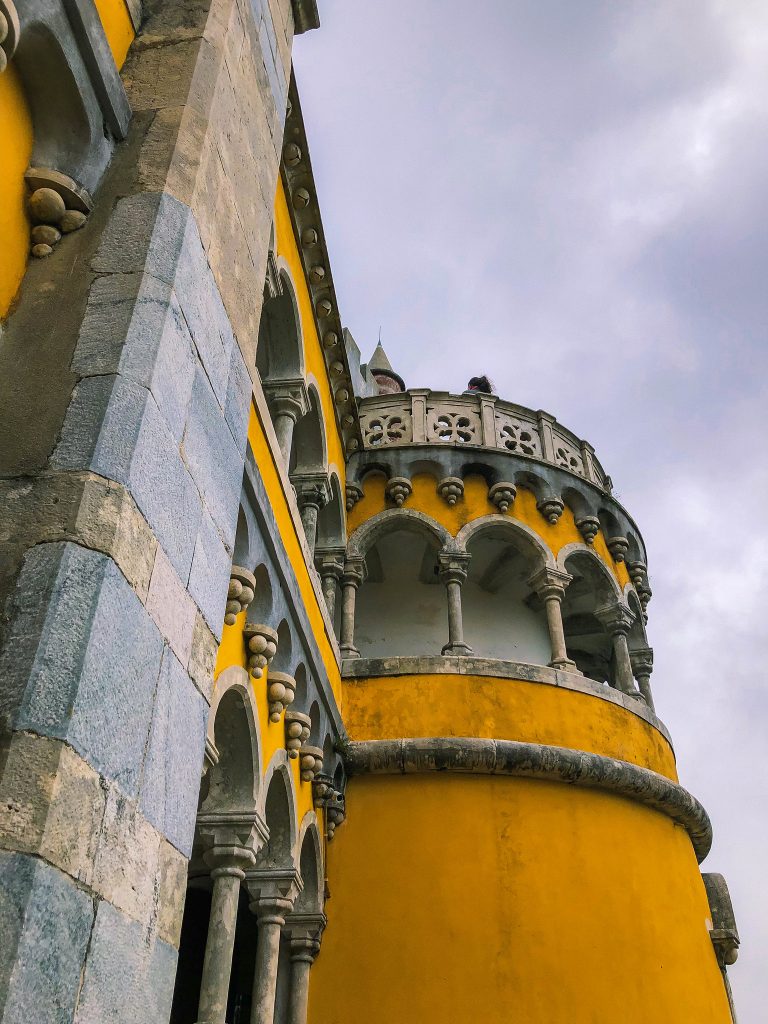
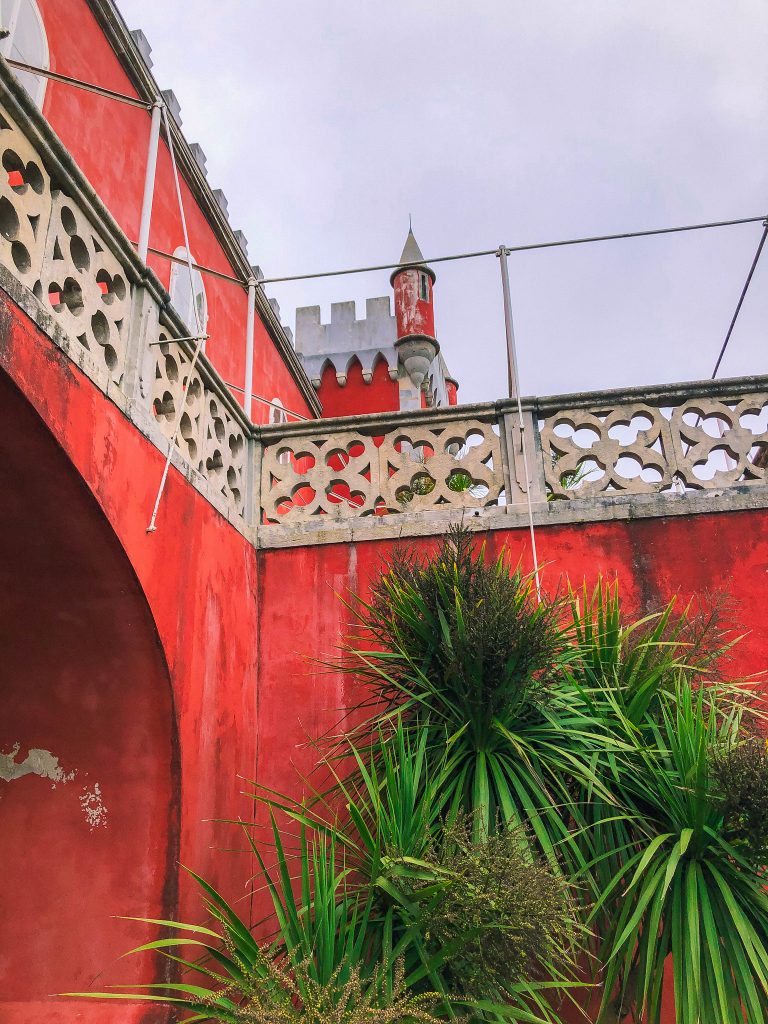
Interior of the Palace
If you bought a ticket to enter the interior, make your way inside. This part of the tour often gets very crowded, and the line can get long, so best to do it as soon as you enter when the line is bound to be shorter or if it seems rather long, skip it and make your way towards the gardens, with the intention to return here later in the day. The palace is made up of two separate wings. They are distinguishable by their paint colours. Ochre for the new wing and burnt red for the old monastic side.
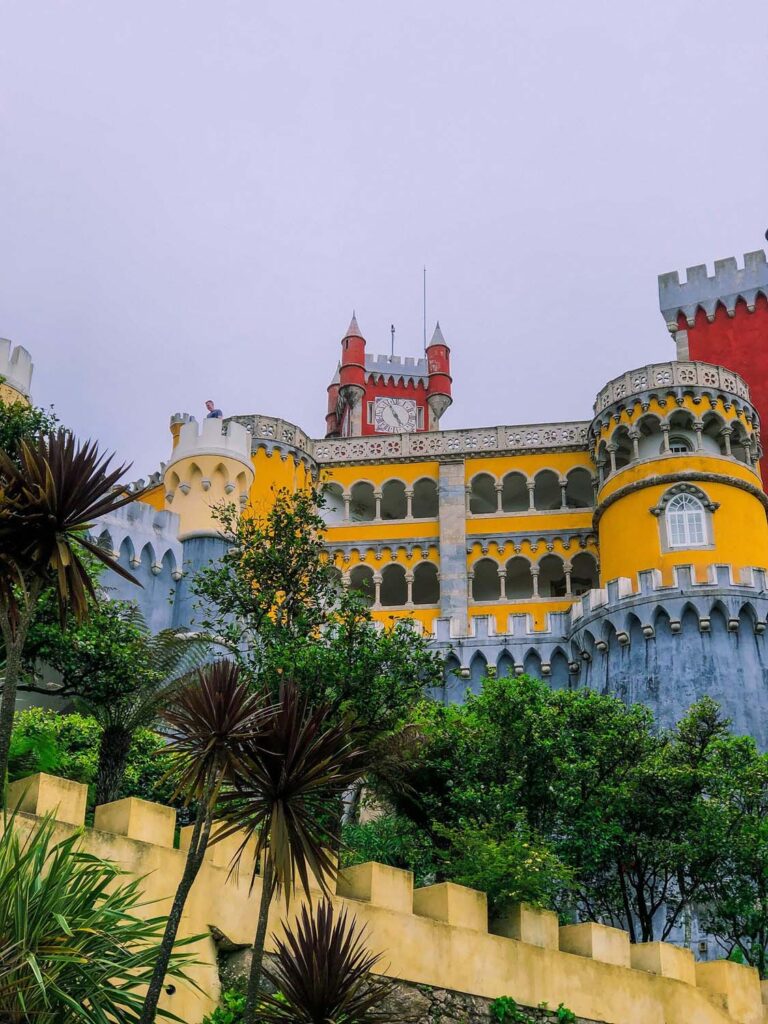
Entry Doorway
A stunningly embellished door, surrounded in carved florals now serves as the way in for visitors to the palace. This was the entrance formerly used by the Royal Family, providing access to the palace’s most private areas. This building was once the Hieronymite monastery, and although the spaces were converted from simple rooms for prayer into luxurious royal residences, the bones of the original structure remain the same.
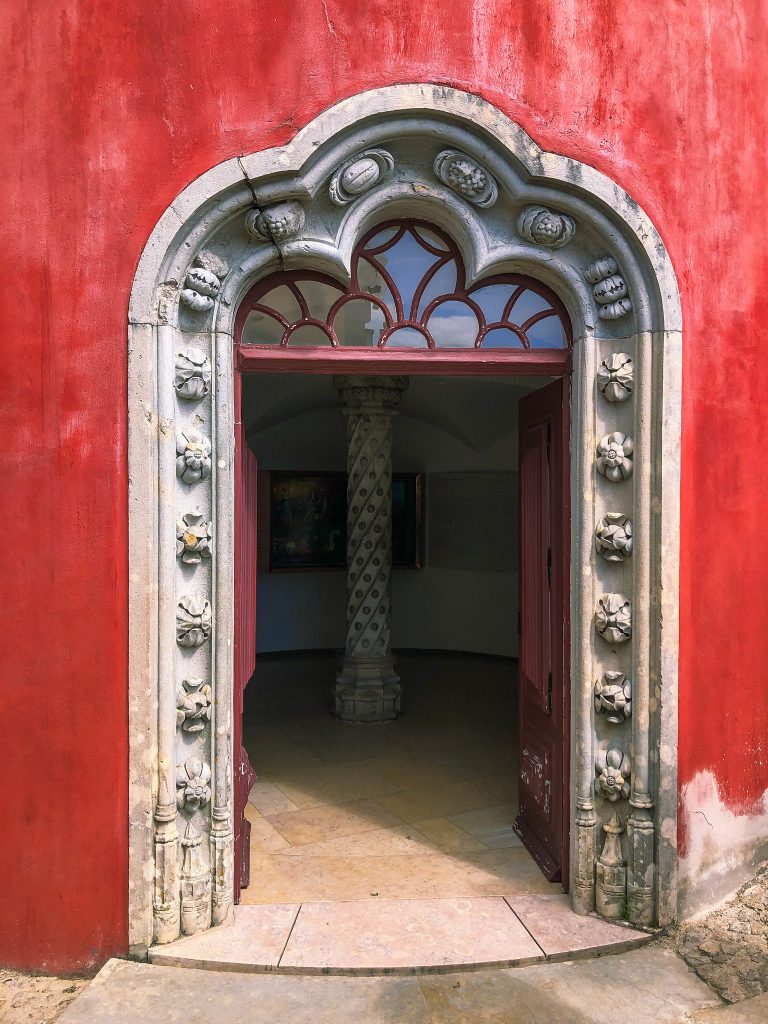
The Hieronymite Convent Cloister
As you enter, you’ll step right into the cloisters. Look up and see how the open-air hallways continue on both floors of the palace. The entirety of this place is covered in azulejos, and ghastly faces stare down at you, carved in the gargoyles above. The centre of the cloister has a giant carving of a shell in the centre which is held up by four little turtles. The open shell represents a womb, as this little scene is an allegory for the vegetal world giving birth to the aquatic underworld. Like the wealthy Portuguese Kings who, with their finances, gave birth to the world’s best seafaring explorers.
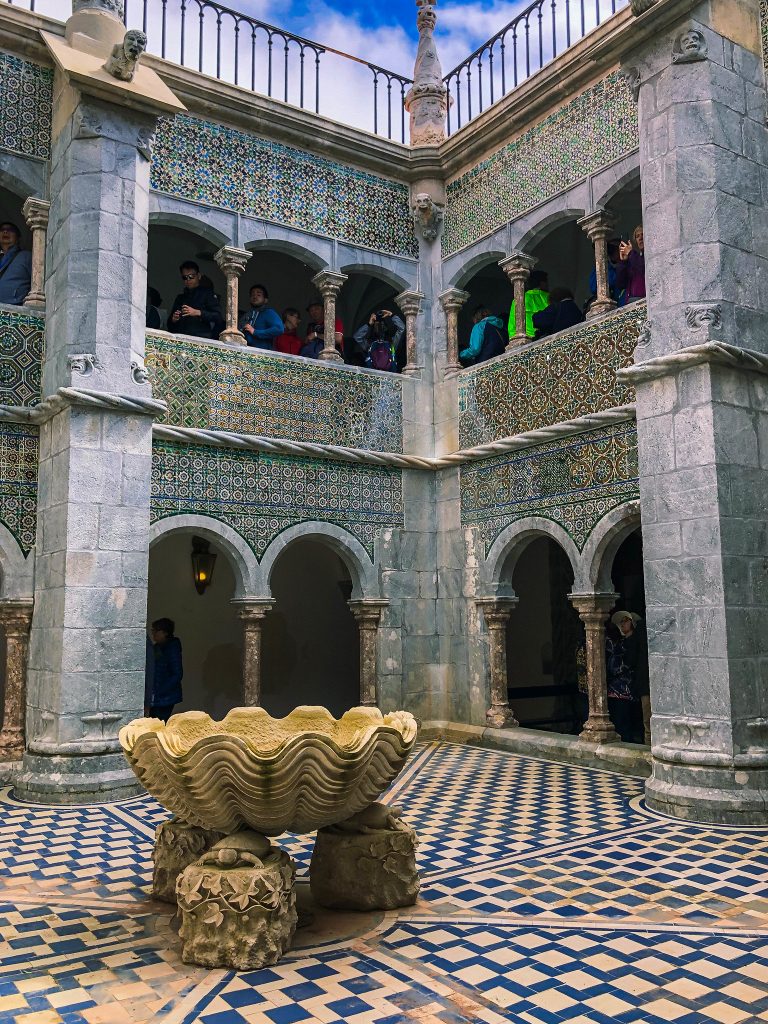
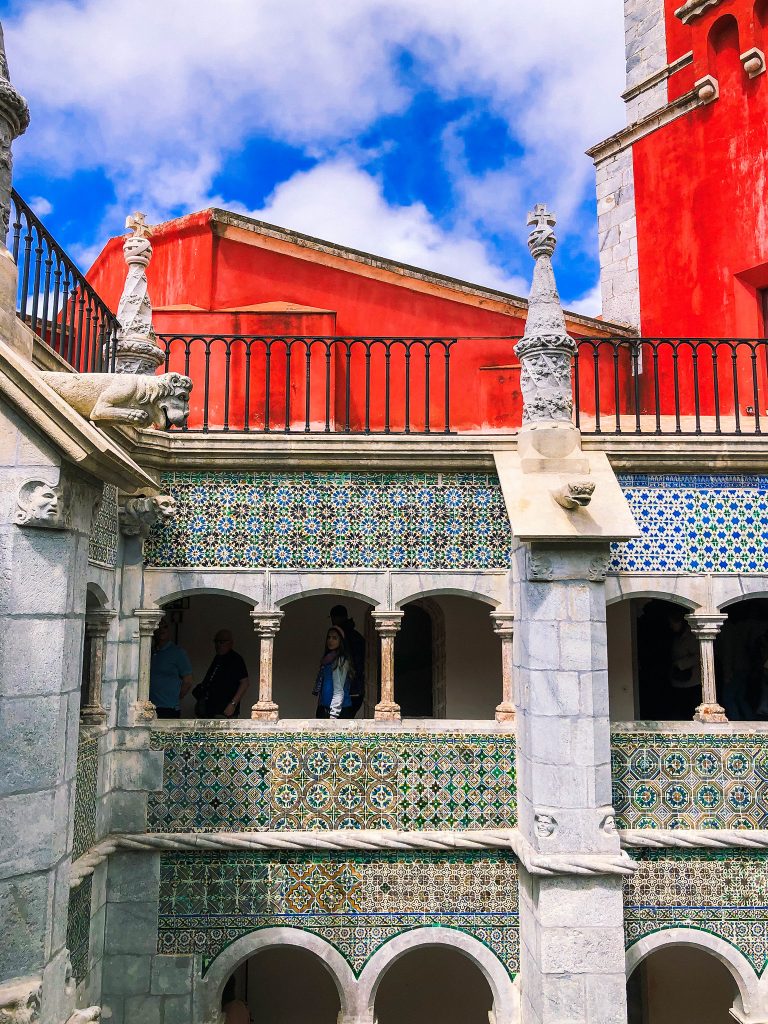
Scullery
The scullery is the first room you’ll enter from the outside cloister. In large, dark wood cabinets along the walls are porcelain and crystal flatware from the Royal collection. Set up on one table just to the right of the entry door is a sample of what their tea sets would look like. Tiny, little cups and plates in the shape of seashells are ready for a hot pot of tea and finger sandwiches.
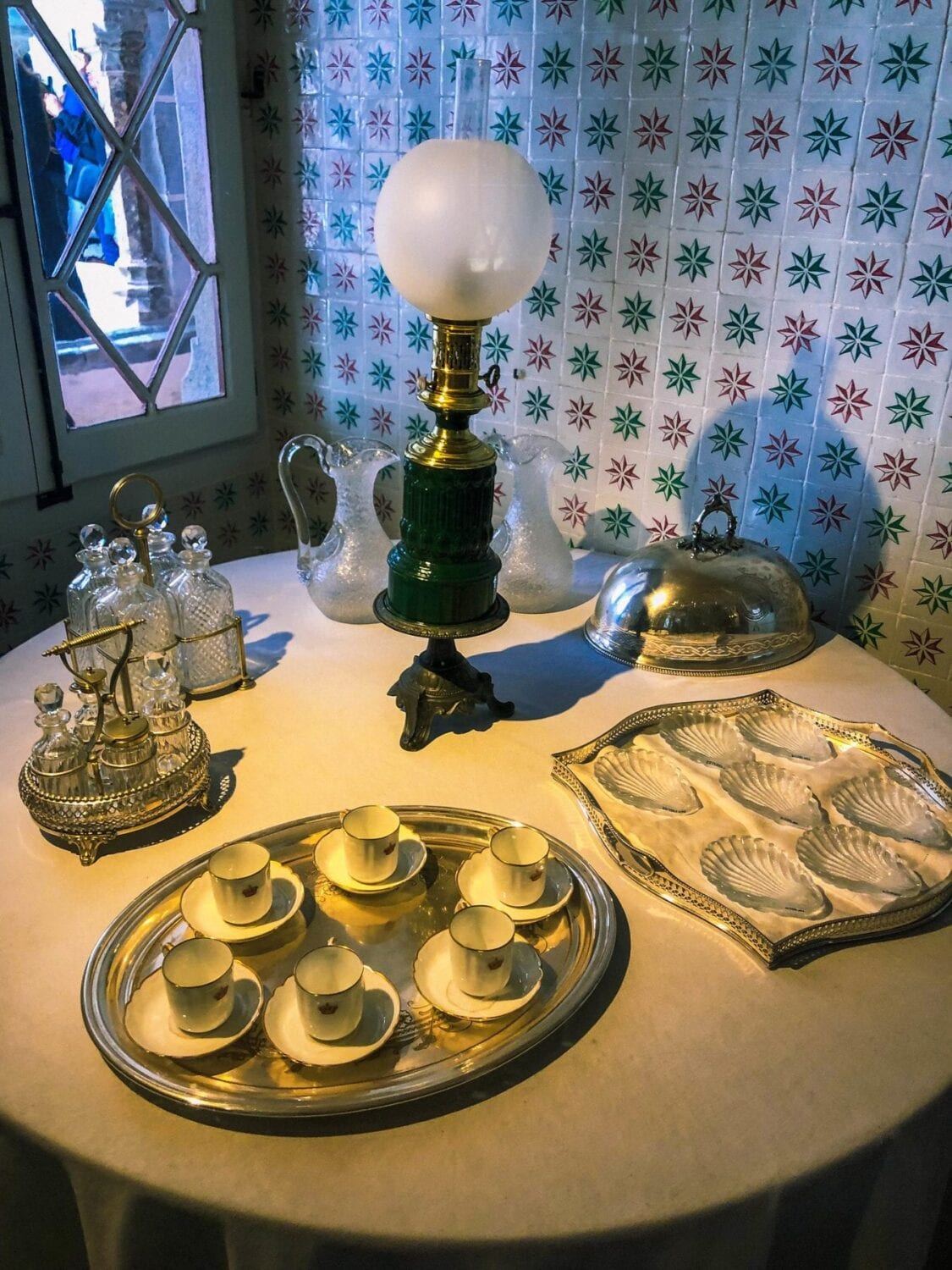
Dining Room
One of the most impressive rooms you’ll see on the first floor is the dining room. The dining room has the most remarkable ceilings made of intricate ribbed vaults and lined in tiles. The table is set like they’re still awaiting their visitors. Each piece of furniture was made for this exact space, the images of Portuguese animals of the forest carved into the backs of the chairs. The rainbow coloured glassware still catching the light white pours through the windows. Even from the other side of the room, you can see how truly amazing the view from the interior really is.
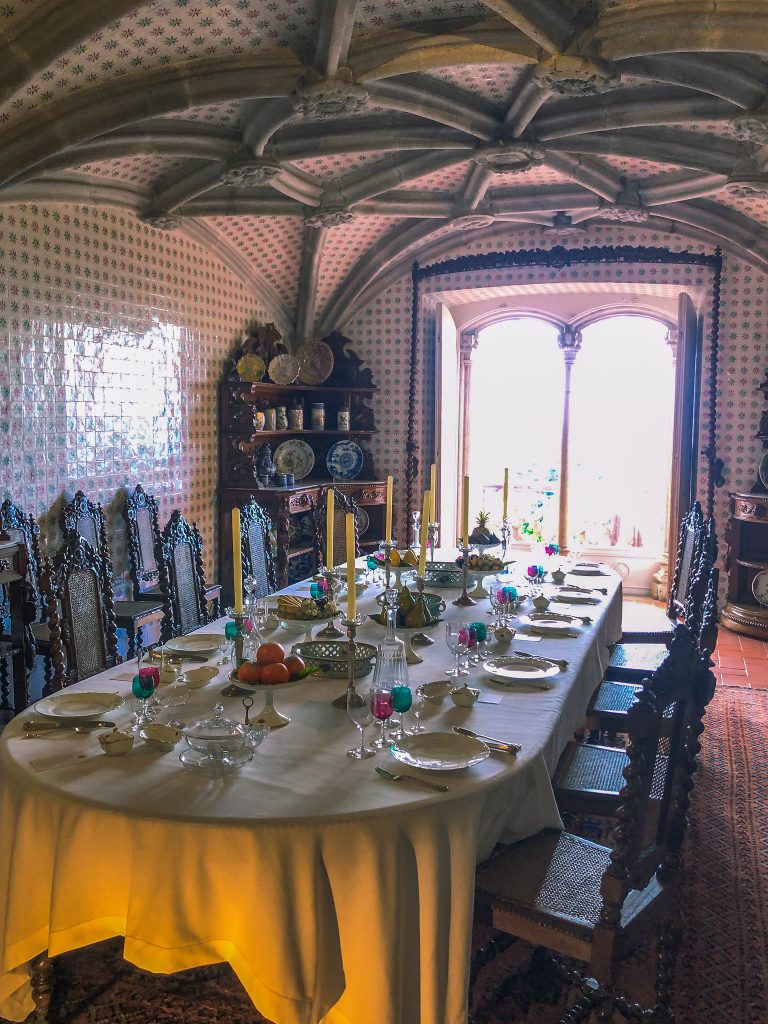
King Carlos’ Bedrooms
After the death of King Ferdinand II, the palace passed hands several times but eventually became the residences of King Carlos and his wife Dona Améli in 1890. The bedrooms and apartments on the lower floors belonged to King Carlos. These apartments were initially the former Chapter House of the Manueline monastery. They were used by King Ferdinand II as his servants quarters, but King Carlos actually preferred this more modest setting and left the upper more elaborate apartments for his wife. King Carlos’ bedroom is decorated in dark wood, with bright green accents. The Empire style was an early-nineteenth-century design movement which was inspired by Neoclassicism and Romanticism, and each piece of furniture in this room was designed within that style. On the walls, there are splendidly painted emotional landscapes, and throughout the room, classical sculptures of attractive women of mythology make almost any spectator blush.
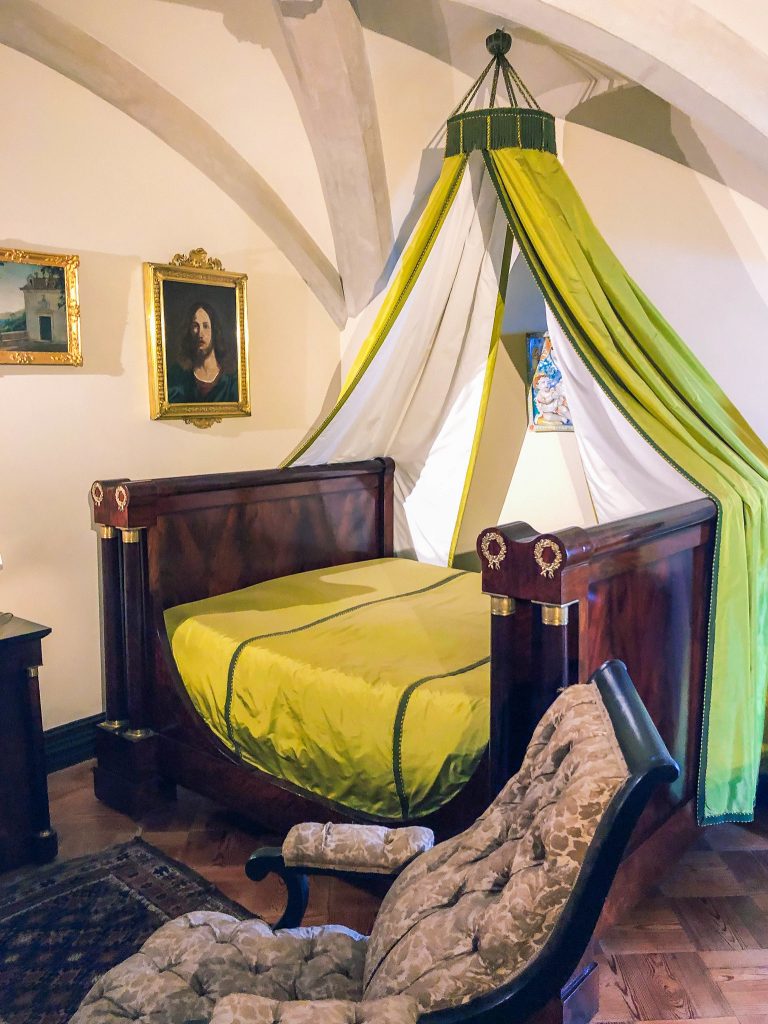
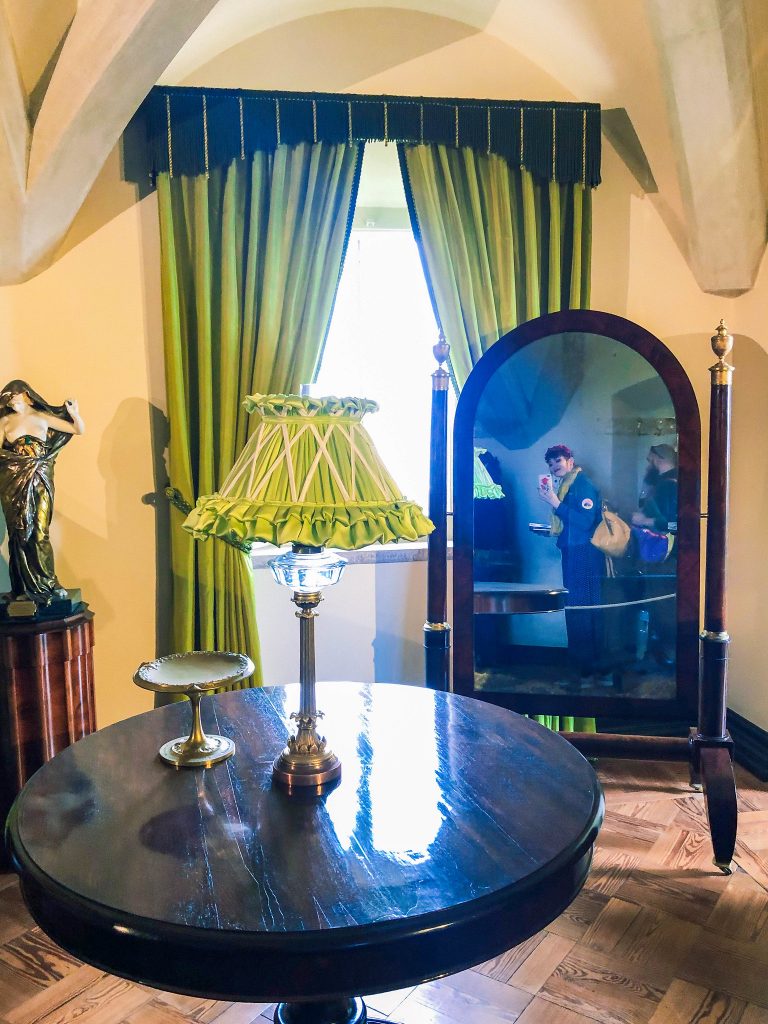
King Carlos’ Studio
The reverie continues into King Carlos’ studio. Here we find a mural painted across the entire room of nymphs and satyrs playing in the Park of Pena. This painting is believed to have been painted by the King himself, who was obsessed with filling his private quarters in these fantastical scenes.
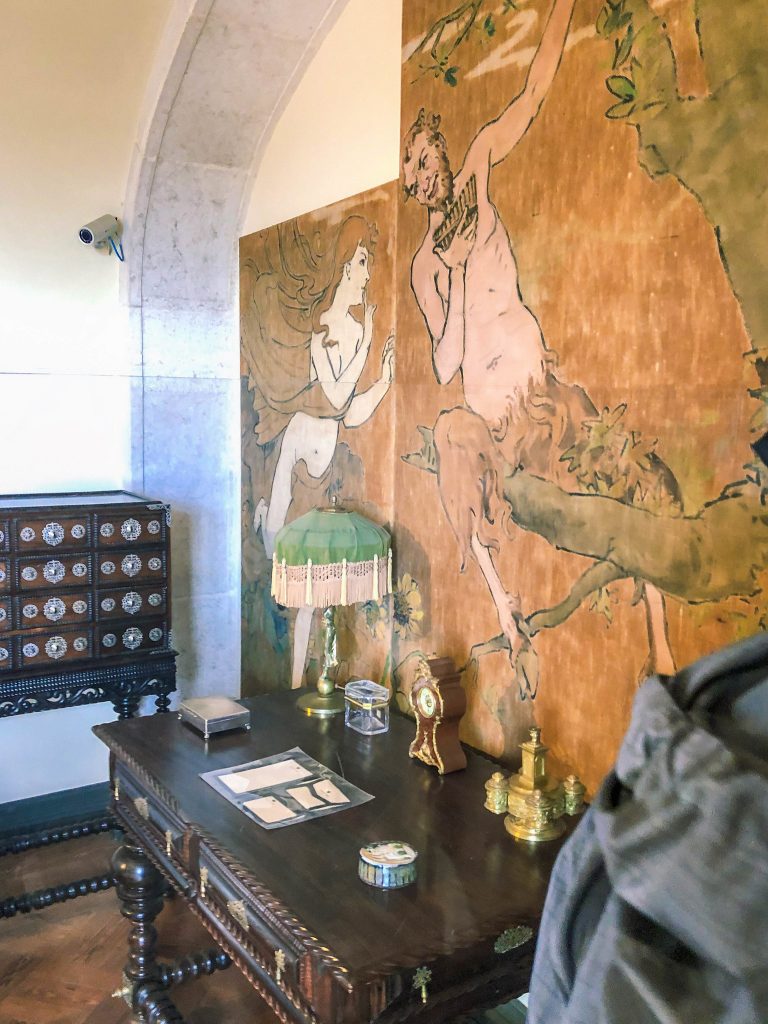
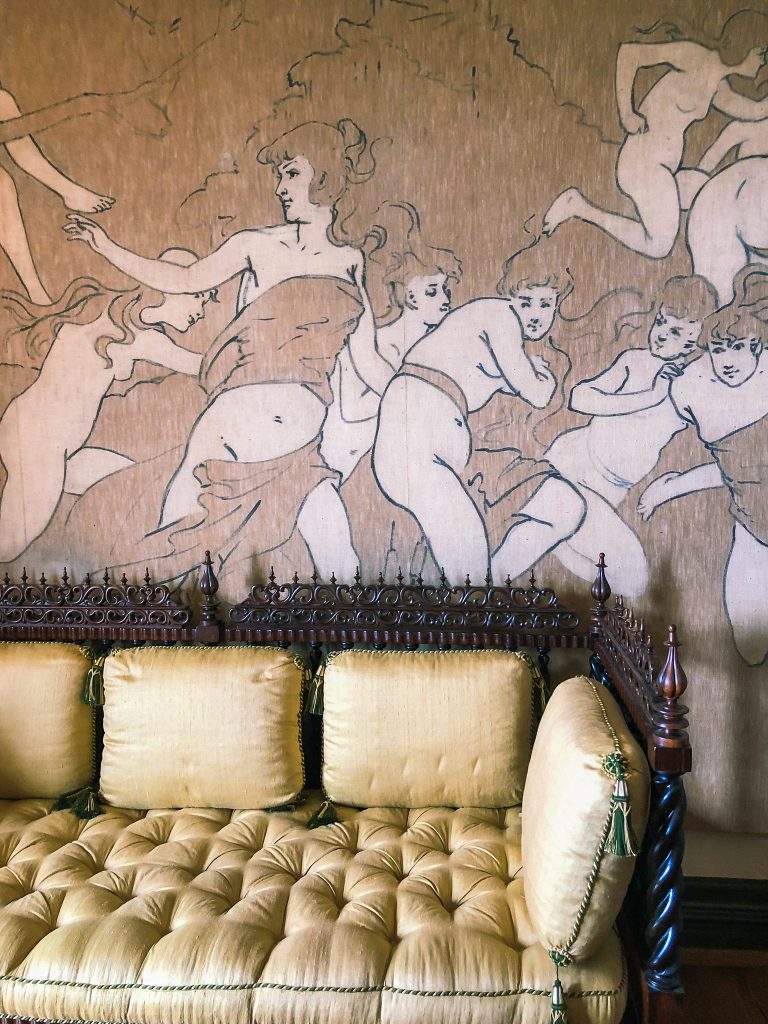
King Carlos’ Bathroom
Pena Palace was one of the first royal residences to have sanitation facilities specifically designed for personal hygiene. Despite being a bathroom, the room is nevertheless filled with decorative garnishes. The bathrooms are filled with luxurious furniture and lined top to bottom in the most exceptional tile work.
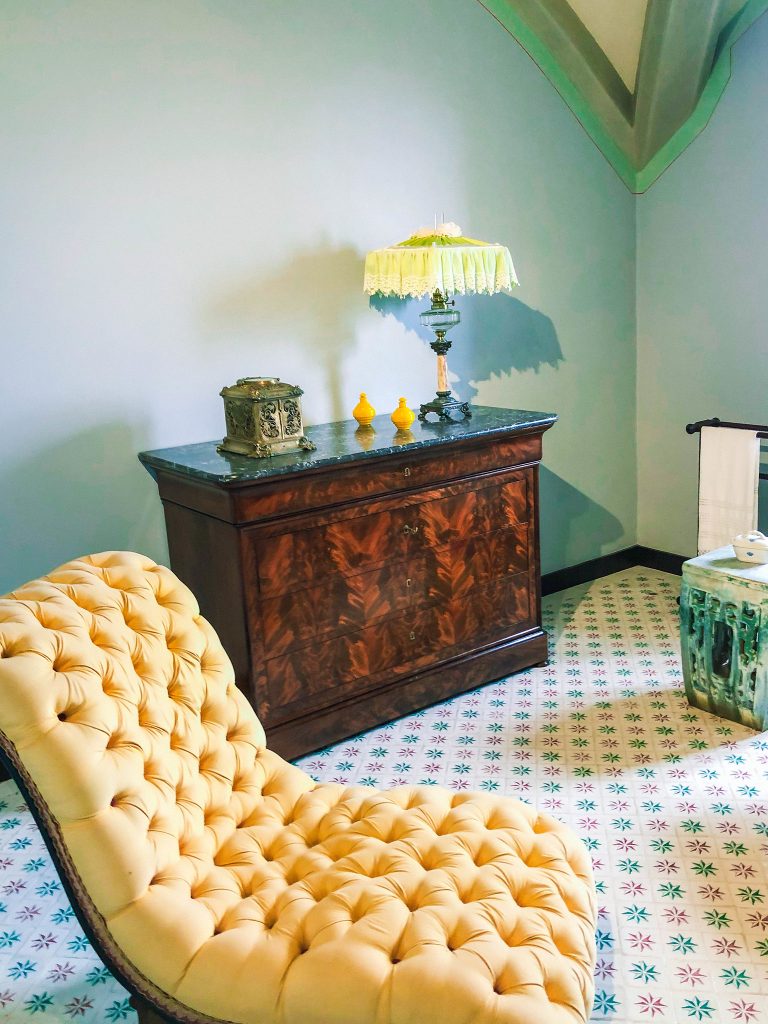
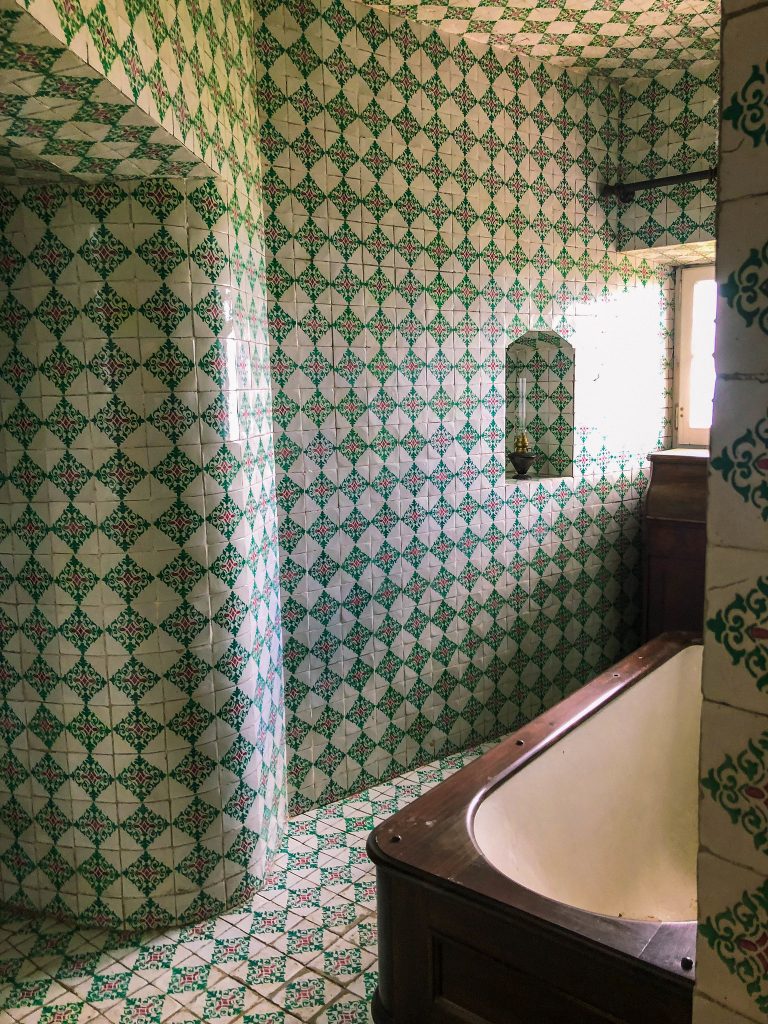
The Interior Niche
A small corner niche which you’ll see before going upstairs contains one of the oldest treasures of the former Monastery. This little niche features a mosaic wall decorated with shells, stones and porcelain pieces. Since it was transformed into a simple storeroom, there was no need to remove the old decor to make way for more modern decorations therein preserving its history for the modern era.
Bedroom of the Queen’s Secretary and Ladies-in-Waiting
Next, we head upstairs to find Queen Amélia’s apartments. The first room we enter is the bedroom of the Queen’s ladies in waiting. Initially, when King Ferdinand II lived here with Countess of Edla, this room was a small dressing room, but when Queen Amélia moved in, she required more space for her servants and noblewomen. One of the most beautiful objects in the room is the Indo-Portuguese rosewood bed, carved to perfection like the wood was made from butter. Above the bed are plastered a knotted row of branches which blossom with hundreds of pine cones so lifelike you’ll think they might fall down upon your head.
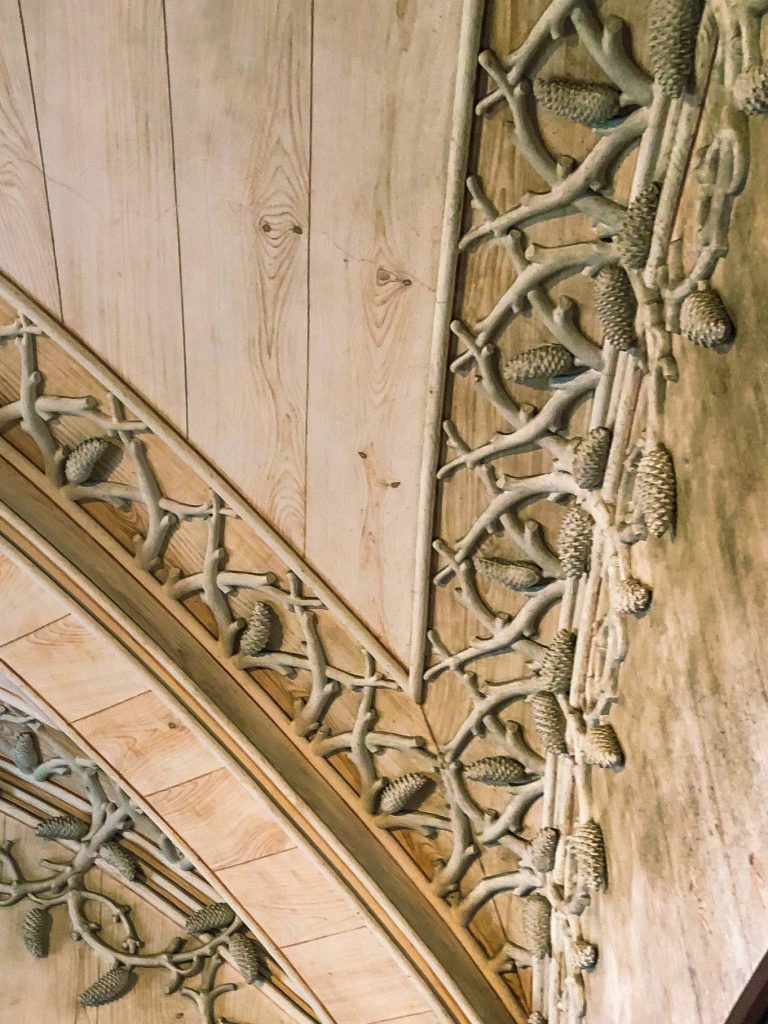
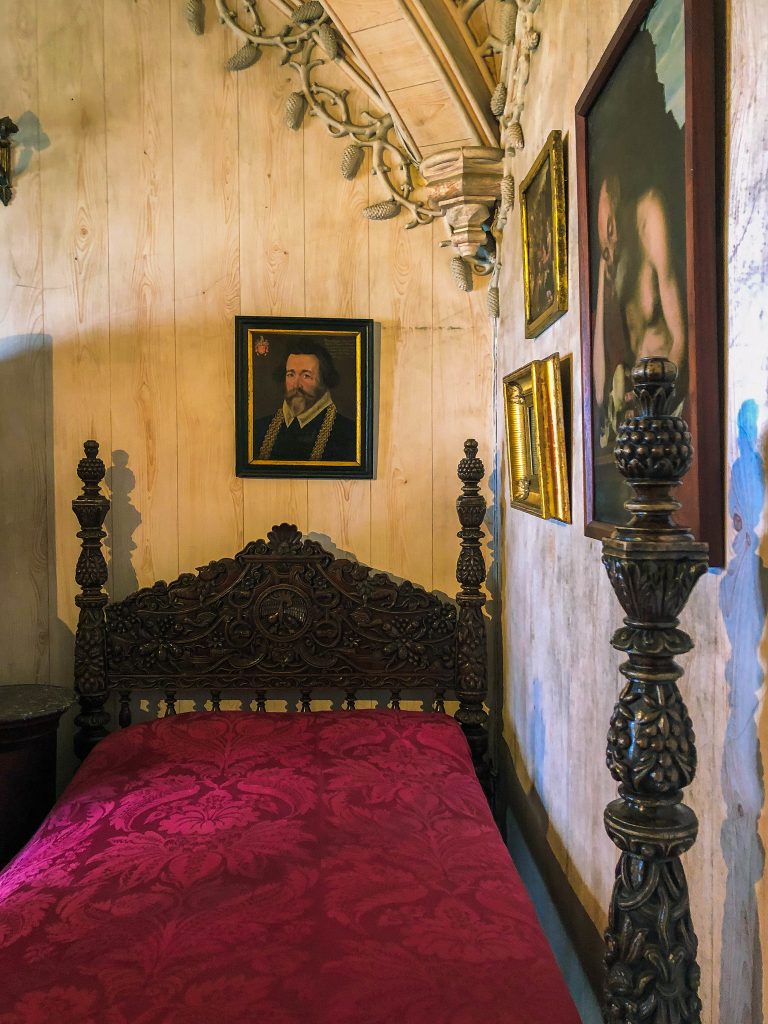
The Queen’s Withdrawing Room
The yellow room adjacent is the Queen’s Withdrawing Room. It features a stunning bunting of plaster roses which hang from the crown moulding. Rose motifs are etched into almost every inch of the vaulted ceiling. More proof of Ferdinand’s obsession with romanticism and bringing nature into the interior of the home.
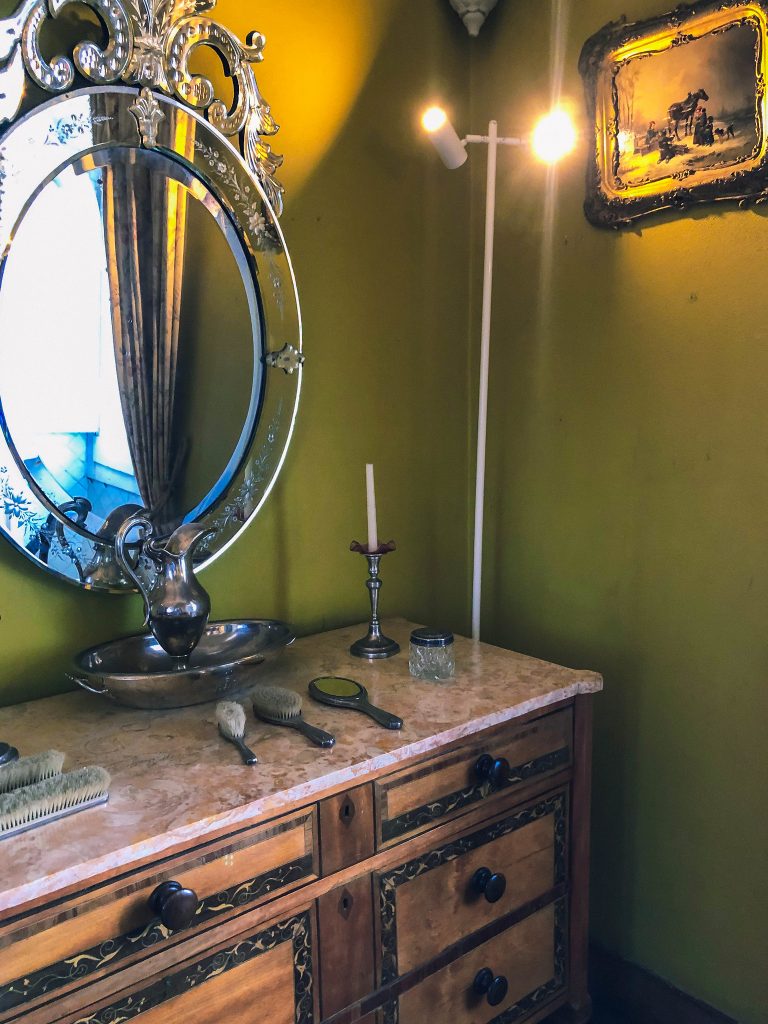
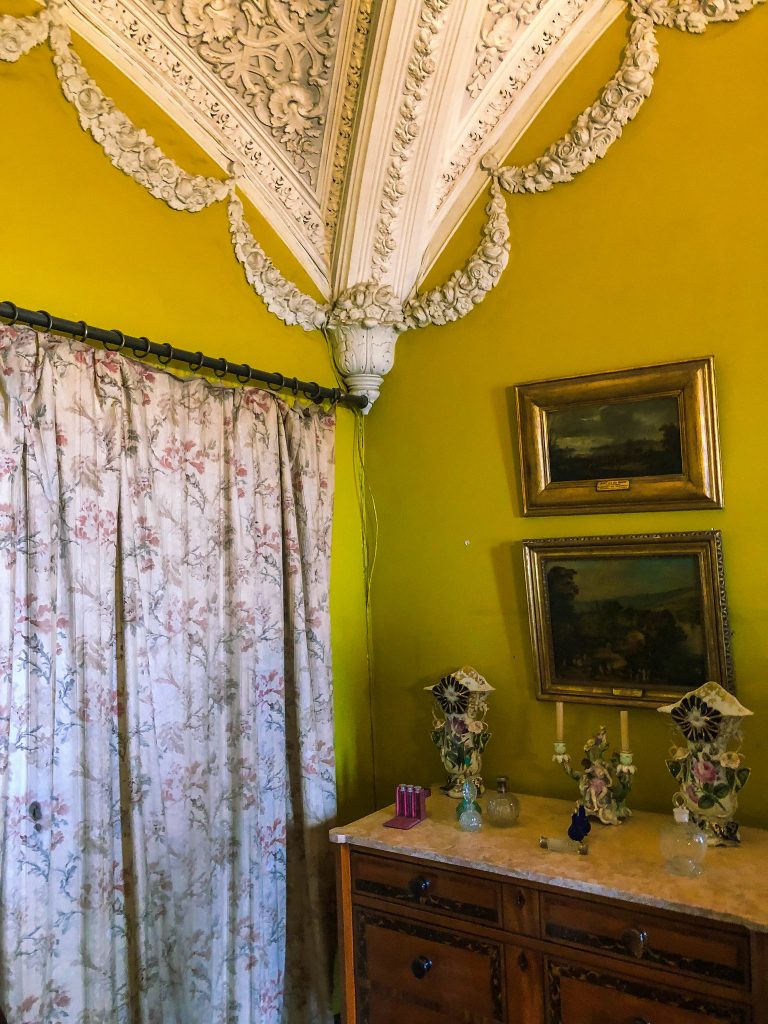
Queen’s Bedroom
The most opulent of all the rooms in the Queen’s bedroom. Moorish decorations cover the walls and ceiling in a way that literally makes your jaw drop. Geometric patterns repeat on the roof and spread out onto all the walls below. The designs are centred around bright gold stars covered in sumptuous gold leaf. The dark wooden bed is given a baroque treatment with swirling bedposts and a headboard which surges and swells like the waves.
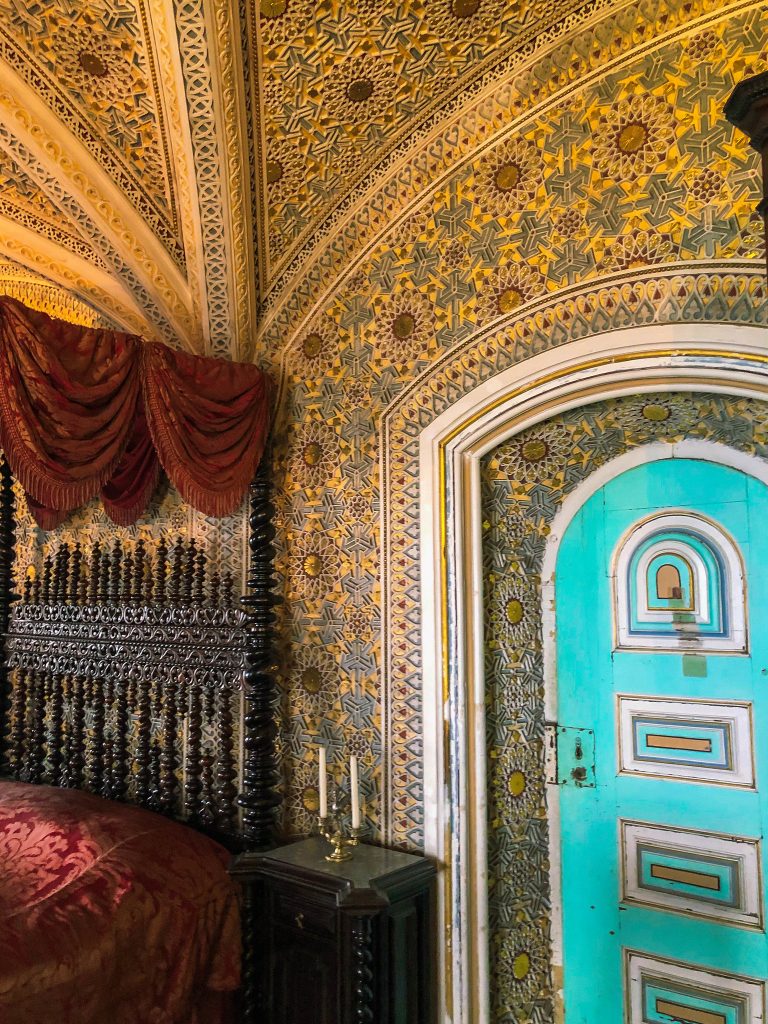
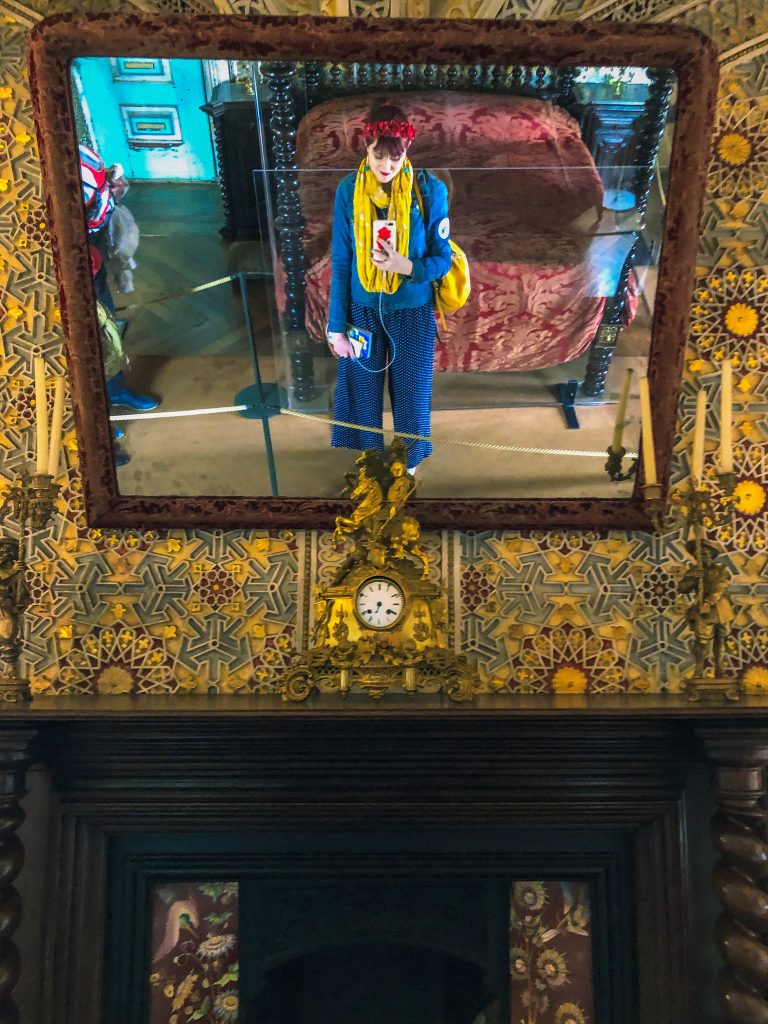
Study of Queen Amélia
Outside the bedroom, you’ll find the study of Queen Amelia. Originally this was the music room, a room which acted very similarly to a modern day living room. This was where the family would listen to various musicians play traditional Portuguese instruments. Eventually, the room was transformed into the Queen’s study. Today, it is used to display silverware, weaponry and even the desks and stationary of Queen Amélia. The room’s wallpaper is made to look like carved stoned with faux azulejos in green and white accents.
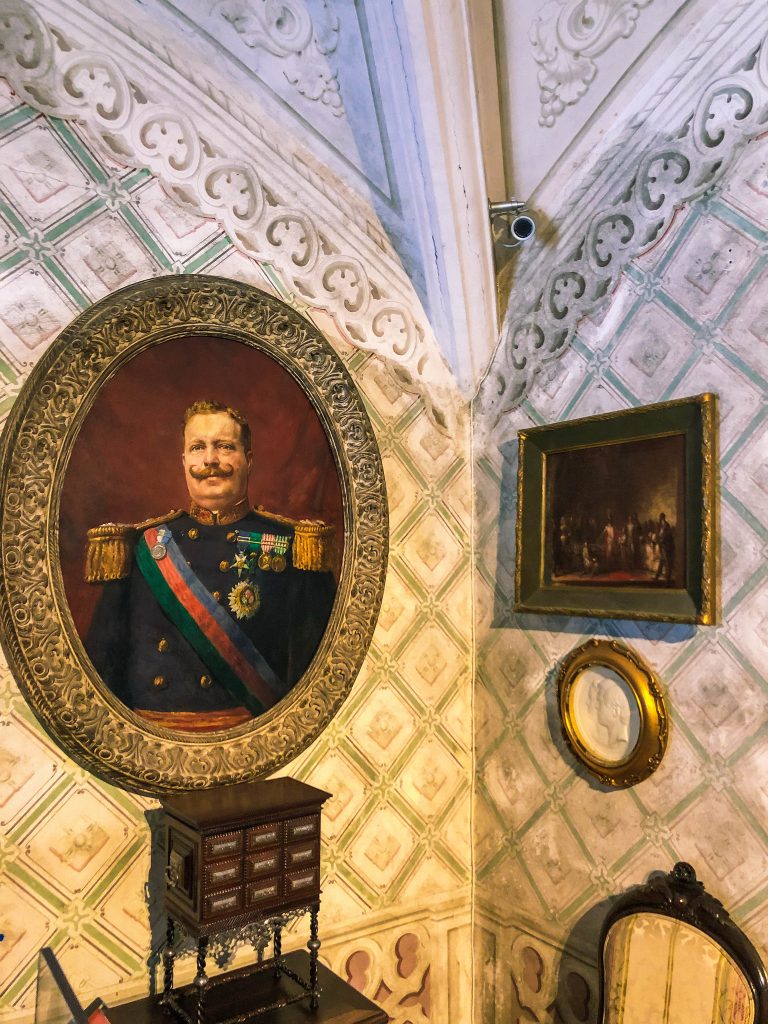
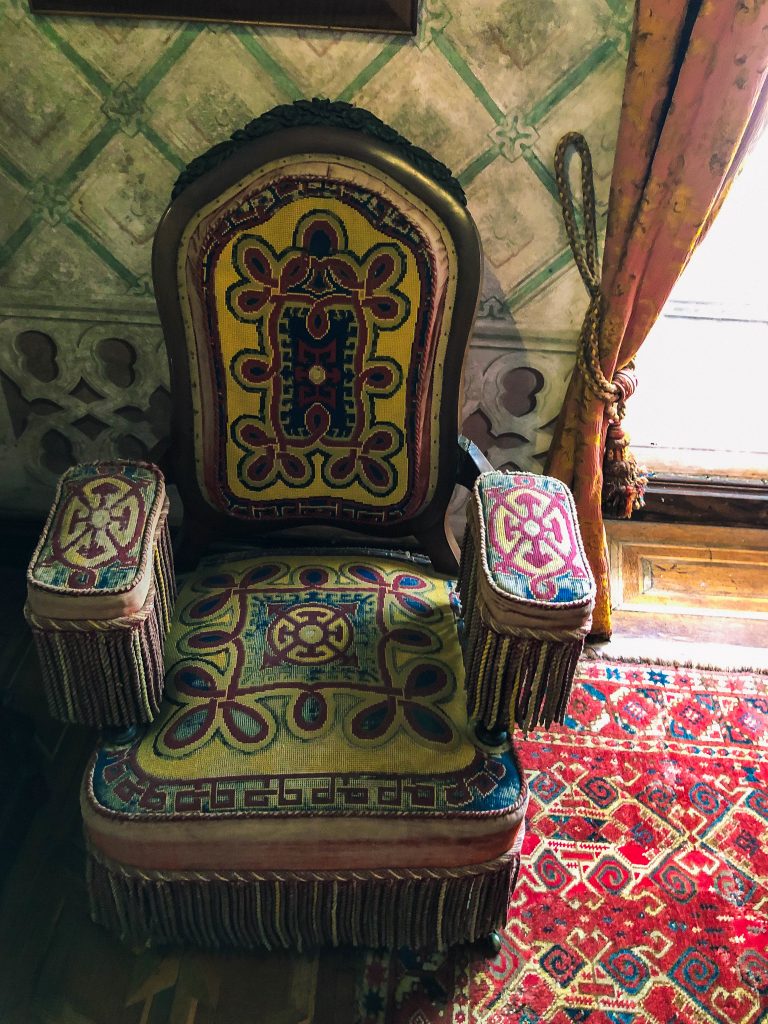

Green Room
The green room provides another brilliant example of Trompe-l’ œil. Here the wallpaper is made to replicated flowers and branches as well as traditional architectural carvings. Although some of the paint is peeling, I love how this part was left unrestored as it makes the building feel more authentic and shows its real age!
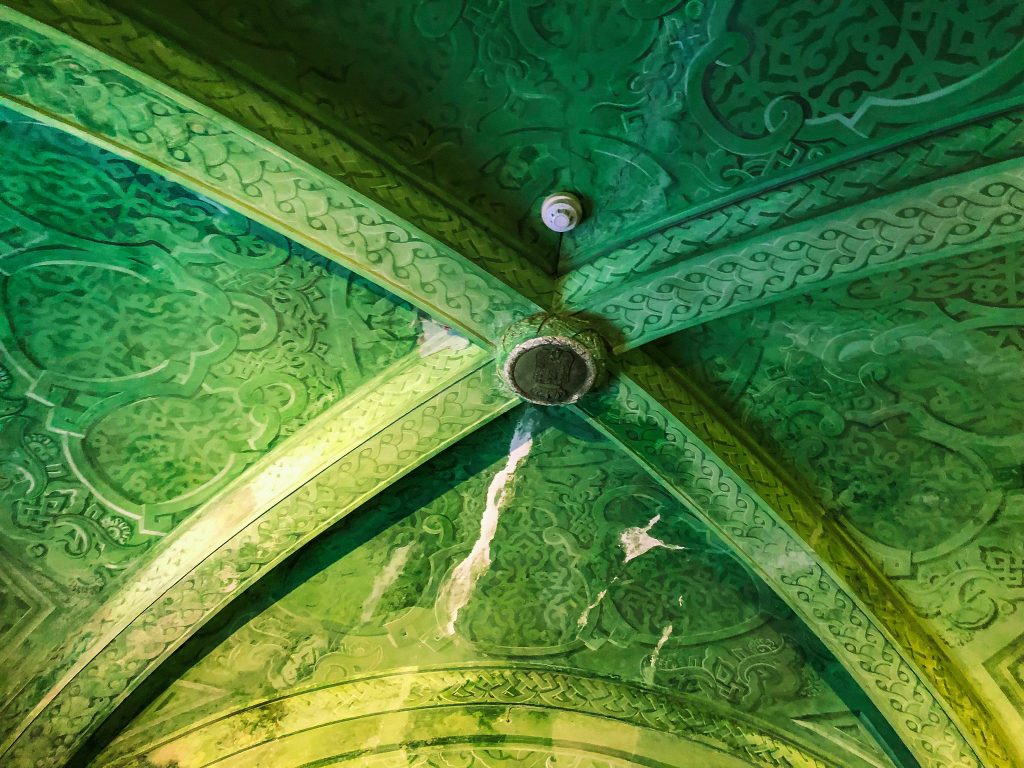
Arab Reception Room
Past the royal chambers, we find the Arab Reception room. Looking at this room from afar you might be fooled into thinking the walls open up to the exterior and the ceiling is fantastically carved. But in fact, these are all optical illusions. This technique is called ‘Trompe-l’ œil’ which is French for “to deceive the eye”. Objects which exist in three dimensions are here created in a two dimensional forced perspective with nothing else but paint. The paintings were made in 1854 by esteemed Italian scenographer Paolo Pizzi. This technique was employed to make otherwise small spaces to make them feel grandiose to the guests who would be received for the first time in this room.
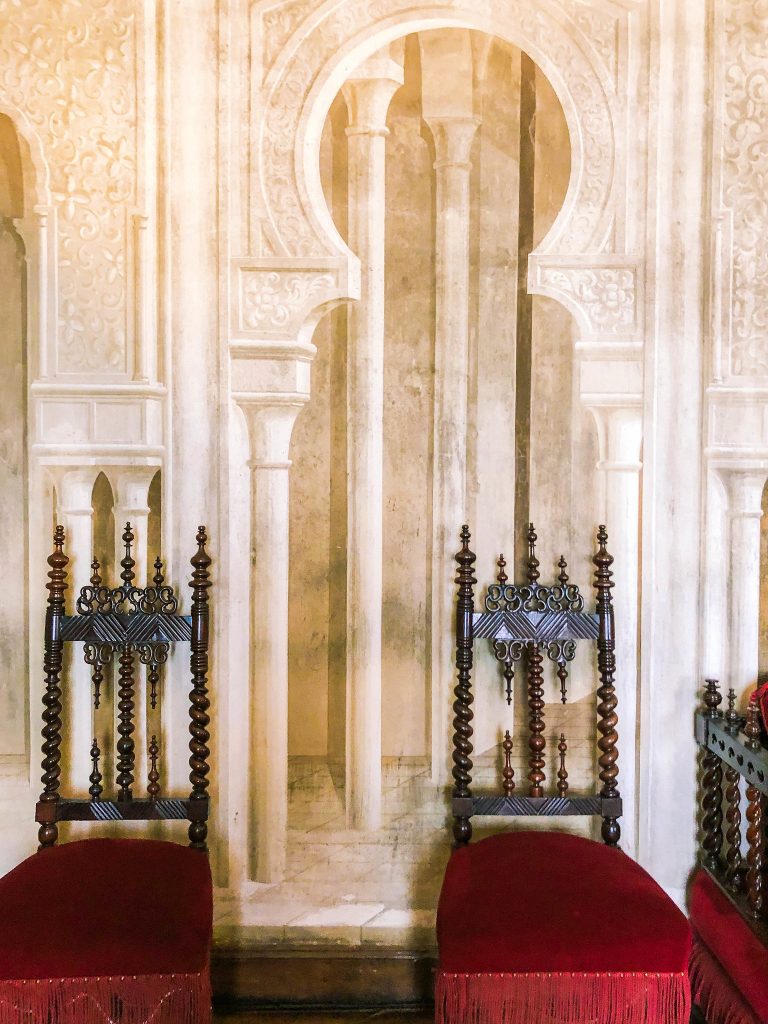

The Galleries
The next few rooms were once used as the abbot’s suite when the building was a monastery. These now contain different trinkets, treasures and works of art which belonged to King Ferdinand II. This part of the tour felt so special since you were looking at all these personal items which help you understand the personality of the man who once owned this castle. The little things which make a house, a home.
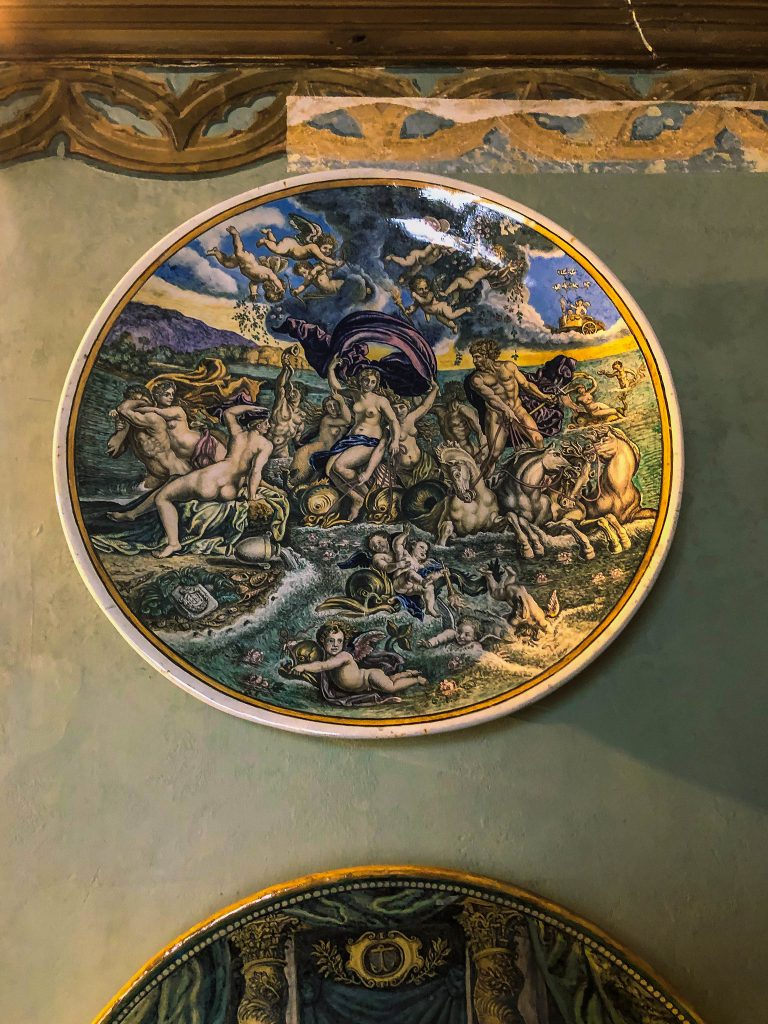
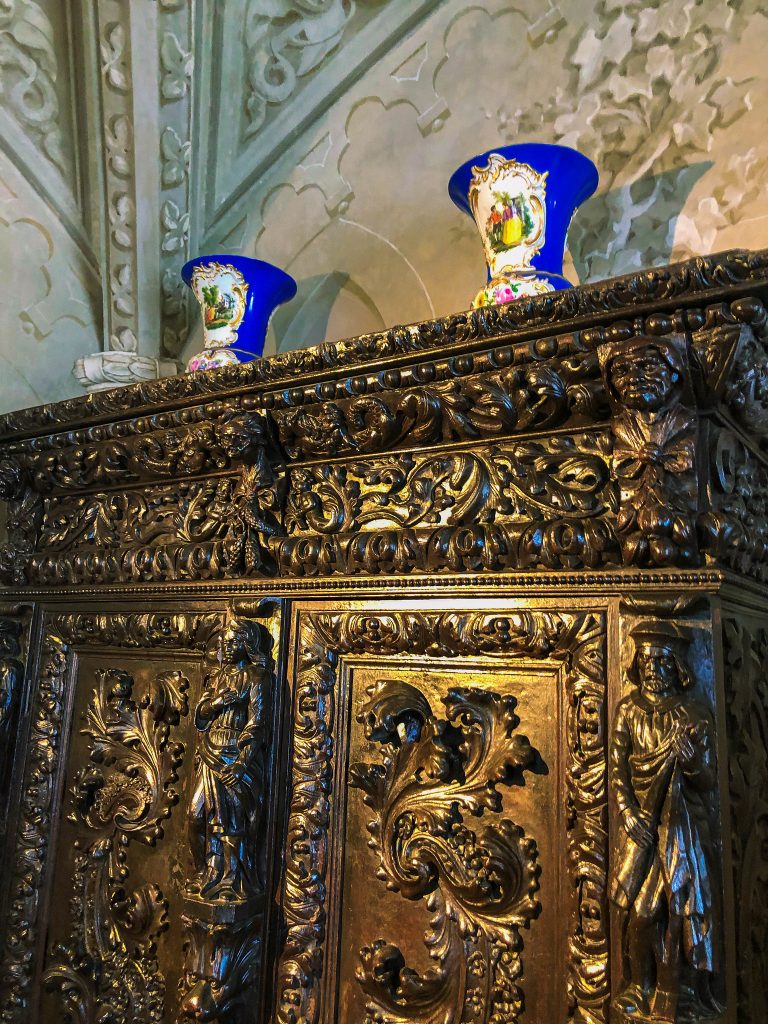
Smoking Room
In the smoking room, we find a vast Islamic dome covered in Mudejar art. A stunning neo-rococo chandelier hangs from the ceiling, covered in Venetian glass in the shape of ivy climbing all over the wrought iron frame. The candles site inside morning glory flowers, also made from that fantastical Venetian glass. The white walls are covered intricate textures which were created to replicate the look of traditional Indian lacework. This was my favourite room, it felt both immensely regal, which also being restrained and demure.
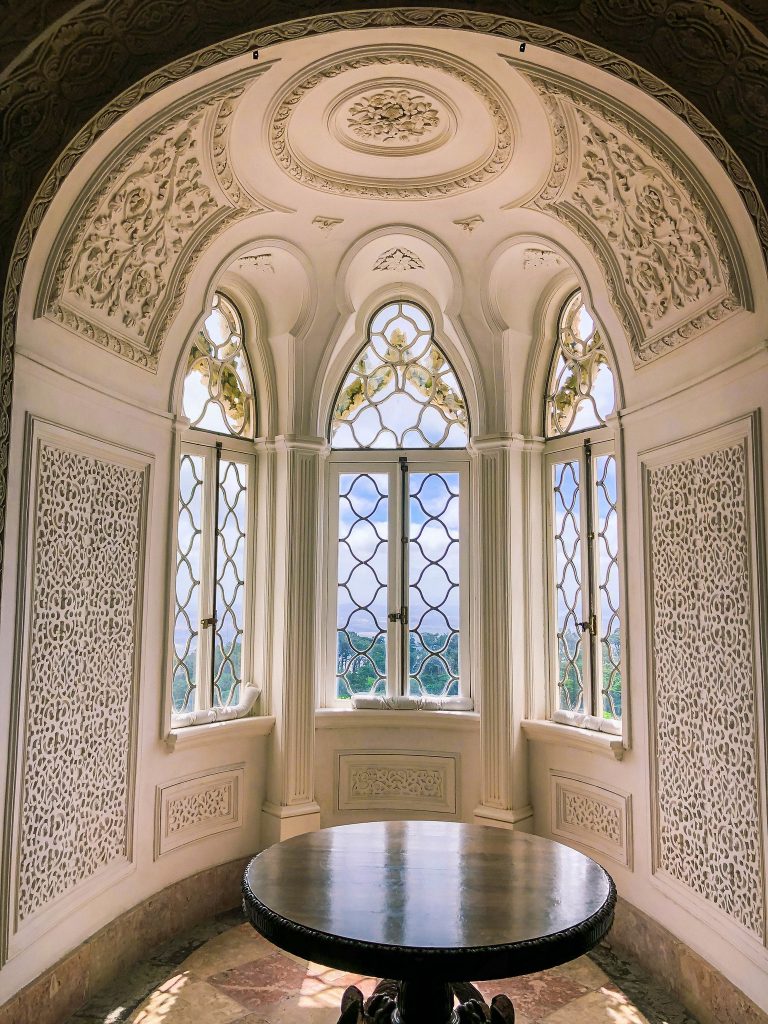
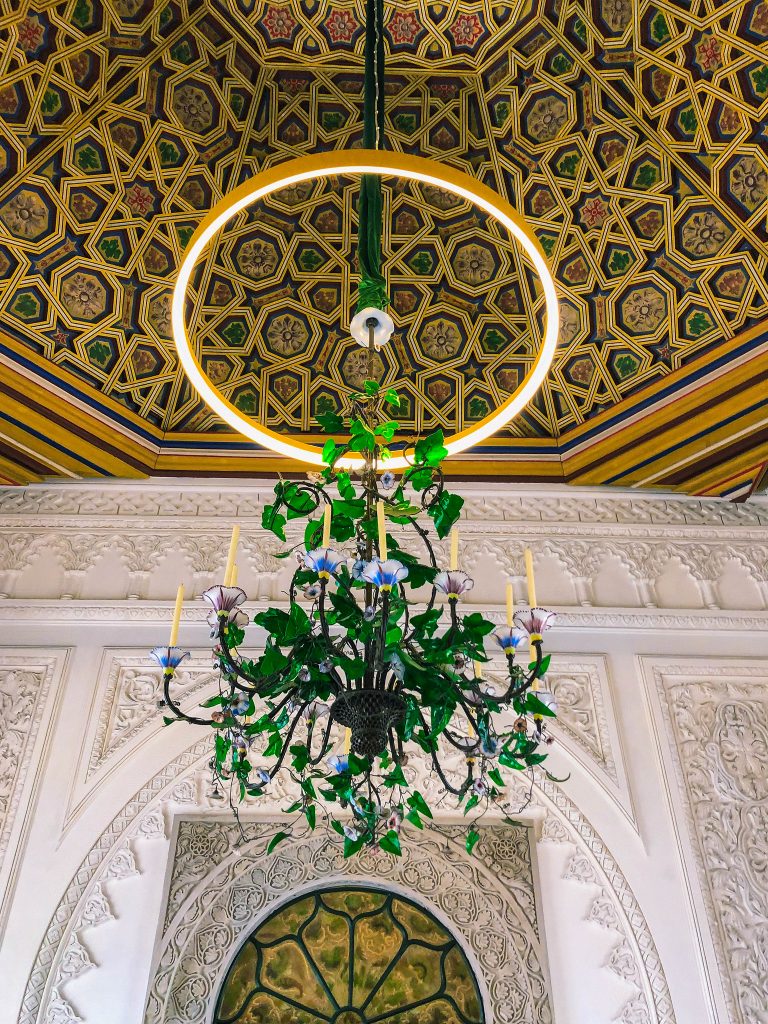
Queen’s Terrace
The Queen had access to one of the most astonishing parts of the castle, the south facing terrace. From here she could look out over the majestic Sintra countryside and the castle’s exceptional architecture. During the reign of King Carlos and Queen Amélia, there was a large metal structure erected on the terrace so the king and queen could entertain their guests outdoors during the summer. In the centre of the terrace are a large sundial and solar quadrant which once fired a small cannon throughout the day to announce the presence of the royal family or visiting dignitaries.
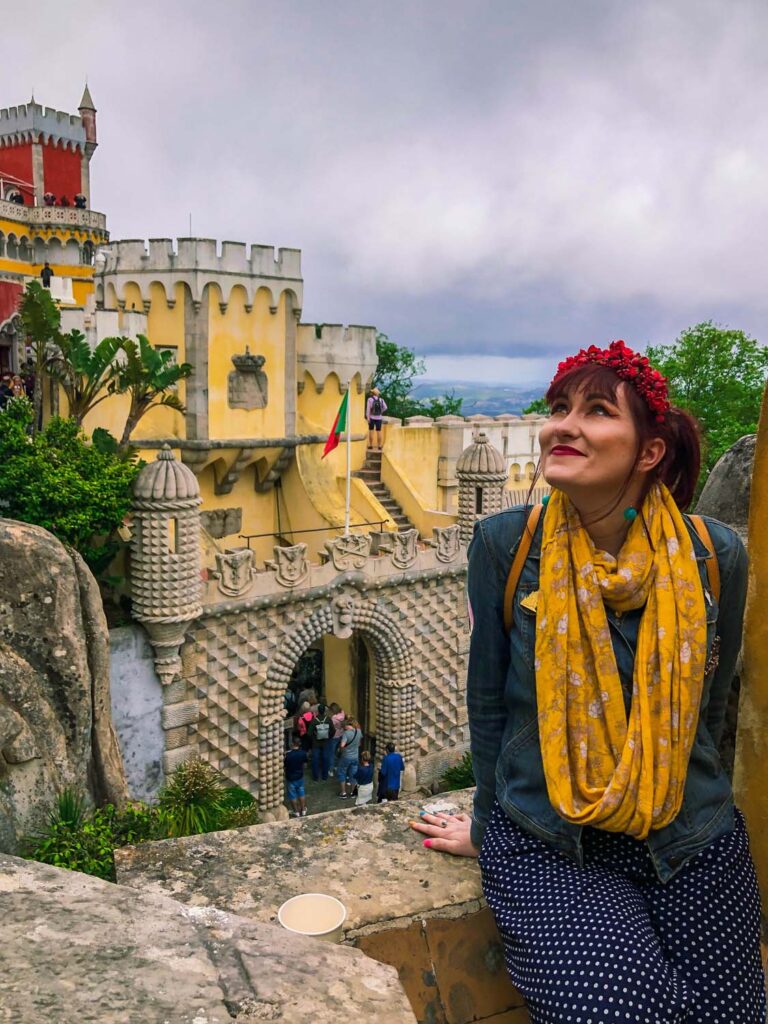
Noble Hall
Upstairs, Noble Hall is one of the most impressive spaces in the palace. Compared to the relatively small sized bedrooms, this receptions hall was where the King took advantage of space. It was here where large parties were thrown, and the who’s who of Lisbon’s high society would come during the summer.
The Noble Hall was inspired by the Ottoman Court. Iron replicas of Turkish kings are located on either end of the room, in their hands, they hold huge golden torches. Rich, red leather sofas on either side of the hall were designed with mirrored canopies behind them to make the room appear much larger than it is in reality. It was also an excellent way for the elite to spy on those around them and see just who is sharing secrets with who.
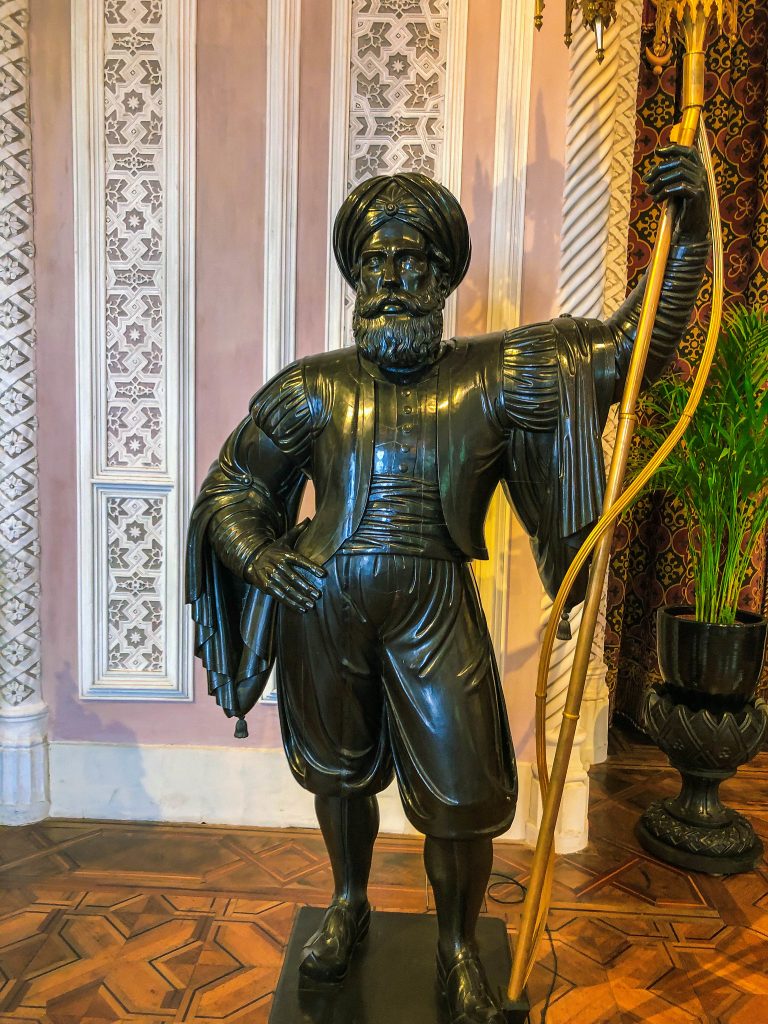
Stag Hall
One of the last rooms you’ll see is the Stag Hall. Originally it was supposed to be the banqueting hall, but construction was halted, and it never came to be. The central column, designed to looks like a giant tree trunk, was going to be the enormous round table which guest would eat around like knights of stories past. On all the walls there would have been antique weapons on display, and each of the windows would have contained pieces of archaic stained-glass themed with heraldic motifs. Since this new part of the castle was never finished, it remains somewhat unfinished looking with only stuffed deer trophies decorating the plain white walls and glass display cases featuring the pieces of stained glass planned for the windows.
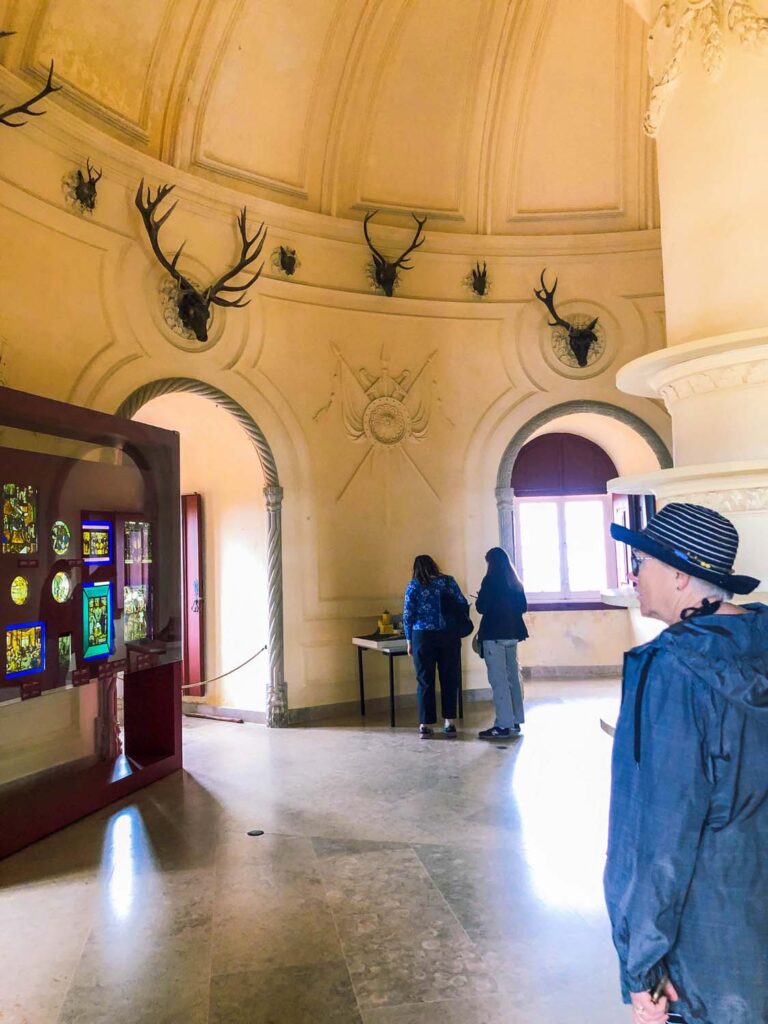
Kitchen
The last room you’ll see is the old kitchen, a real hit with chefs and foodies. In here are all the original kitchen utensils, pots and pans and other old-fashioned culinary tools found in this old Portuguese kitchen. The kitchen felt enormous compared to the rather small interior rooms, but it must have taken an army to feed the great parties which were no doubt held here. The new kitchen was designed to be close to the Stag Hall since it was meant to be the main dining area, but unfortunately for the poor chefs, this never came to be.
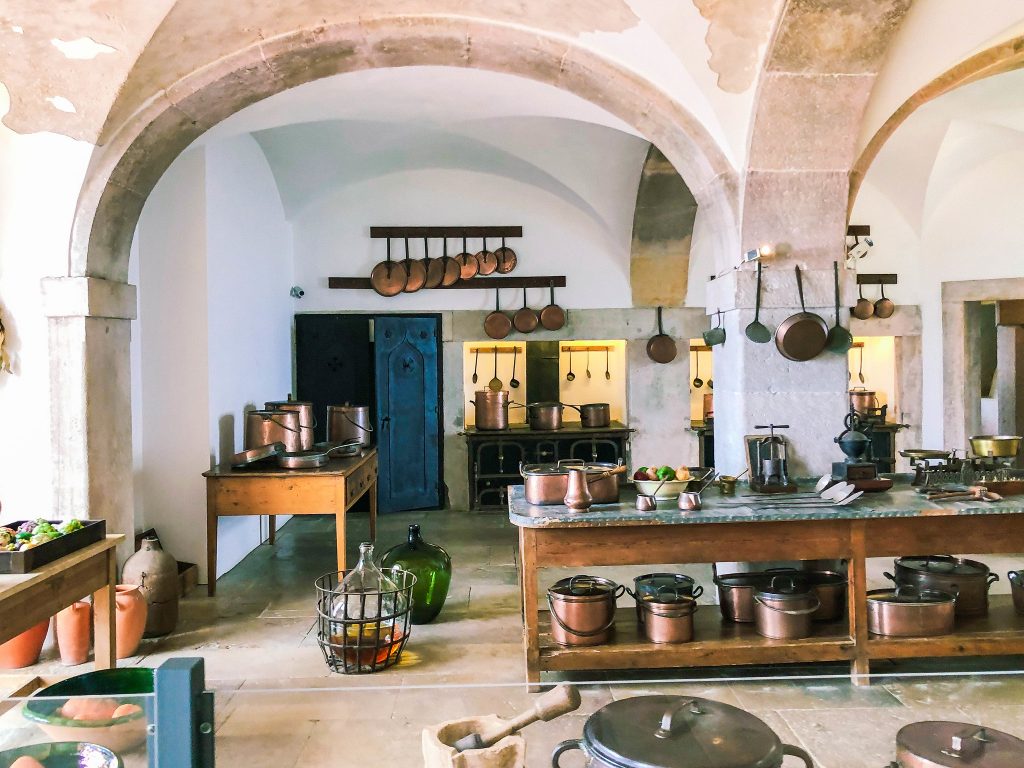
Cafe and Restaurant
After touring the castle, the cafe located on the terrace is a great spot to grab lunch. Although the restaurant here is rather expensive, the cafe is surprising cheap with a selection of delicious Portuguese pastries, sandwiches and more. If you brought your lunch, this is also an excellent opportunity to break out the picnic. While there might be better places to eat in town, it would take ages to get there and back so instead, enjoy the regal atmosphere around and soak in the view.
Gardens of Pena Park
After finishing up at the palace, it’s now time to explore the gardens of Pena. The map they give you when you enter is really confusing, so its best to just keep that adventuring spirit in front of your mind and just wander the park. Don’t worry about getting lost, you’ll eventually stumble upon some signage, which always helped us get back on the right track. The gardens cover over 85 hectares of land around the castle. If you love hiking, you should definitely try to come out here and explore the entirety of the park. This could take you all day and is certainly not for those in a rush, but if you have the time to space, there are so many amazing things to discover.
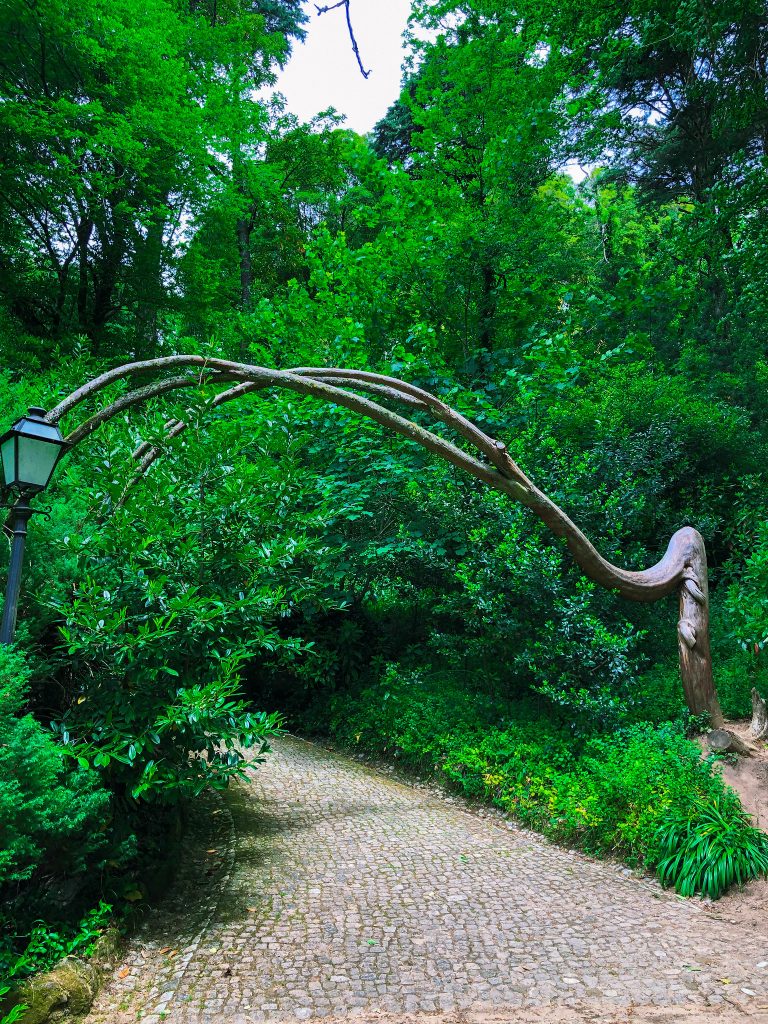
Cruz Alta
You can hike to the very top of the gardens to find the Cruz Alta, located 529 metres above sea level. This stone cross is situated at the highest point of the Sintra hills. The cross is made of intertwined branches and created to mark to the where the explorer D. Joao III claimed this land for Portugal. Another famous landmark is the Statue of the Warrior. This stunning granite sculpture made in 1848 by Ernesto Rusconi is of a non-descript knight who represented all those idealized, romantic notions in which the parks and palace sought to embody.
Compared to the hundreds of people at the palace, these winding pathways around the gardens felt like your own private area. We were often the only ones there, and in spite of the confusing map, we had a blast exploring and getting lost all along the way. Ferdinand wanted these gardens to feel like wandering through a romantic forest where you wouldn’t be surprised to come upon nymphs drinking spring water from the fountains or unicorns grazing on fern trees.
Greenhouse
The Hot House, or greenhouse, can be found just past the Camellia Gardens. The greenhouses’ importance is notable by the fact that it is surrounded by large stone walls which aim to protect and highlight this spot. The greenhouse was equipped with its own plumbing system, and you can find the old furnace outside which was used to heat the greenhouse throughout the year. This was used to keep those precious flowers which needed warmth, safe throughout the colder winters. Having this greenhouse meant that Ferdinand could grow many different impressive flowers and trees, which otherwise would have been impossible to flourish outside of their natural environment. One more example of how this palace made the impossible possible.
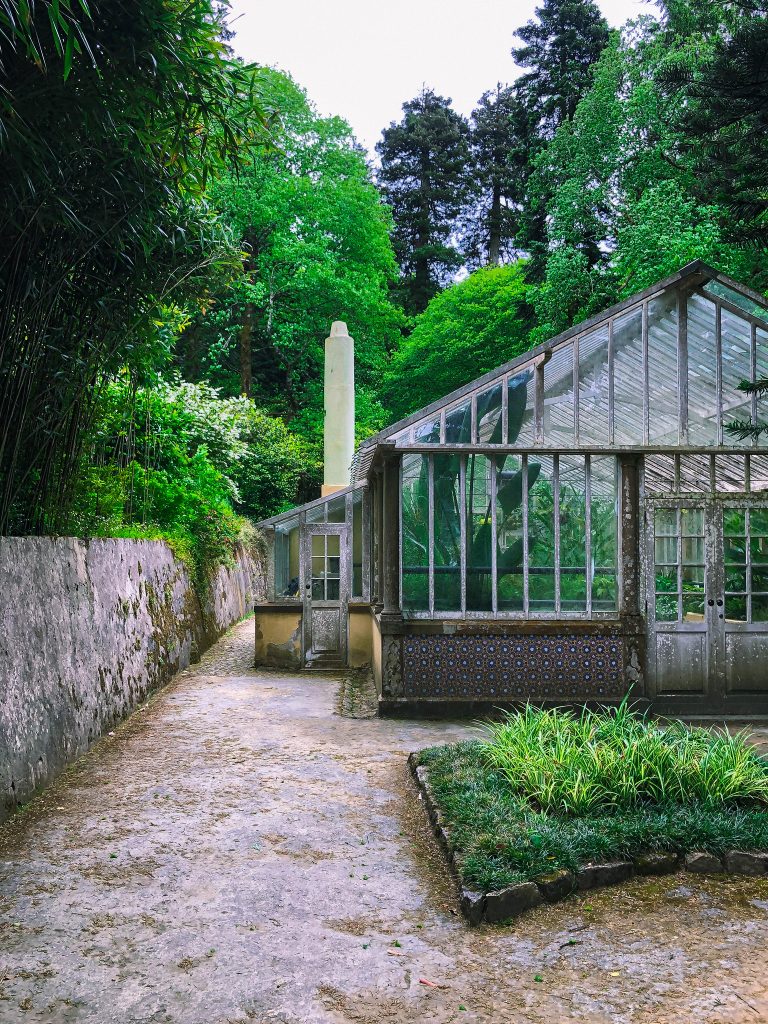
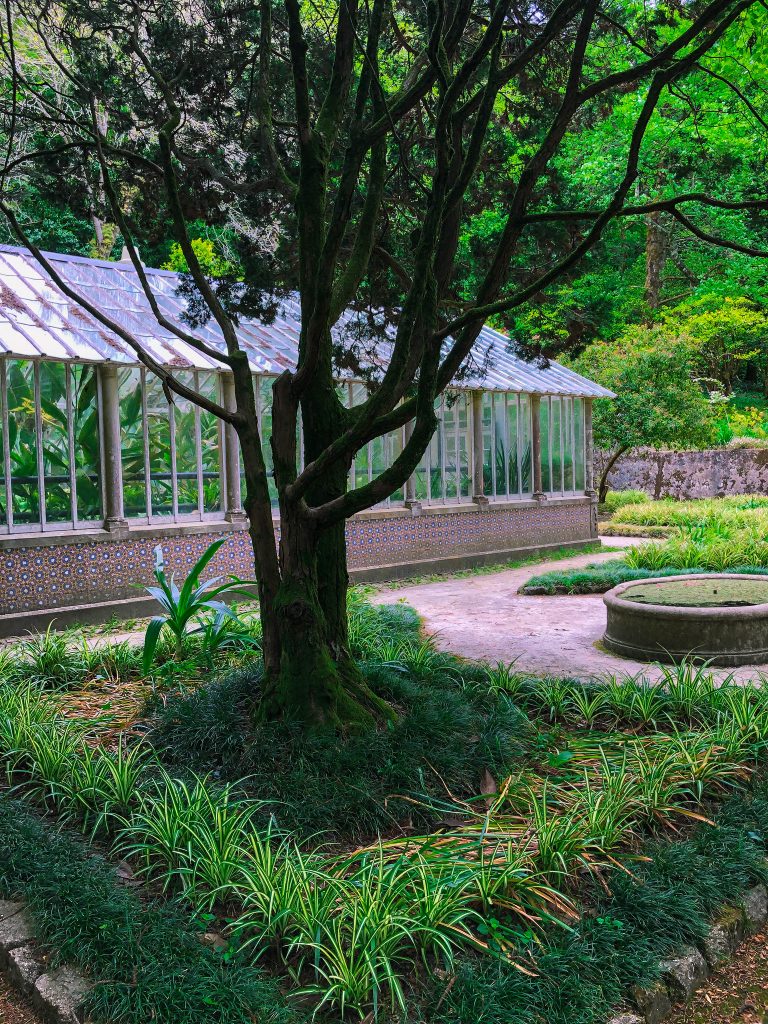
Throughout the garden, you’ll spot everything from magnolias, Japanese Cryptomeria, Chinese ginko, American sequoia, cypress, red cedar, as well as tree ferns from New Zeland and Australia. No matter what time of year you come, there is almost always something flowering.
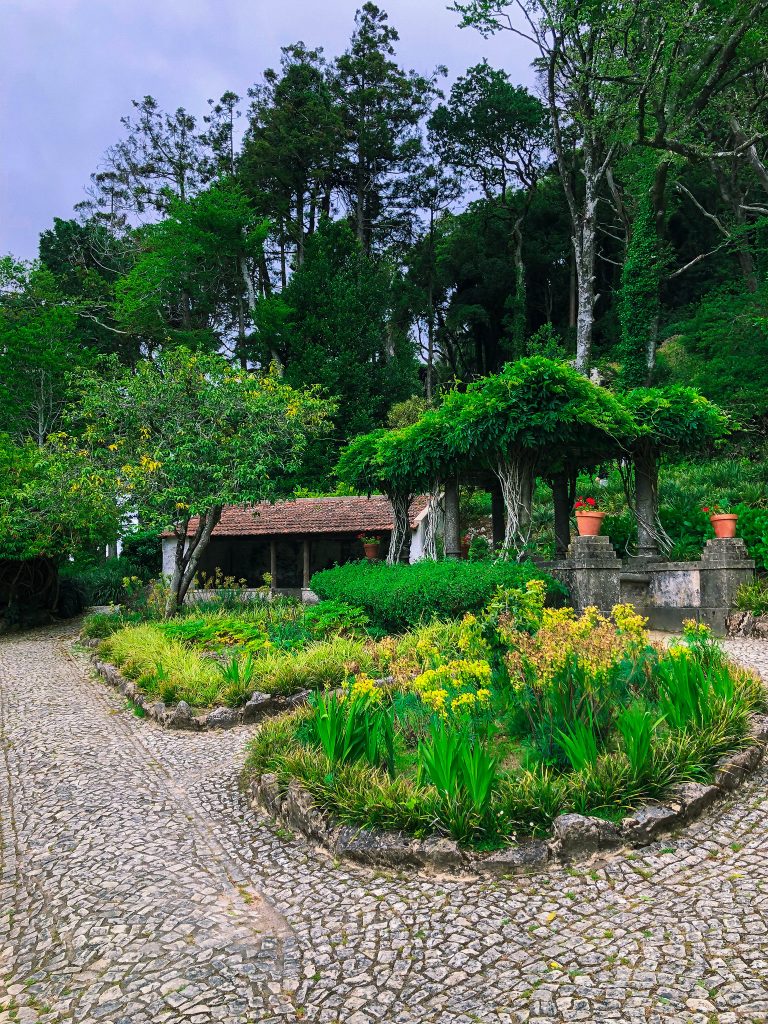

Islamic-style domed pavilion
In the lower portion of the gardens, you might be surprised to find an Islamic-style domed pavilion. Around the edge of the dome, written in Arabic are the words “The Sultan D. Manuel built this chapel blessed in the name of Our Lady Mary of Pena, in the year 1503, in celebration of the safe return of Dom Vasco da Gama’s discovery of the lands and countries which he found…” The King was never a Sultan, but it’s just one more way that we can see how Ferdinand really loved a fairytale story, even about himself.
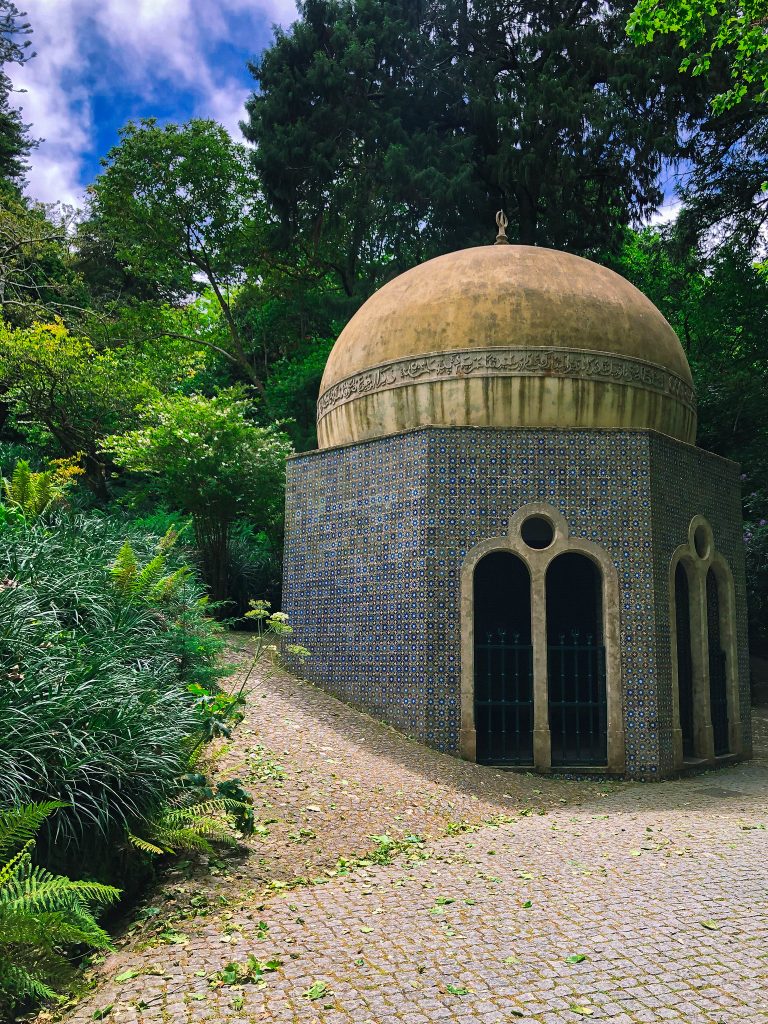
Further down, closer to the roadside entrance to the park, you’ll find the Grotto of the Monk. This was once a modest medieval garden where the Hieronymite monks would come to retreat the monastery and meditate in the peace and quiet of the forest.
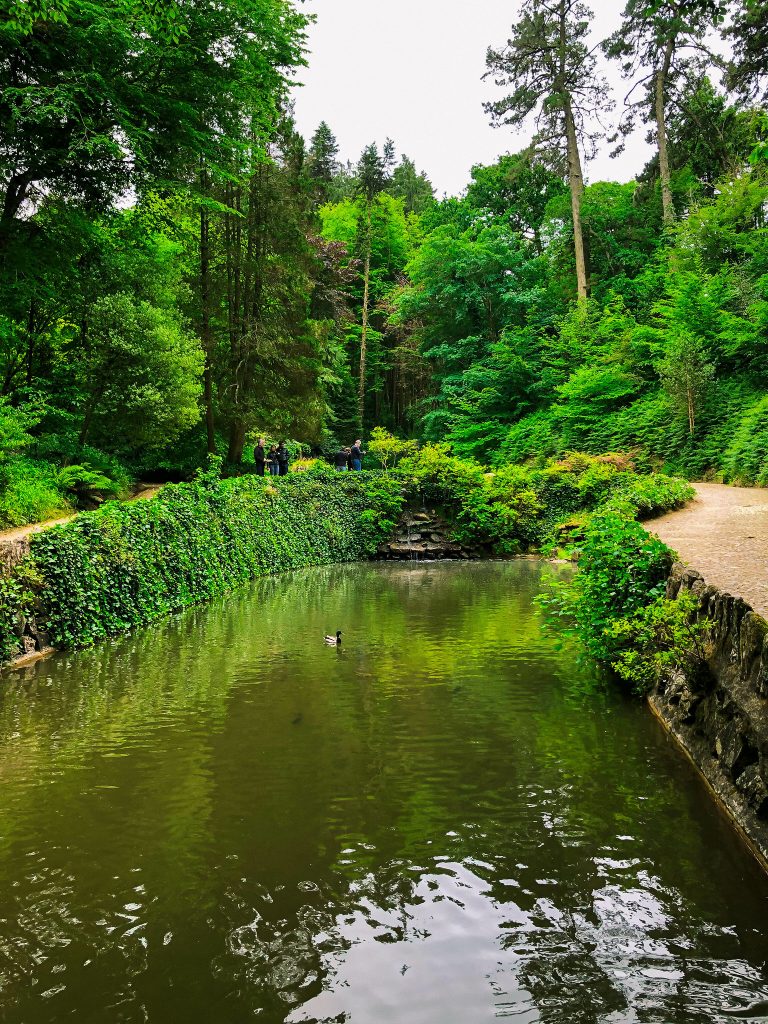
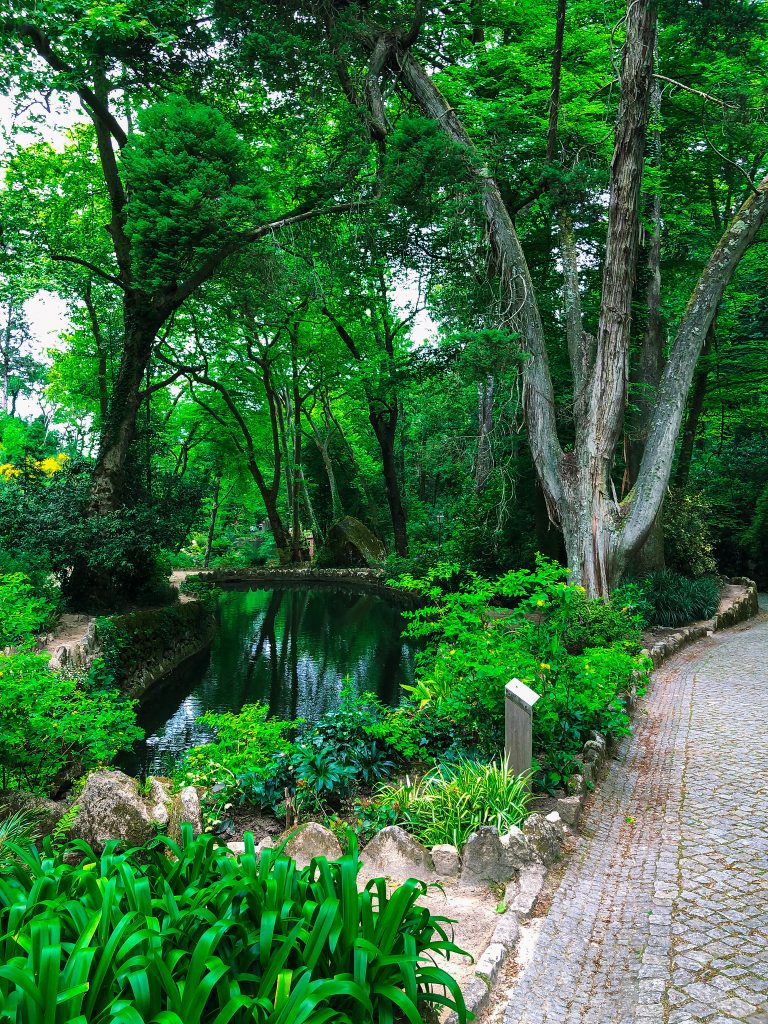
Duck Houses
One of the last things in the park to explore before you exit are the Duck Houses. These stone towers look more like minature forts, but when you look closer at their tiny doors, you might catch a glimpse of a family of ducks making their way home. These were such a delight to Ferdinand’s guests, as everyone got a good laugh out of these ducks with their very own castle, within in a castle.
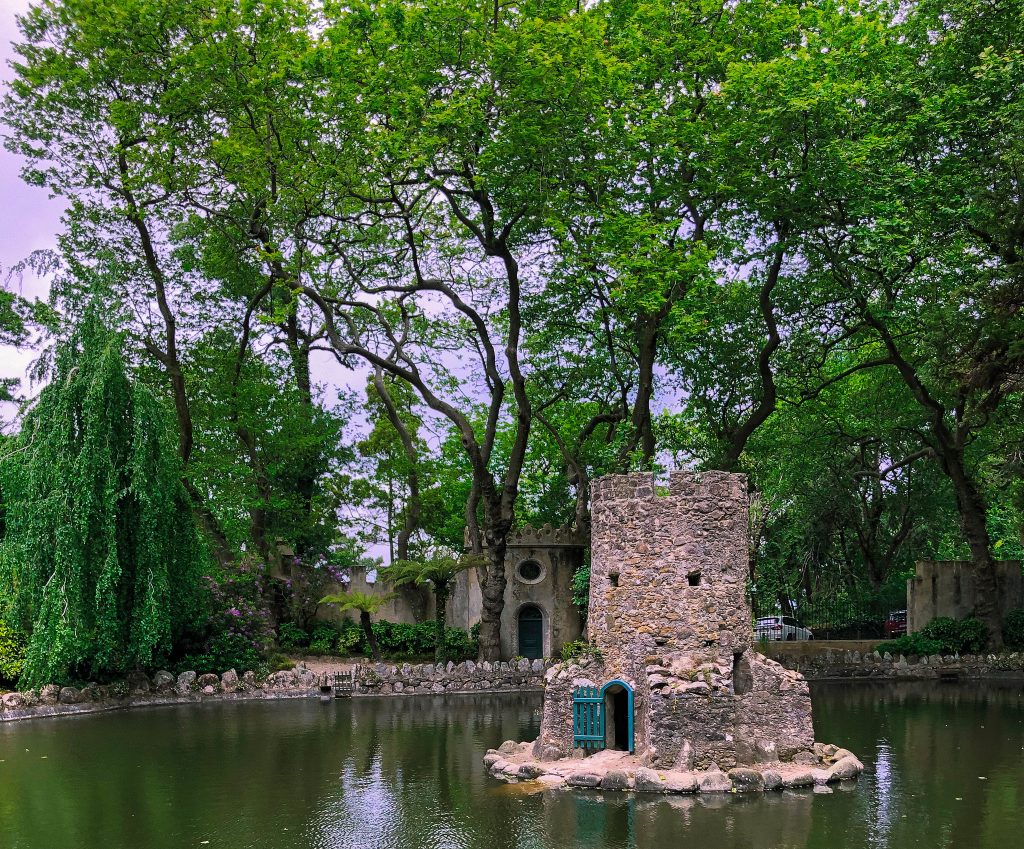
The duck houses mark the end of the tour. They are located at the official entrance to Pena Park. If you’re continuing on from here, it’s a short 10-minute walk over to the Moorish Castle, or you can hop on bus #434 to get back to Sintra station. While many people make Pena Palace a part of their day trip to Sintra, if you choose to explore the entirety of the park and spend some quality time inside the palace, you can easily dedicate an entire day to this wonderland. I hope that either way, you decide to visit this incredible site. I hope that you have a great time exploring all these secrets I’ve uncovered for you and that you share with me any new ones you discover!
Happy Travels Adventurers!
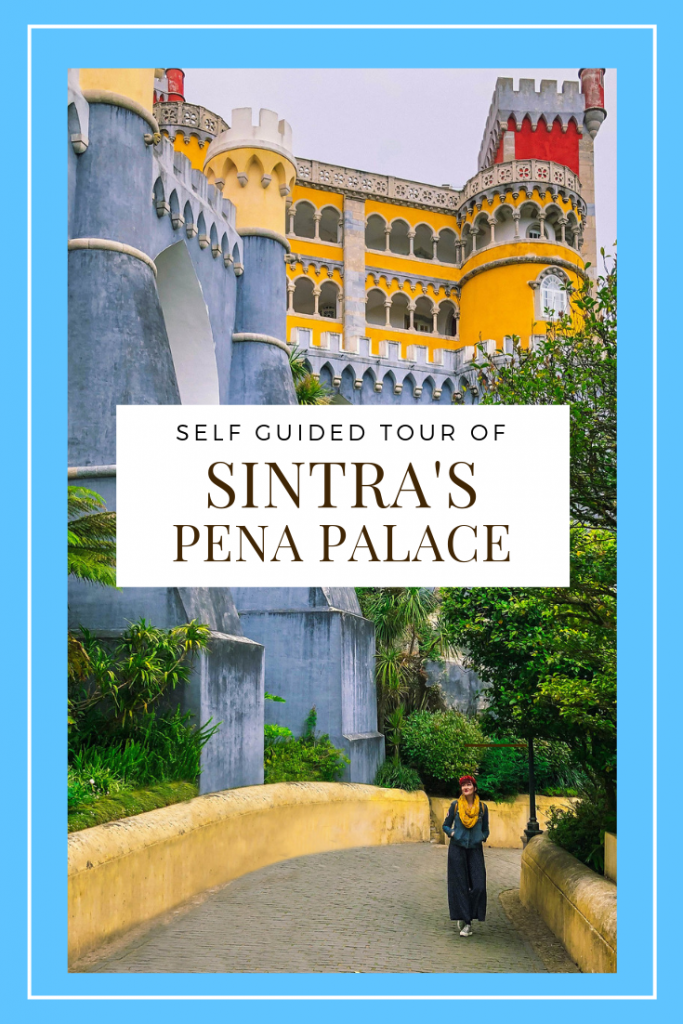
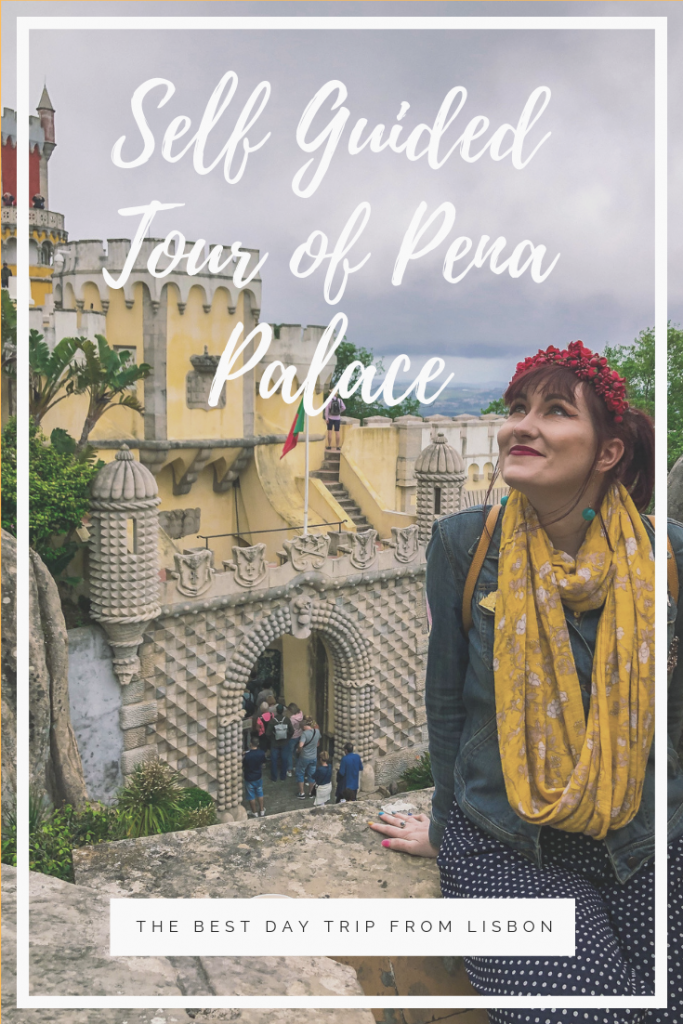
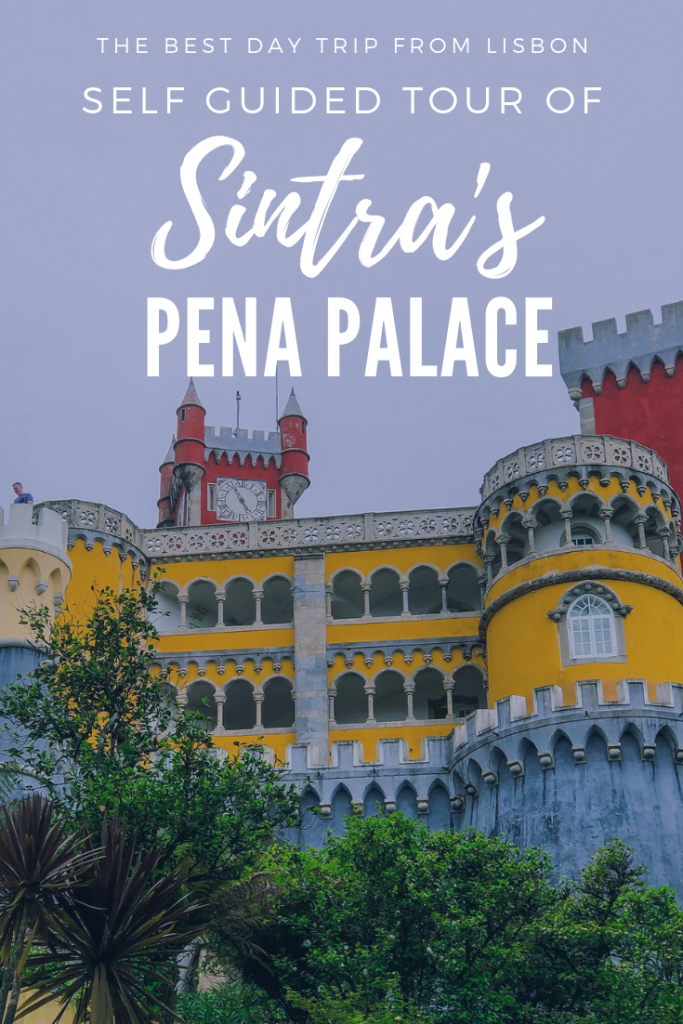

Leave a Comment
Pingback: 15 Amazing Palace and Castle Tours you can View Virtually - The Creative Adventurer on June 20, 2019

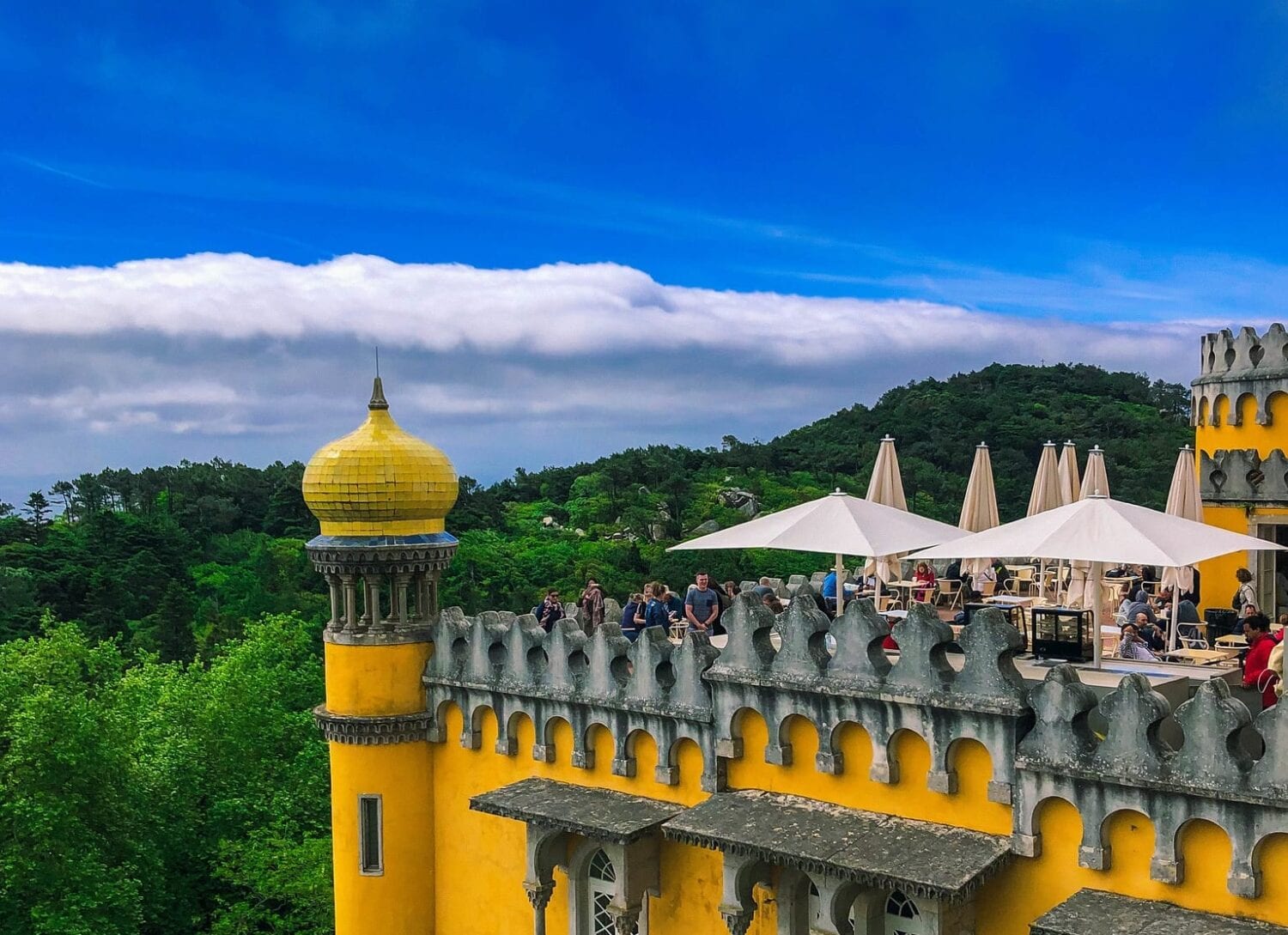
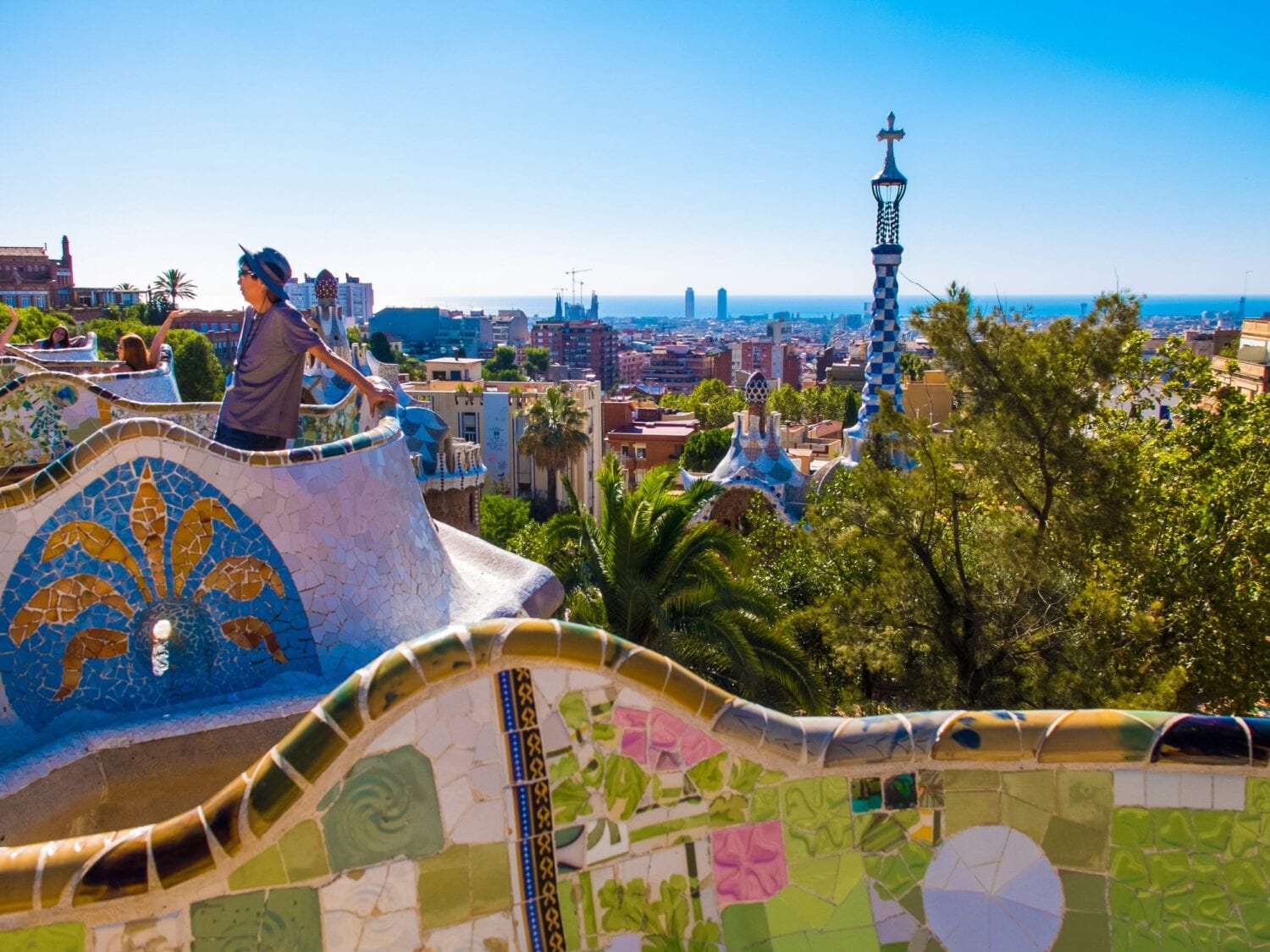
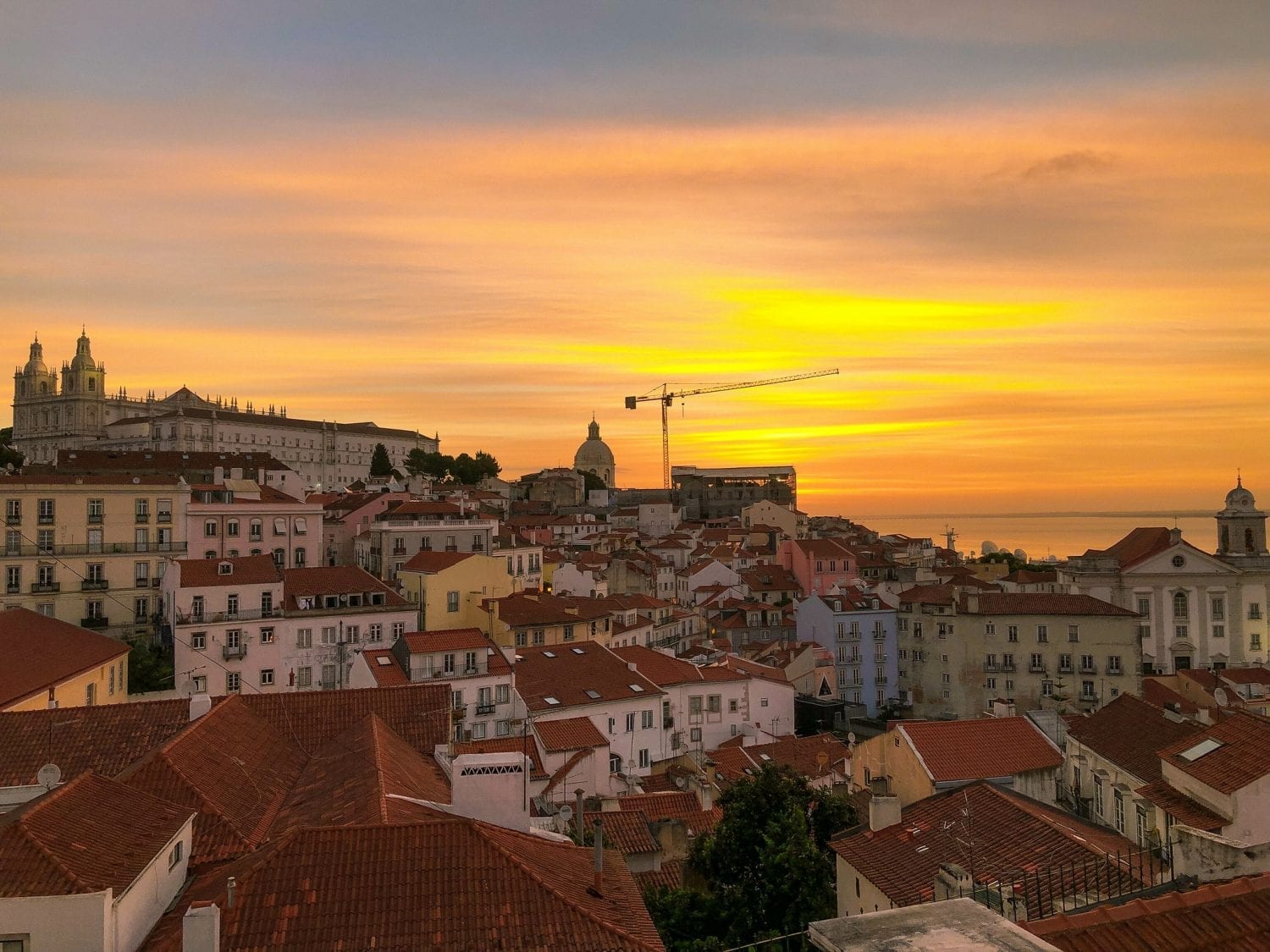
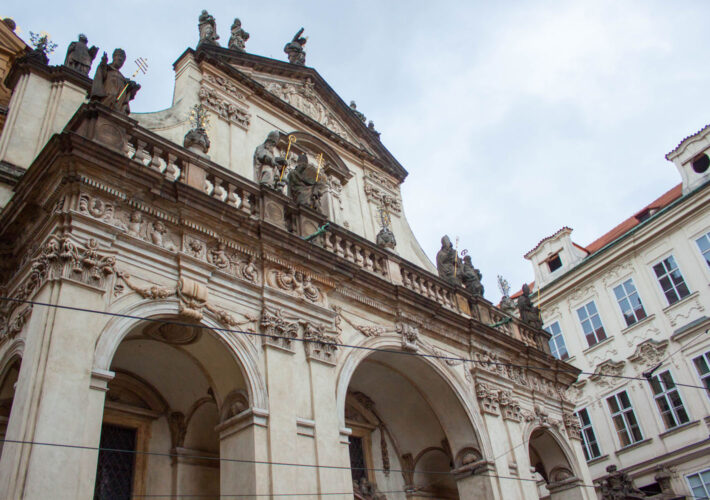
3 COMMENTS
Lorri Schreuder
2 years agoCan you tell me if it would be better to do the Pena Palace and Park around 4.30pm? We were thinking of starting down in the town doing the Quinta da Regaleira first then visiting the National Palace , having some lunch then going up to the Castle of the Moors and finally do the Pena Palace and gardens before we catch the bus down to go back to Lisbon. Just wanting to know your thoughts?
The Creative Adventurer
2 years ago AUTHORI would say closer to 4pm might be a safer bet. The doors close at 6:30pm and sometimes they start to hurry people out even earlier, and since you may have to wait in line to get inside you wouldn’t want only 1 hour to explore. But doing Pena in the afternoon is a great idea. Just give yourself enough time in case the line to get inside is long.